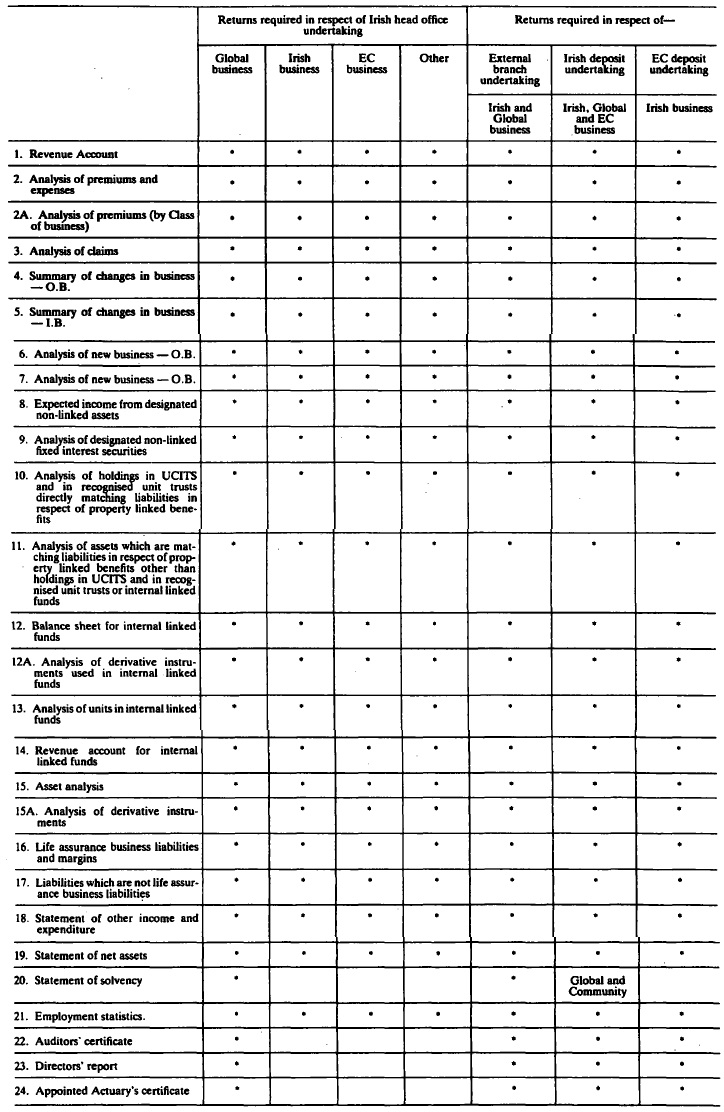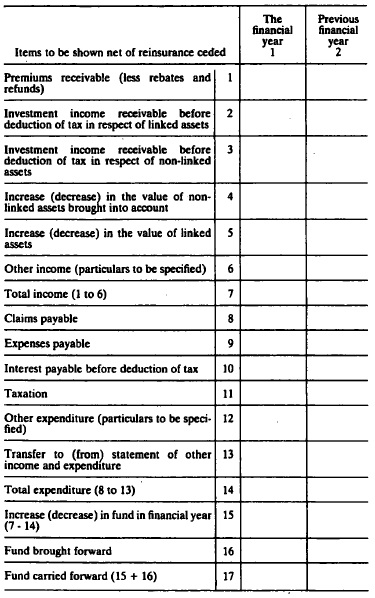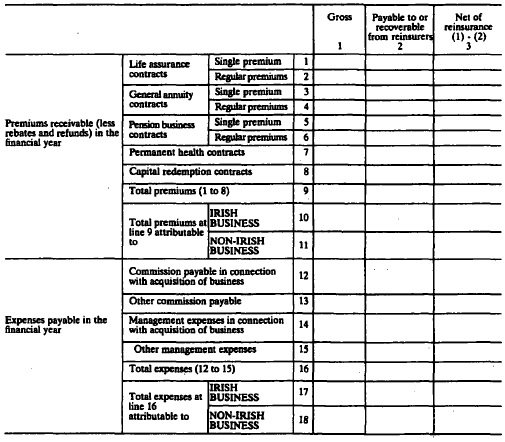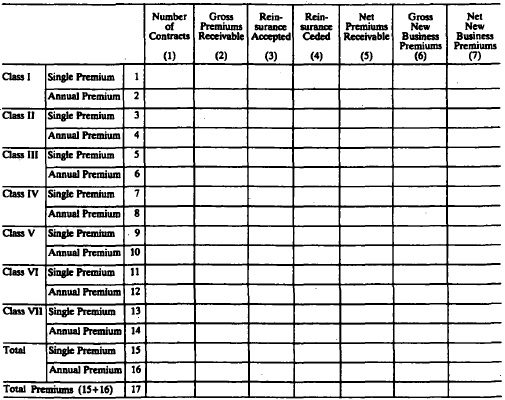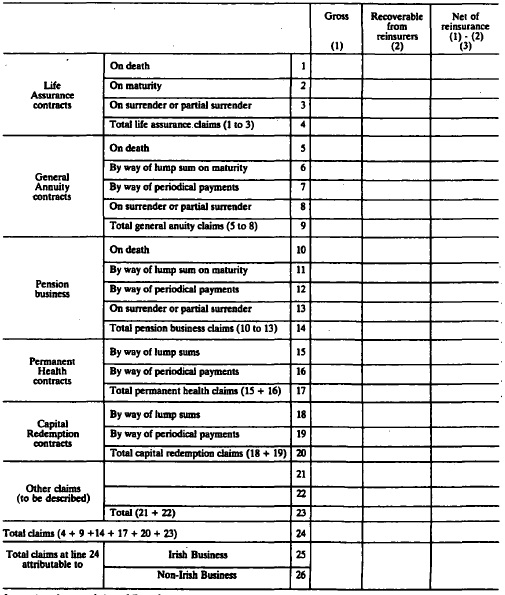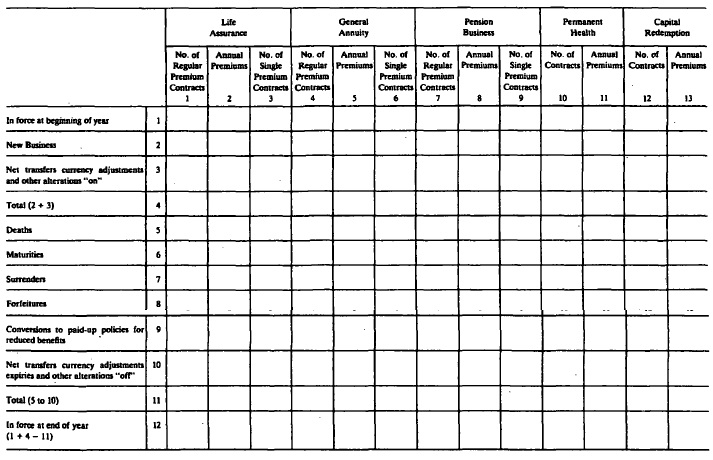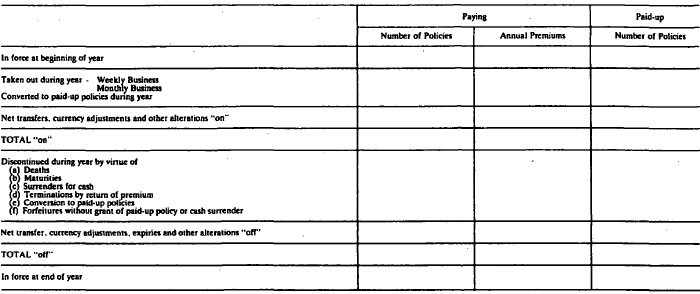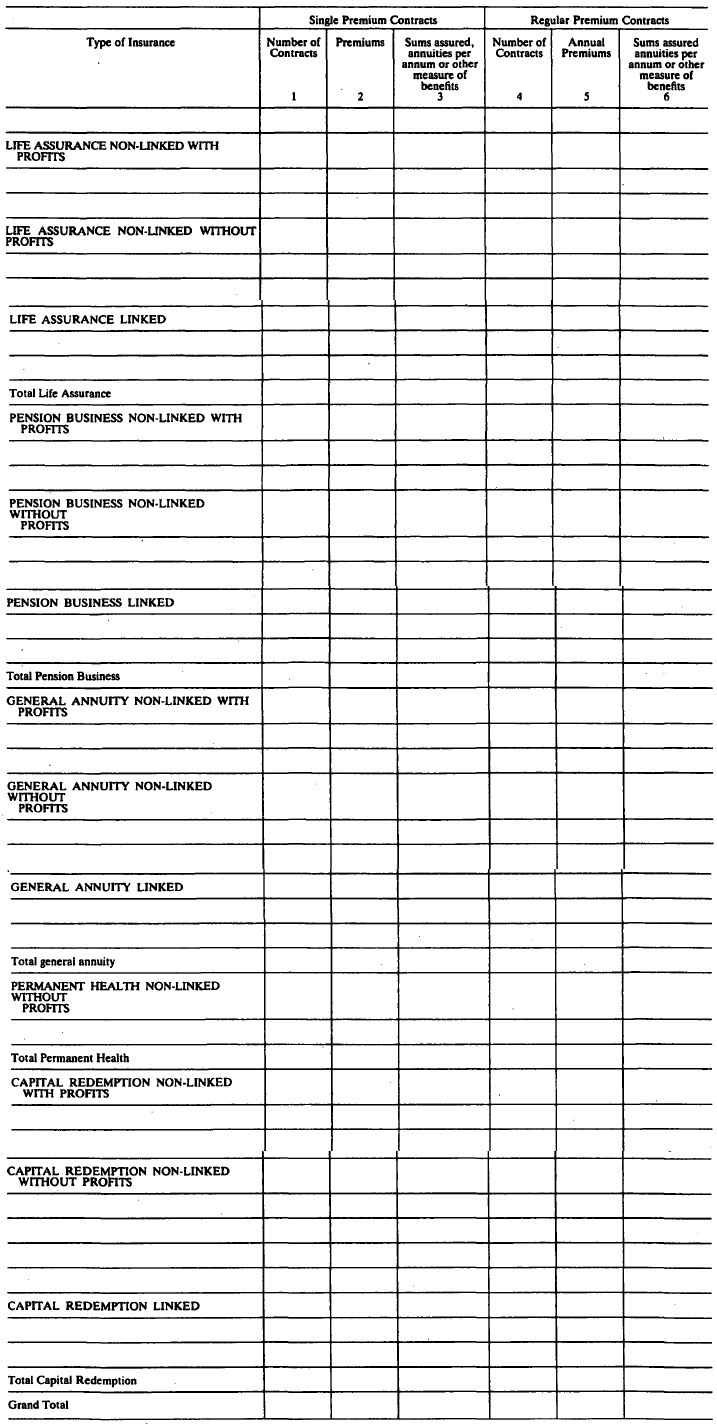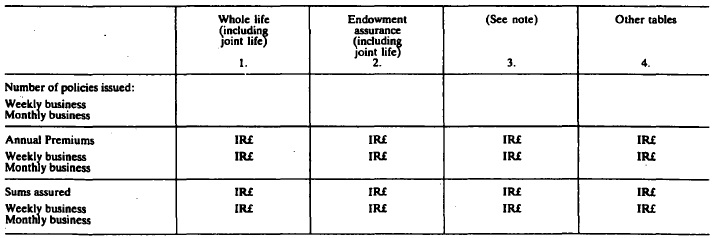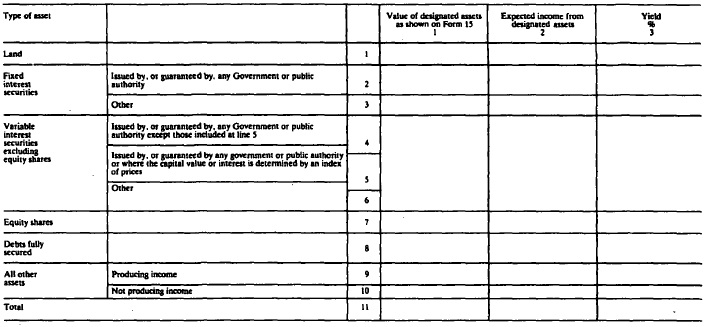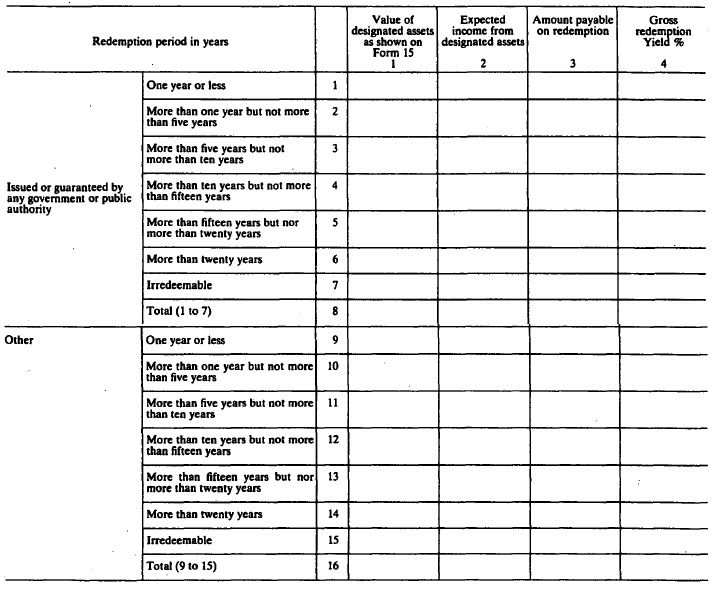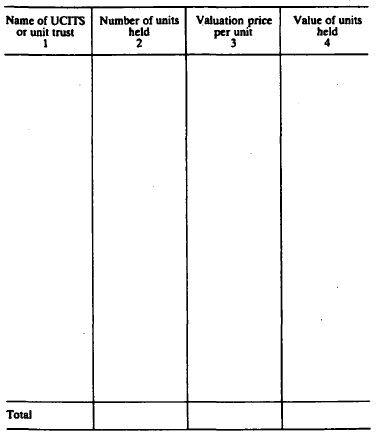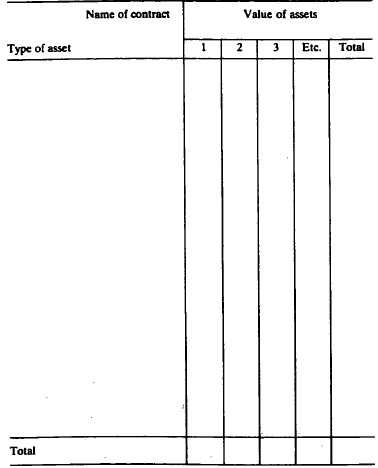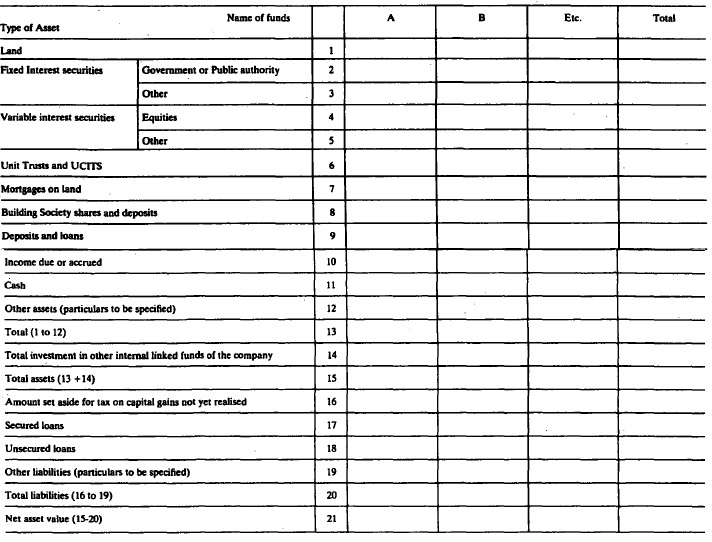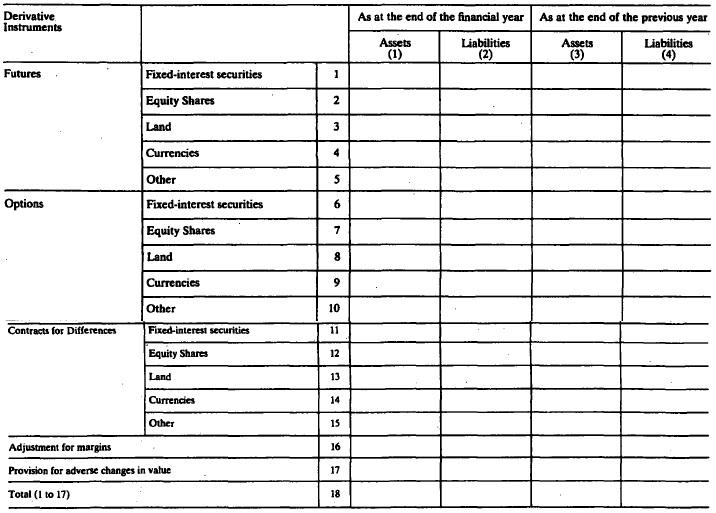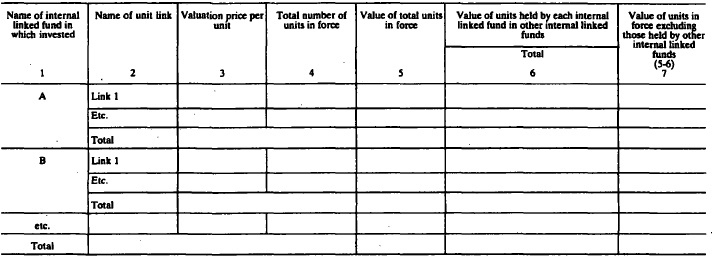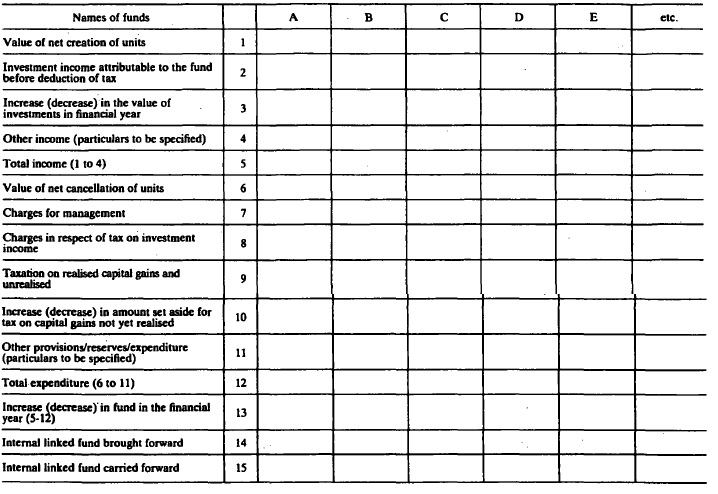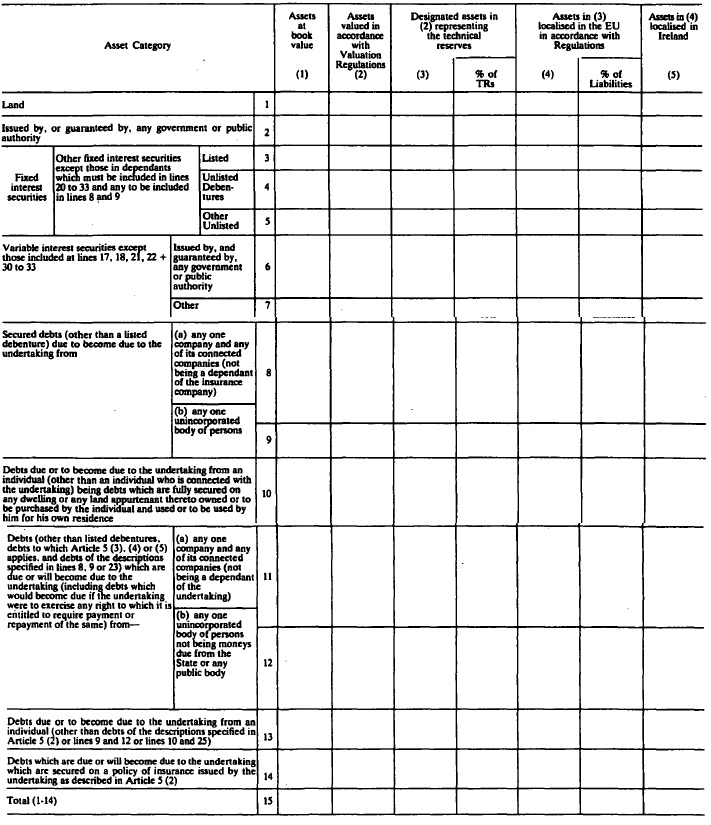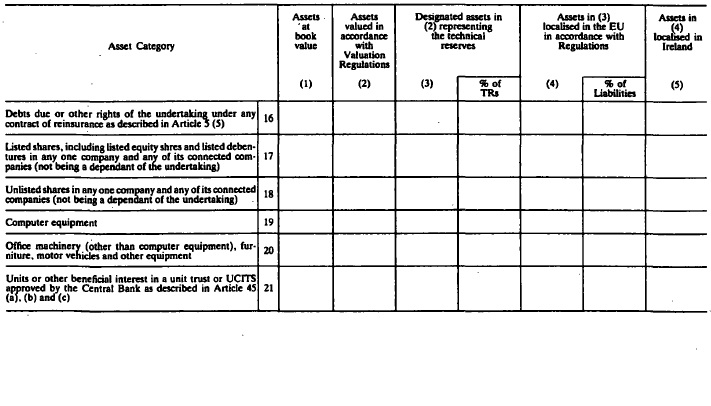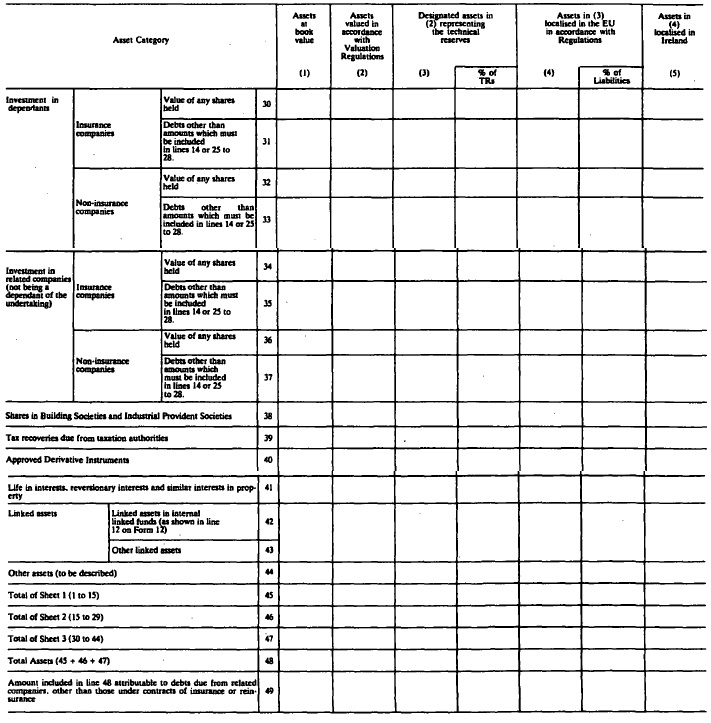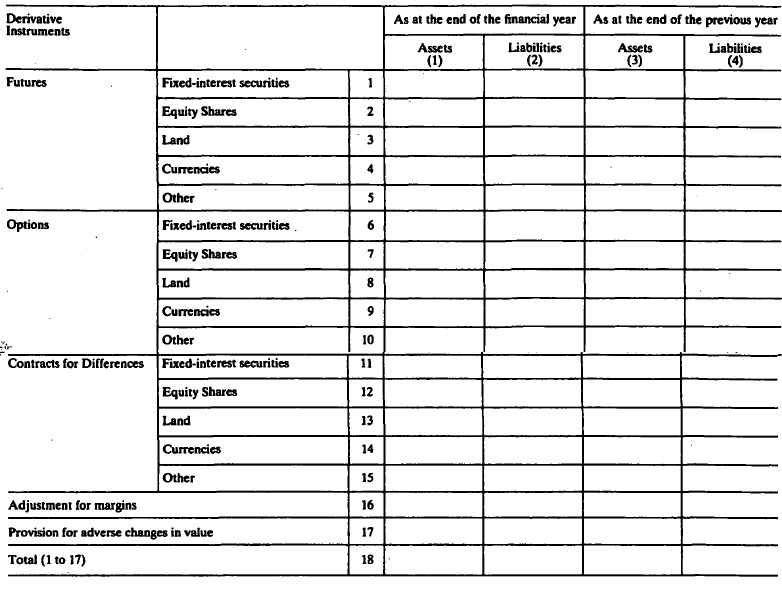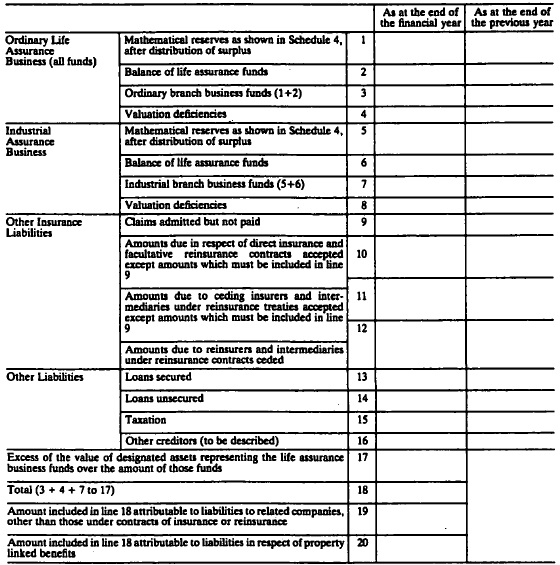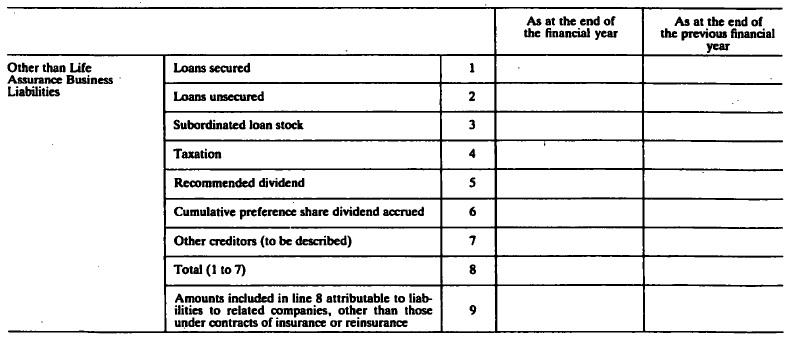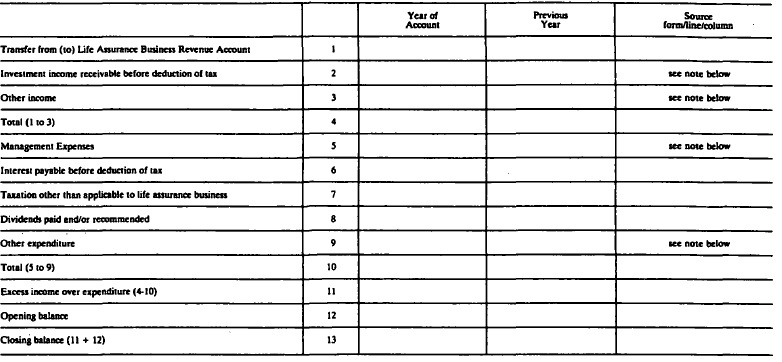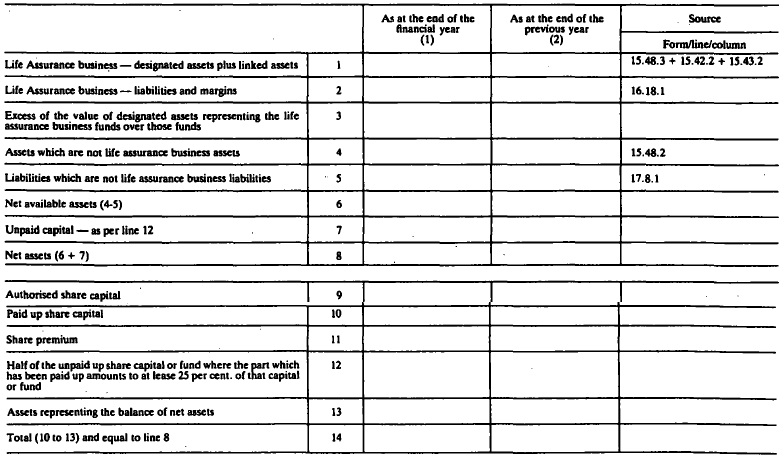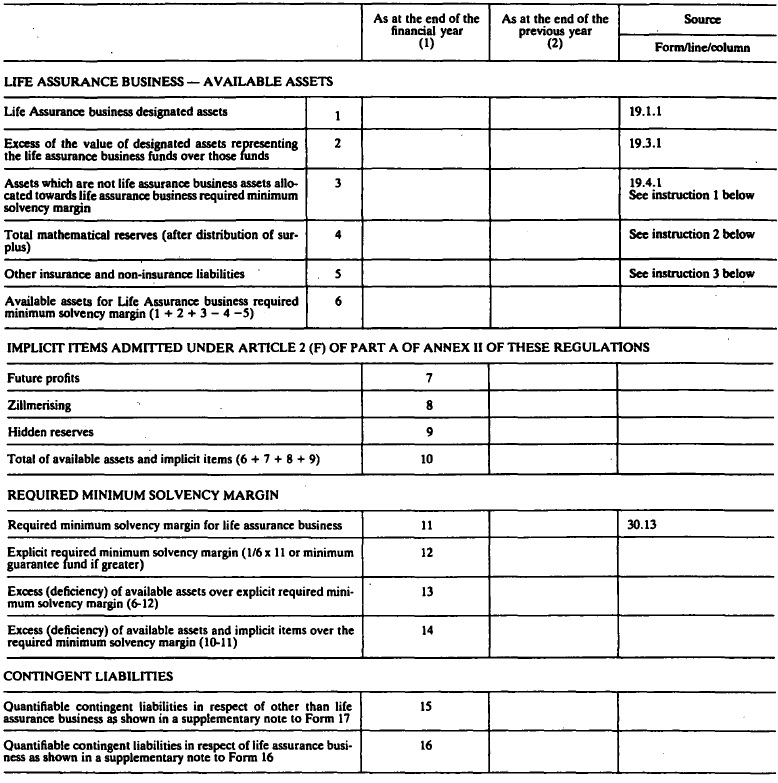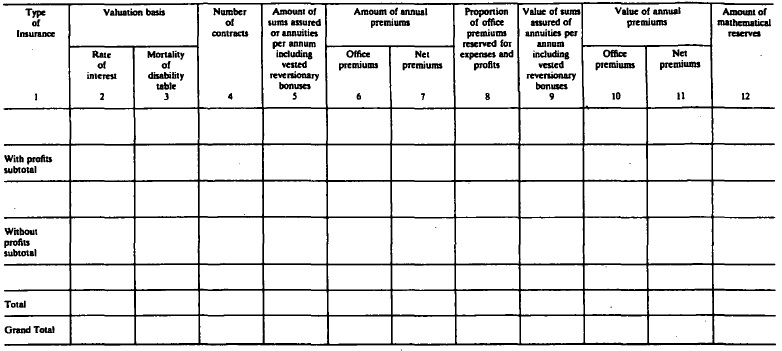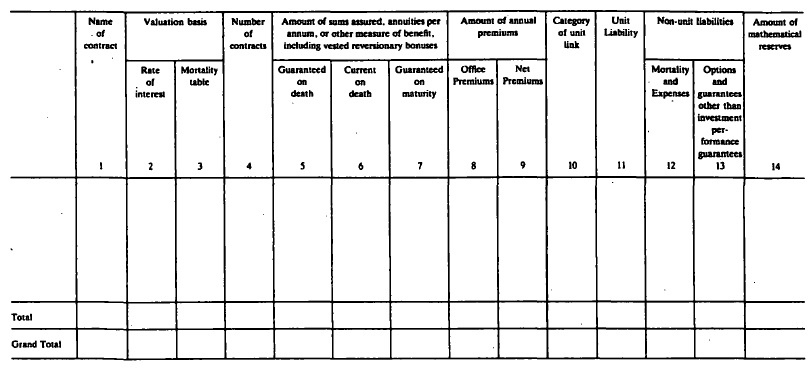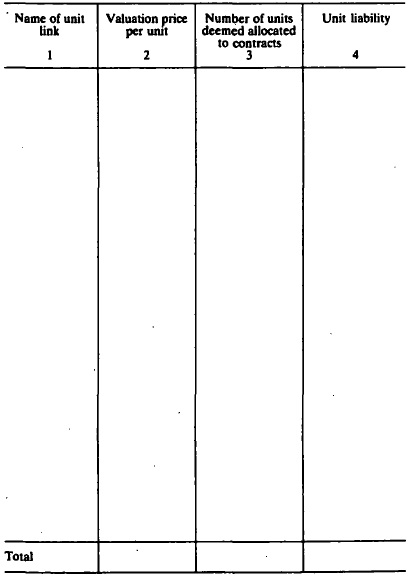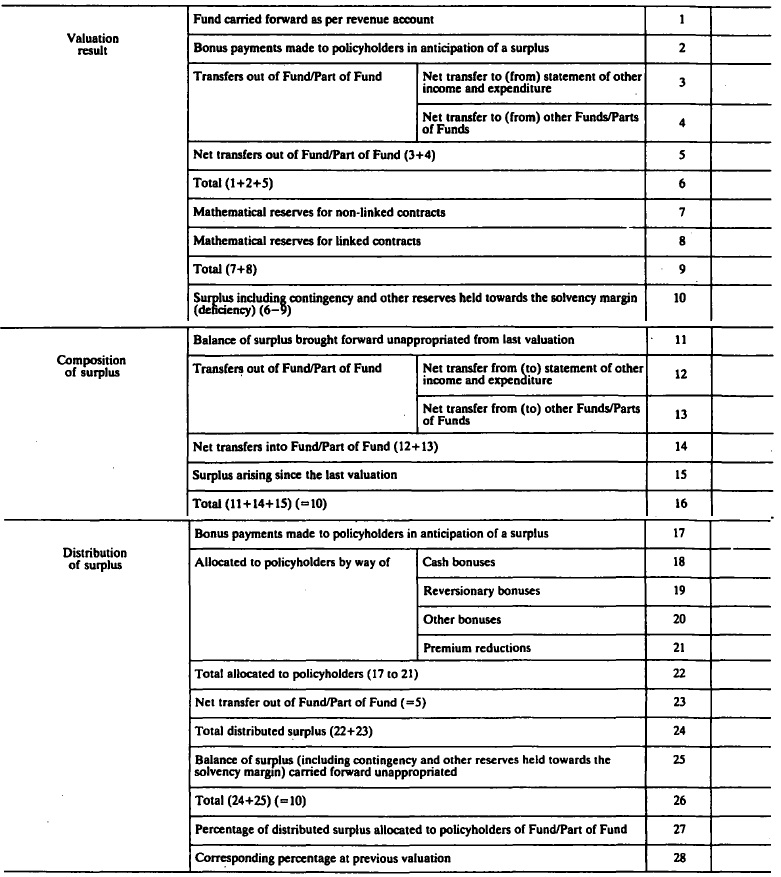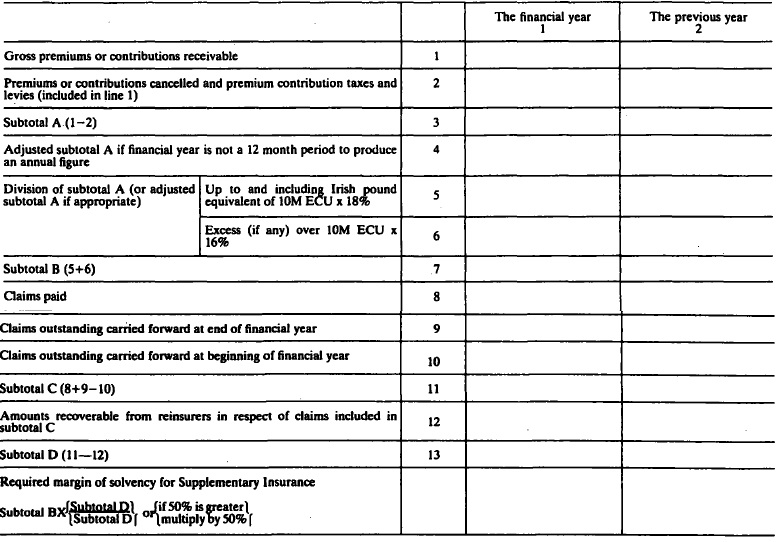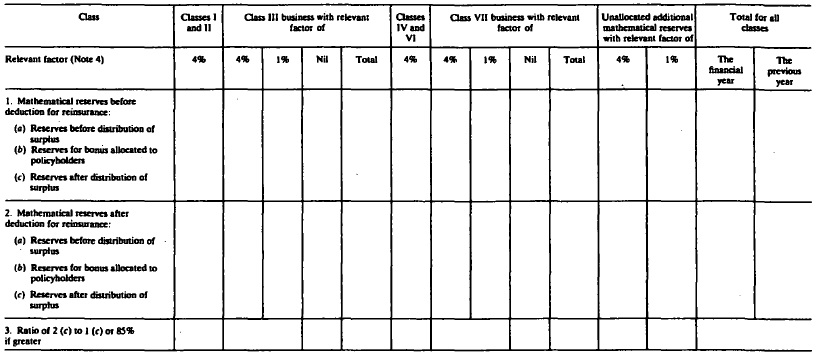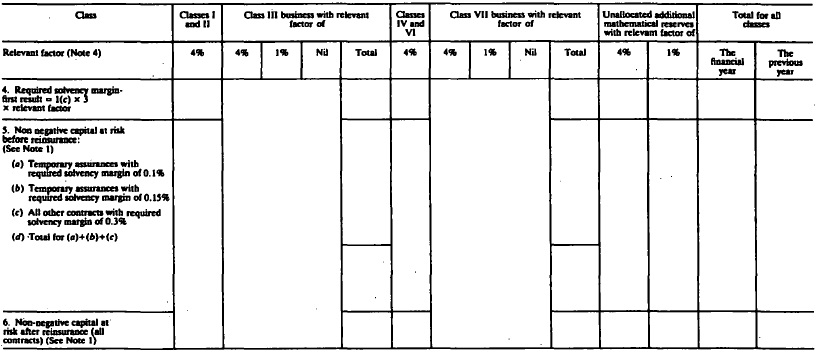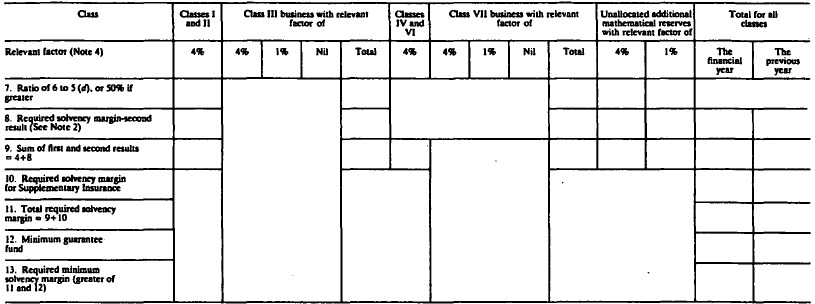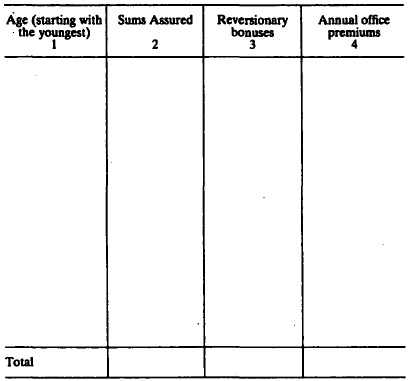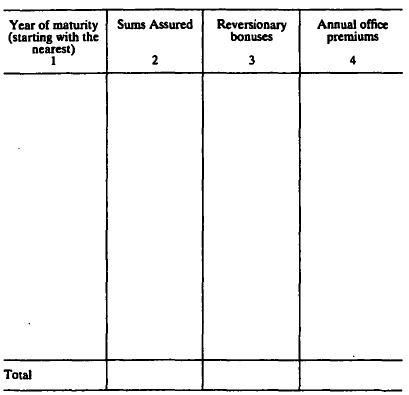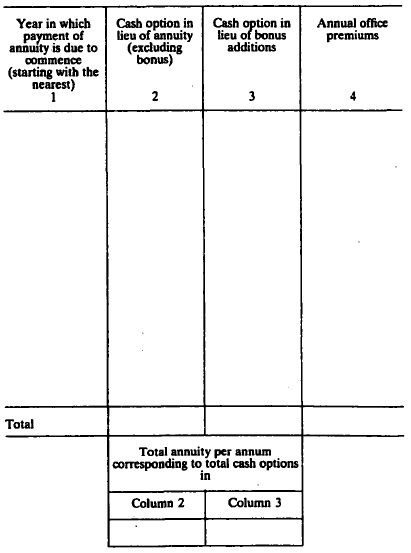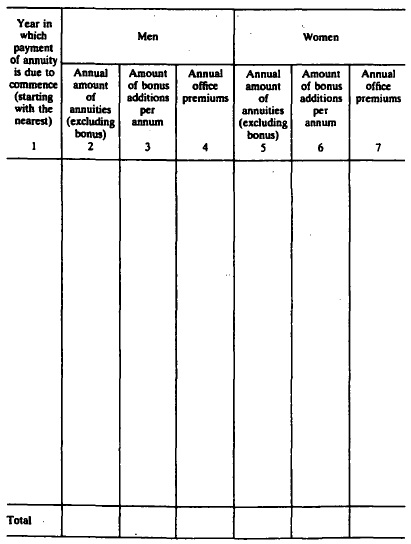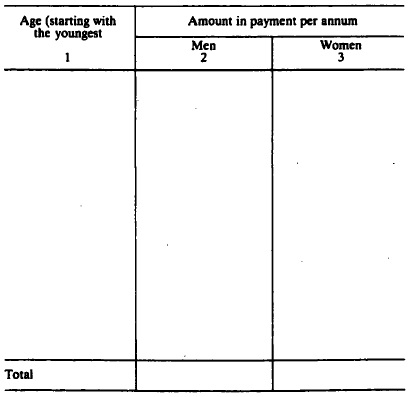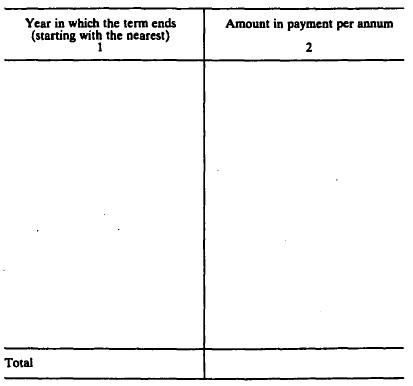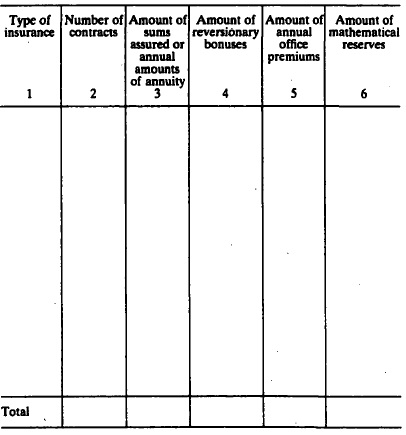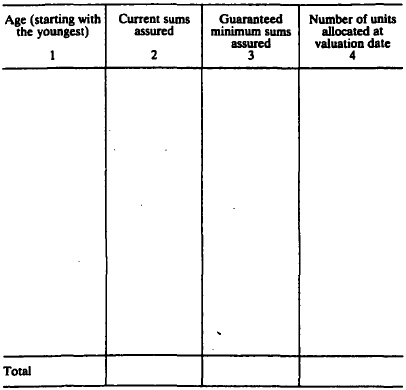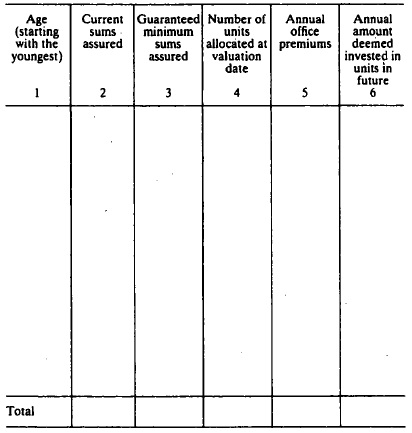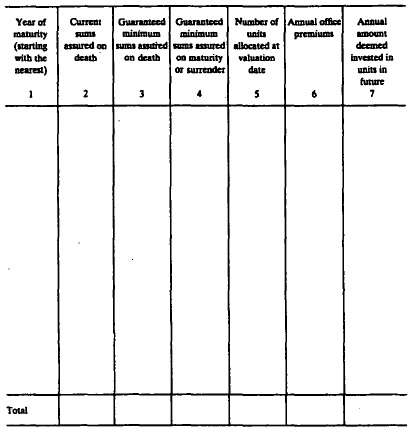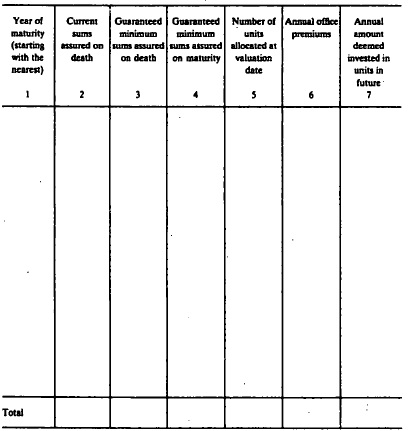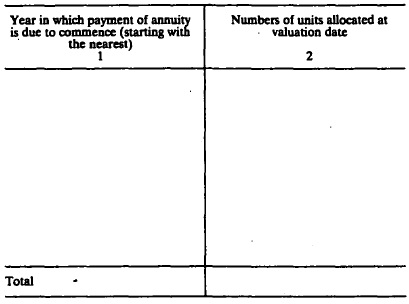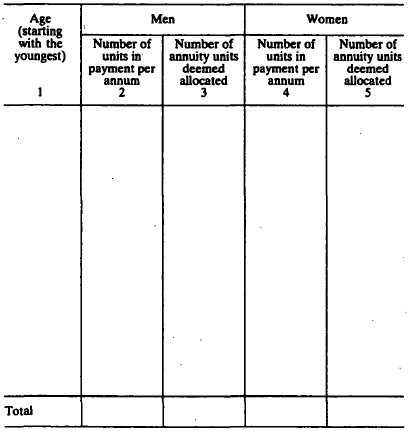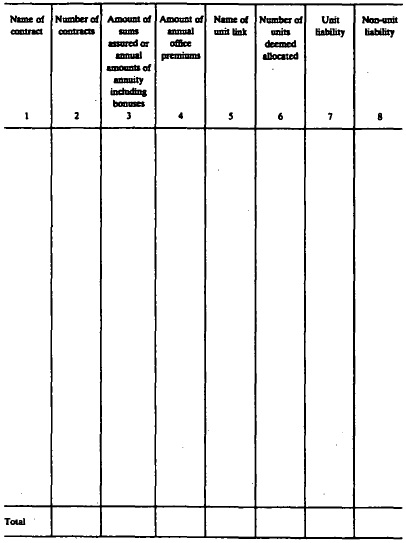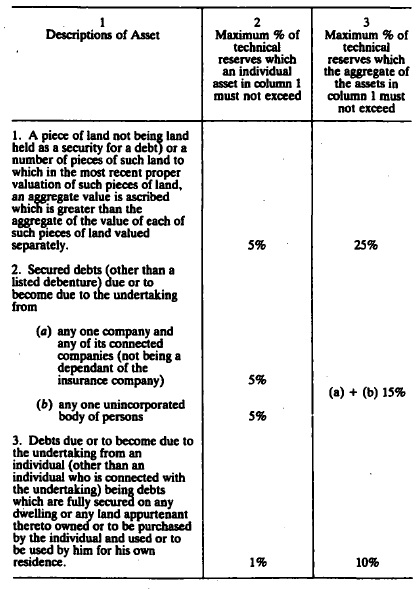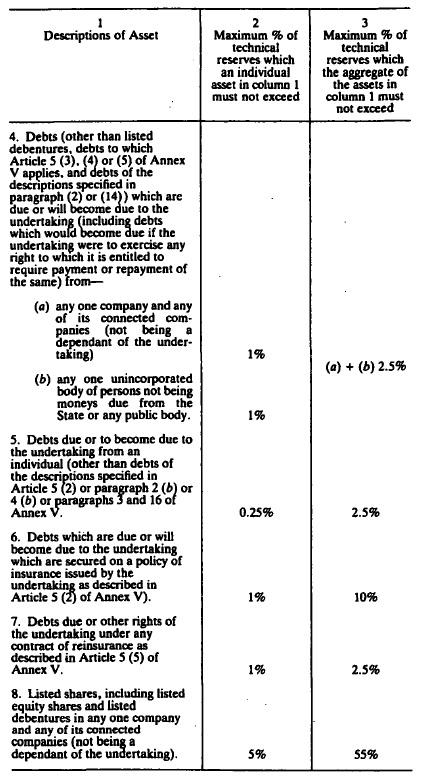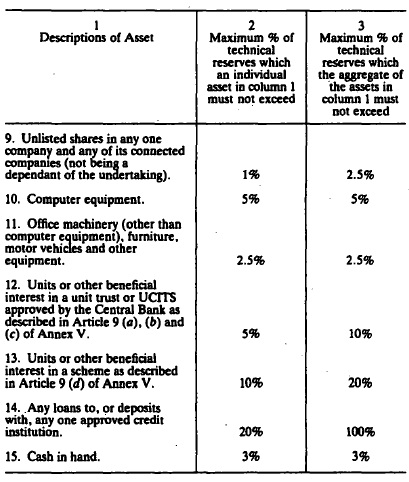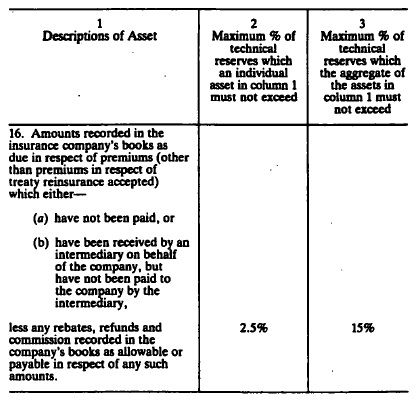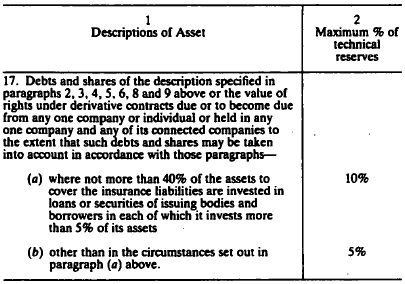S.I. No. 360/1994 - European Communities (Life Assurance) Framework Regulations, 1994.
ARRANGEMENT OF REGULATIONS | ||||||||||||||||||||
Citation and Commencement, Interpretation, Scope and Taking up the Business of Life Assurance. | ||||||||||||||||||||
Articles | ||||||||||||||||||||
Financial Supervision, Technical Reserves Provisions, Annual Returns, Accounts and Investigations, Statements, Audit and Auditor's Report, Certificates. | ||||||||||||||||||||
10. Financial supervision of insurance undertaking/transactions with a related company. | ||||||||||||||||||||
17. Accounts and returns laid before annual general meeting. | ||||||||||||||||||||
18. Modification of Insurance Acts in relation to accounts and other documents. | ||||||||||||||||||||
Assignment of Policies, Failure to Comply with Technical Reserves Provisions including Mathematical Reserves, Withdrawal/Lapse of Authorisation | ||||||||||||||||||||
36. Failure to comply with technical reserves provisions including mathematical reserves. | ||||||||||||||||||||
Qualifying Holdings, Obligation of Professional Secrecy/Exchanges of Confidential Information | ||||||||||||||||||||
41. Obligation of professional secrecy/exchanges of confidential information. | ||||||||||||||||||||
Choice of Law, General Good Requirements, Notification of Documents, Policyholder Disclosure, Cancellation Rights | ||||||||||||||||||||
Right of Establishment, Freedom to Provide Services, General Conditions, Prevention of Irregularities | ||||||||||||||||||||
46. Provisions related to right of establishment of a branch outside the State. | ||||||||||||||||||||
50. Conditions for carrying on insurance business by way of services into another Member State. | ||||||||||||||||||||
51. Conditions for carrying on insurance business by way of services into the State. | ||||||||||||||||||||
53. General conditions related to services and branch insurance business. | ||||||||||||||||||||
Advertising, Winding-up, Statistical Requirements | ||||||||||||||||||||
58. Statistical requirement regarding services and branch insurance business. | ||||||||||||||||||||
Fiscal Arrangements, Acquired Rights, Right of Appeal | ||||||||||||||||||||
Provisions Related to Branches of Third Country Insurance Undertakings, Rules Applicable to the Assignment of Third Country Branch Policies, Penalties, Fees | ||||||||||||||||||||
Reciprocity Provisions, Interpretation of Sections 93 and 94 of the Insurance Act, 1936 | ||||||||||||||||||||
80. Interpretation of Sections 93 and 94 of the Insurance Act, 1936. | ||||||||||||||||||||
ANNEXES | ||||||||||||||||||||
| ||||||||||||||||||||
SCHEDULES | ||||||||||||||||||||
| ||||||||||||||||||||
S.I. No. 360 of 1994. | ||||||||||||||||||||
EUROPEAN COMMUNITIES (LIFE ASSURANCE) FRAMEWORK REGULATIONS, 1994. | ||||||||||||||||||||
I, CHARLIE McCREEVY, Minister for Enterprise and Employment, in exercise of the powers conferred on me by section 3 of the European Communities Act, 1972 (No. 27 of 1972), as amended by the European Communities (Amendment) Act, 1993 (No. 25 of 1993), and for the purpose of giving effect to Council Directive No. 79/267/EEC of 5 March, 1979, Council Directive No. 90/619/EEC of 8 November, 1990, and Council Directive No. 92/96/EEC of 10 November, 1992, hereby make the following Regulations: | ||||||||||||||||||||
|
PART 1 Citation and Commencement, Interpretation, Scope and Taking up the Business of Life Assurance. | ||||||||||||||||||||
|
1 Citation and commencement. | 1. (1) These Regulations may be cited as the European Communities (Life Assurance) Framework Regulations, 1994, and shall come into operation on the 8th day of December, 1994. However, the provisions of these Regulations affecting the annual returns to be made to the Minister in accordance with Article 13 of these Regulations shall apply in respect of every financial year beginning on or after the 1st day of January, 1995. | |||||||||||||||||||
(2) These Regulations and the Insurance Acts, 1909 to 2990, Regulations relating to insurance business made under those Acts and Regulations made under the European Communities Act, 1972 , may be cited together as the Insurance Acts and Regulations and shall be construed together as one. | ||||||||||||||||||||
|
2 Interpretation. | 2. (1) In these Regulations, except where the context otherwise requires,— | |||||||||||||||||||
"appointed actuary" means the person appointed to act as actuary to an undertaking to carry out any function relating to the business of that undertaking which is required by the Insurance Acts and Regulations to be undertaken by an actuary, being a Fellow Member of the Society of Actuaries in Ireland; | ||||||||||||||||||||
"authorisation" means— | ||||||||||||||||||||
( a ) authorisation granted by the Minister under these Regulations or under the Regulations of 1984 and still in force, or | ||||||||||||||||||||
( b ) where the context otherwise requires, authorisation granted by the authority charged by law with the duty of supervising the activities of insurance undertakings in a Member State other than the State in accordance with Article 6 of the First Directive as inserted by Article 3 of the Directive; | ||||||||||||||||||||
"branch" means an agency or branch of an insurance undertaking or any permanent presence of an undertaking in the State even if that presence does not take the form of an agency or branch but consists merely of an office managed by the insurance undertaking's own staff or by a person who is independent but has permanent authority to act for the insurance undertaking in the same way as an agency; | ||||||||||||||||||||
"capital at risk" means the amount payable on the happening of the insured event less the mathematical reserve in respect of the relevant contracts; | ||||||||||||||||||||
"carrying on insurance business by way of establishment" means the covering of a commitment by an insurance undertaking in a Member State through a head office or branch situated in that State; | ||||||||||||||||||||
"carrying on insurance business by way of services" means the covering of a commitment by an insurance undertaking in a Member State through a head office or branch situated in another Member State; | ||||||||||||||||||||
"cede" and "cession" in relation to reinsurance, include retrocede and retrocession; | ||||||||||||||||||||
"charges for management" means amounts chargeable in respect of the management of an internal linked fund in accordance with the conditions of those contracts of insurance under which property linked benefits are linked to the value of the fund or units of the fund; | ||||||||||||||||||||
"claim" means a claim against an insurance undertaking under a contract of insurance; | ||||||||||||||||||||
"claims payable" means the amount due to be paid by an undertaking during a financial year in respect of claims whether or not paid during that year; | ||||||||||||||||||||
"commission payable" means, in relation to a financial year of an insurance undertaking, the amount, whether or not paid during that year, recorded during that year as due to intermediaries and cedents in respect of the inception, amendment or renewal of contracts of insurance; | ||||||||||||||||||||
"commitment" means a commitment represented by one of the kinds of insurance or operations referred to in Article 1 of the First Directive; | ||||||||||||||||||||
"Community deposit undertaking" means a life assurance undertaking whose head office is not situated in the territory of another Member State and whose required Community minimum solvency margin is supervised in another Member State in accordance with Article 30 of the First Directive; | ||||||||||||||||||||
"contract of insurance" includes a contract of reinsurance; | ||||||||||||||||||||
" the Court" means the High Court; | ||||||||||||||||||||
"deposit back arrangement" in relation to any contract of reinsurance means an arrangement whereby an amount is deposited by the reinsurer with the cedent; | ||||||||||||||||||||
"designated assets" has the meaning assigned to it in Article 2 (16) of Annex V to these Regulations; | ||||||||||||||||||||
"direction" means a direction issued by the Minister in accordance with Article 3; | ||||||||||||||||||||
"the Directive" means Council Directive 92/96/EEC(1); | ||||||||||||||||||||
"external branch undertaking" means a life assurance undertaking whose head office is not situated in the territory of a Member State and which is not a Community deposit undertaking or an Irish deposit undertaking; | ||||||||||||||||||||
"financial year" means, in relation to an undertaking, the period in respect of which the accounts of the undertaking are made up, whether the period is a year or not; | ||||||||||||||||||||
"the First Directive" means Council Directive 79/267/EEC(2); | ||||||||||||||||||||
"general good" shall be construed in accordance with Article 43; | ||||||||||||||||||||
"gross premiums" in relation to a financial year— | ||||||||||||||||||||
( a ) means premiums after deduction of discounts, refunds, and rebates of premium but before deduction of premiums for reinsurance ceded and of commission payable by an undertaking, and | ||||||||||||||||||||
( b ) includes premiums receivable by the undertaking under reinsurance contracts accepted by the undertaking; | ||||||||||||||||||||
"home Member State" means the Member State in which the head office of the insurance undertaking covering the commitment is situated; | ||||||||||||||||||||
"implicit items" has the meaning assigned to it in Annex VI (1) to these Regulations; | ||||||||||||||||||||
"industrial assurance business" has the meaning assigned to it by Section 3 of the Insurance Act, 1936 (No. 45 of 1936), as amended by the Insurance Act, 1989 (No. 3 of 1989); | ||||||||||||||||||||
"insurance" includes "assurance"; | ||||||||||||||||||||
"insurance broker", "insurance agent" and | ||||||||||||||||||||
(1)O.J. L360, 9.12.1992, pages 1-27. | ||||||||||||||||||||
(2)O.J. L63, 13.3.1979, page 1. | ||||||||||||||||||||
"insurance intermediary" have the meanings assigned to them in Section 2 of the Insurance Act, 1989 ; | ||||||||||||||||||||
"insurance undertaking" or "undertaking" means— | ||||||||||||||||||||
( a ) for the purpose of carrying on insurance business in the State by way of establishment, the holder of an authorisation under these Regulations or, as the case may be, the holder of an authorisation under Article 27 of the First Directive; | ||||||||||||||||||||
( b ) for the purpose of carrying on insurance business by way of services, the holder of an authorisation under these Regulations or, as the case may be, under Article 6 of the First Directive as inserted by Article 3 of the Directive; | ||||||||||||||||||||
"internal linked fund" means an account to which an insurance undertaking appropriates certain linked assets and which may be sub-divided into units the value of which is determined by the undertaking by reference to the value of those linked assets; | ||||||||||||||||||||
"Irish deposit undertaking" means a life assurance undertaking whose head office is not situated in the territory of another Member State and whose required community minimum solvency margin is supervised in the State in accordance with Article 30 of the First Directive; | ||||||||||||||||||||
"Irish head office insurance undertaking" means a life assurance undertaking whose head office is in the State; | ||||||||||||||||||||
"life assurance" means insurance of a class specified at a reference number in Part A of Annex 1 to these Regulations; | ||||||||||||||||||||
"life assurance business assets" and "life assurance business liabilities" mean respectively assets of a life assurance undertaking which are, for the time being, identified as representing the life assurance fund or funds maintained by the undertaking in respect of its life assurance business and liabilities of the insurance undertaking which are attributable to its life assurance business; | ||||||||||||||||||||
"life assurance liabilities" means liabilities of a life assurance undertaking arising under or in connection with contracts for life assurance business including liabilities arising from deposit back arrangements; | ||||||||||||||||||||
"linked assets" means life assurance business assets of an insurance undertaking which are, for the time being, identified in the records of the insurance undertaking as being assets by reference to the value of which property linked benefits are to be determined; | ||||||||||||||||||||
"linked contract" means a contract falling within Class III of life assurance business as specified in Annex I to these Regulations, and "non-linked contract" shall be construed accordingly; | ||||||||||||||||||||
"management expenses" means expenses incurred in the administration of an undertaking or its business which are not commission payable; | ||||||||||||||||||||
"mathematical reserves" means the provision made by a life assurance undertaking to cover liabilities (excluding liabilities which have fallen due and liabilities arising from deposit back arrangements) arising under or in connection with contracts for life assurance business; | ||||||||||||||||||||
"Member State" means a Member State of the European Communities; | ||||||||||||||||||||
"Member State of the branch" means the Member State in which the branch covering the commitment is situated; | ||||||||||||||||||||
"Member State of the commitment" means the Member State where the policyholder has his habitual residence, or, if the policyholder is a legal person, the Member State where the latter's establishment, to which the contract relates, is situated; | ||||||||||||||||||||
"Member State of the provision of services" means the Member State of the commitment, as defined in Article 2 (e) of the Second Directive, where the commitment is covered by an insurance undertaking or a branch situated in another Member State; | ||||||||||||||||||||
"Minister" means the Minister for Enterprise and Employment; | ||||||||||||||||||||
"permanent health contracts" means the business of effecting and carrying out contracts of insurance providing specified benefits against risks of persons becoming incapacitated in consequence of sustaining injury as a result of an accident or of an accident of a specified class or of a sickness or infirmity, being contracts that— | ||||||||||||||||||||
( a ) are expressed to be in effect for a period of not less than five years or until normal retirement age for the persons concerned, or without limit of time, and | ||||||||||||||||||||
( b ) either: | ||||||||||||||||||||
(i) are not expressed to be terminable by the insurance undertaking under the terms of the contract, or | ||||||||||||||||||||
(ii) are expressed to be so terminable only in special circumstances mentioned in the contract, | ||||||||||||||||||||
provided that the insurance is carried on by an insurance undertaking in the State which holds an authorisation granted in respect of Class IV in Annex I to these Regulations; | ||||||||||||||||||||
"person," "body," "undertaking" and "insurance undertaking" or "assurance undertaking" include any legal entity specified in Article 5 of the Directive; "premiums" includes the consideration for the granting of an annuity; | ||||||||||||||||||||
"premiums receivable" means— | ||||||||||||||||||||
( a ) in the case of a linked contract the liability under which has been valued on the basis of premiums actually received by the insurance undertaking in a financial year, the amount of premiums received in respect of that contract, and | ||||||||||||||||||||
( b ) in any other case, the premiums recorded in the insurance undertaking's books, in respect of a financial year as due to it in respect of contracts commencing in earlier financial years but not accounted for in the insurance undertaking's revenue account prior to that financial year, whether or not received by the insurance undertaking during that financial year after deducting discounts, refunds and rebates of premiums as recorded in respect of the same period; and for the purpose of determining whether a premium is due no account shall be taken of any credit arrangements made in respect thereof; | ||||||||||||||||||||
"profit and loss account" in relation to an insurance undertaking not trading for profit, means an income and expenditure account; | ||||||||||||||||||||
"property linked benefits" means benefits provided for under any contract the effecting of which constitutes the carrying on of life assurance business, and which are determined by reference to the value of, or the income from, property of any description (whether or not specified in the contract) or by reference to fluctuations in, or an index of, the value of property of any description (whether or not specified in the contract); | ||||||||||||||||||||
"receivable" in relation to income during a financial year, means, unless otherwise specified, such amounts as become due to the undertaking, whether or not received by the insurance undertaking during that year, including (where appropriate) income which has accrued; | ||||||||||||||||||||
"the Regulations of 1984" means the European Communities (Life Assurance) Regulations, 1984 ( S.I. No. 57 of 1984 ); | ||||||||||||||||||||
"the Regulations of 1986" means the European Communities (Life Assurance Accounts, Statements and Valuations) Regulations, 1986 ( S.I. No. 437 of 1986 ); | ||||||||||||||||||||
"reinsurance" includes reassurance; | ||||||||||||||||||||
"reinsurance" and "reinsurer" include retrocession and retrocessionaire, respectively; | ||||||||||||||||||||
"reinsurance premiums payable" means the premiums recorded in an insurance undertaking's books during a financial year as due by it to reinsurers in respect of reinsurance contracts commencing in the year or reinsurance contracts commencing in earlier financial years but not accounted for in the undertaking's revenue account prior to that financial year, whether or not paid by the insurance undertaking during that financial year, after deducting discounts, refunds and rebates of premiums as recorded in the same period, and for the purpose of determining whether a premium is due no account shall be taken of any credit arrangement made in respect thereof; | ||||||||||||||||||||
"required minimum solvency margin" means the greater of the appropriate required solvency margin and the amount of the appropriate minimum guarantee fund and "required Community minimum solvency margin" and "required Irish minimum solvency margin" shall be construed accordingly; | ||||||||||||||||||||
"the Second Directive" means Council Directive 90/619/EEC(3); | ||||||||||||||||||||
"supervisory authority" means, in respect of any territory, the authority charged by law with the duty of supervising the activities of undertakings in that territory; | ||||||||||||||||||||
"unit of account" means the ECU used by the European Monetary Co-operation Fund, the conversion value of which, to the currency of the State, shall be, as from 31 December of each year, the rate published in the Official Journal of the Communities for the last day of the preceding October for which conversion values of the ECU were published for the currencies of all States that were then Member States; | ||||||||||||||||||||
"the valuation date" in relation to an actuarial investigation, means the date to which the investigation relates; | ||||||||||||||||||||
"zillmerising" means the method known by the name for modifying the net premium reserve method of valuing a life assurance policy by increasing the part of the future premiums for which credit is taken so as to allow for initial expenses. | ||||||||||||||||||||
(2) In these Regulations, a reference to a Part, Article, Annex or Schedule is to a Part, Article, Annex or Schedule of these Regulations and a reference to a paragraph is to the paragraph of the Article in which the reference occurs, unless it is indicated that reference to some other provision is intended and a reference to a numbered Form is to the Form as numbered in a Schedule. | ||||||||||||||||||||
(3) O.J. L330, 29.11.1990, page 50. | ||||||||||||||||||||
(3) Subject to these Regulations, the provisions of the Insurance Acts and Regulations shall, where applicable and subject to any necessary modifications, apply to all insurance undertakings to which these Regulations relate. | ||||||||||||||||||||
(4) In these Regulations a reference to any enactment, Council Directive, order or Regulation includes reference thereto as subsequently amended. | ||||||||||||||||||||
(5) These Regulations shall have effect, any provision to the contrary in any enactment, order or Regulation passed or made before the making of these Regulations notwithstanding. | ||||||||||||||||||||
|
3 Technical adjustments. | 3. (1) The Minister may by direction give effect to any technical adjustment adopted in accordance with Article 47 of the Directive subject to such conditions as may be specified from time to time by the Minister. | |||||||||||||||||||
(2) The Minister may issue a direction in writing modifying any requirement of these Regulations or of the Annexes or Schedules in the special circumstances of the case, provided that the direction does not conflict with any provision of the First Directive, the Second Directive or the Directive. | ||||||||||||||||||||
|
4 Scope. | 4. (1) Subject to sub-article (2) of this Article, these Regulations apply to insurance business ("life assurance") of the classes specified in Part A of Annex I and to undertakings carrying on such insurance. | |||||||||||||||||||
(2) These Regulations do not apply to— | ||||||||||||||||||||
( a ) the kinds of insurance specified in Articles 2 (1) and 2 (4) of the First Directive; | ||||||||||||||||||||
( b ) the operations specified in Articles 2 (2) and 2 (3) of the First Directive; | ||||||||||||||||||||
( c ) the organisations and mutual associations excluded from the application of the First Directive by Article 3 thereof; | ||||||||||||||||||||
( d ) the bodies referred to in Article 4 of the First Directive. | ||||||||||||||||||||
|
5 Powers of Court. | 5. The Court shall have full jurisdiction to deal with any application, appeal or other proceeding before the Court in accordance with any provision of these Regulations and may for this purpose make any interim, interlocutory, mandatory, prohibitory or injunctive or ancillary order as the Court may consider necessary or appropriate for the purposes of these Regulations. | |||||||||||||||||||
|
6 Authorisation/omposite insurance undertakings. | 6. (1) An insurance undertaking shall not carry on the business of life assurance unless it is the holder of an authorisation. | |||||||||||||||||||
(2) An authorisation shall be valid throughout the Member States and shall allow an undertaking to carry on insurance business there by way of services and by way of establishment. | ||||||||||||||||||||
(3) For the purposes of the Insurance Acts and Regulations, an insurance undertaking shall be deemed to be or to have been established in the State if— | ||||||||||||||||||||
( a ) it has in the State an office which is open during normal business hours for the transaction of life assurance business for which it is authorised, and | ||||||||||||||||||||
( b ) it employs at such office persons duly qualified to carry on the business transacted and empowered to issue cover for the authorised classes and to settle claims. | ||||||||||||||||||||
(4) No insurance undertaking, whose head office is situated in the State, may be authorised to carry on both the business of life assurance and the business of non-life insurance of a class referred to in Annex I to the European Communities (Non-Life Insurance) Framework Regulations, 1994. | ||||||||||||||||||||
(5) An undertaking whose head office is situated in the State, and which has financial, commercial or administrative links with an insurance undertaking carrying on insurance of a class referred to in Annex I to the European Communities (Non-Life Insurance) Framework Regulations, 1994, shall provide the Minister, in such form as the Minister sees fit, with information relating to the arrangements under which any apportionment of expenses of management and income has been made between the insurance undertakings and the basis for such arrangements, and shall provide the Minister on request with copies of any agreement or other documents relevant to any such arrangements. | ||||||||||||||||||||
(6) The same shall be required of an insurance undertaking whose head office is situated in the State, which is the holder of an authorisation under the European Communities (Non-Life Insurance) Framework Regulations, 1994, and which has financial, commercial or administrative links with an undertaking carrying on insurance of a class referred to in Annex I to these Regulations. | ||||||||||||||||||||
(7) Where the Minister is satisfied that an undertaking, applying for an authorisation, complies with the appropriate provisions of the Insurance Acts and Regulations, the Minister shall grant that undertaking an authorisation. | ||||||||||||||||||||
(8) An application for an authorisation may be made to the Minister by— | ||||||||||||||||||||
( a ) any undertaking which has established its head office in the State, | ||||||||||||||||||||
( b ) any insurance undertaking which is the holder of an authorisation related to a particular class or classes of insurance and which proposes to extend its business to another class or classes of insurance. | ||||||||||||||||||||
(9) An authorisation shall be granted for a class of insurance mentioned at a reference number in Annex I to these Regulations and specified in the authorisation and shall relate to the entire of that class except that, where an applicant for an authorisation desires the authorisation to relate to only part of a class as listed in Annex I to these Regulations, the authorisation shall relate to that part only. | ||||||||||||||||||||
(10) An authorisation may be restricted to industrial assurance business and a body may not carry on industrial assurance business by virtue of an authorisation granted under these Regulations unless the authorisation expressly extends to such business. | ||||||||||||||||||||
(11) The forms of authorisation shall be as specified by the Minister from time to time. | ||||||||||||||||||||
|
7 Conditions when applying for authorisation. | 7. (1) Any undertaking applying for an authorisation shall comply with the following provisions: | |||||||||||||||||||
( a ) It shall be a company limited by shares, a company limited by guarantee or an unlimited company within the meaning (in each case) of the Companies Acts, 1963 to 1990, a society registered under the Industrial and Provident Societies Acts, 1893 to 1978, or a Society registered under the Friendly Societies Acts, 1896 to 1977; it may also adopt the form of a European Company (SE) when that has been established. | ||||||||||||||||||||
( b ) An undertaking set up in any public law form may apply for an authorisation provided such body has as its object insurance operations under conditions equivalent to those under which private law insurance undertakings operate. | ||||||||||||||||||||
(2) The undertaking shall also comply with the following provisions: | ||||||||||||||||||||
( a ) It shall limit its operations to the business provided for in these Regulations and to operations directly arising therefrom, to the exclusion of all other commercial business. | ||||||||||||||||||||
( b ) It shall submit to the Minister a scheme of operations, in accordance with Article 9 of the First Directive to include particulars or proof concerning— | ||||||||||||||||||||
(i) the nature of the commitments which the undertaking proposes to cover; | ||||||||||||||||||||
(ii) the guiding principles as to reassurance; | ||||||||||||||||||||
(iii) the items constituting the minimum guarantee fund; | ||||||||||||||||||||
(iv) estimates of the costs of setting up the administrative services and the organisation for securing business and the financial resources intended to meet those costs. | ||||||||||||||||||||
( c ) In addition, for the first three financial years it shall submit to the Minister— | ||||||||||||||||||||
(i) a plan setting out detailed estimates of income and expenditure in respect of direct business, reassurance acceptances and reassurance cessions; | ||||||||||||||||||||
(ii) a forecast balance sheet; | ||||||||||||||||||||
(iii) estimates relating to the financial resources intended to cover its underwriting liabilities and solvency margin. | ||||||||||||||||||||
( d ) It shall possess the minimum guarantee fund referred to in Part B of Annex II to these Regulations. | ||||||||||||||||||||
( e ) It shall be effectively run by persons of good repute with appropriate professional qualifications or experience. | ||||||||||||||||||||
(3) An insurance undertaking applying for an authorisation to extend its business to other classes of insurance or to extend an authorisation covering only part of a class as listed in Annex I to these Regulations shall— | ||||||||||||||||||||
( a ) submit to the Minister a scheme of operations in accordance with the provisions contained in Article 7 (2) (b) of these Regulations in relation to such other classes of insurance or such extension of authorisation, and | ||||||||||||||||||||
( b ) prove to the satisfaction of the Minister that it possesses the solvency margin in accordance with the provisions of Part A of Annex II to these Regulations and, the minimum guarantee fund referred to in Part B of Annex II to these Regulations. | ||||||||||||||||||||
|
8 Notification of conditions and documents. | 8. (1) Notwithstanding sub-articles (2) and (3) of this Article, the Minister shall not require the prior approval or systematic notification of general and special policy conditions, scales of premiums, technical bases used in particular for calculating scales of premiums and technical reserves, forms and other printed documents which an insurance undertaking intends to use in its dealings with policyholders. The Minister may, however, require notification of such general and special policy conditions, scales of premiums, technical bases, forms and other aforementioned printed documents. | |||||||||||||||||||
(2) The Minister may, for the sole purpose of verifying compliance with the rules concerning actuarial principles, require systematic notification of the technical bases used for calculating scales of premiums and technical reserves, provided that requirement does not constitute a prior condition for an insurance undertaking to carry on insurance business in the State. | ||||||||||||||||||||
(3) Nothing in these Regulations shall prevent the introduction by the Minister of regulations or administrative provisions concerning the approval of the memorandum and articles of association of an insurance undertaking and communication of documents necessary for the normal exercise of supervision. | ||||||||||||||||||||
|
9 Identities of shareholders. | 9. (1) The Minister shall not grant an authorisation to an undertaking before being informed of the identities of the shareholders or persons who have qualifying holdings, whether direct or indirect, in that undertaking and of the amounts of such holdings. | |||||||||||||||||||
(2) The Minister shall not grant an authorisation if, after taking into account the requirement to ensure the sound and prudent management of an undertaking, the Minister is not satisfied as to the qualifications of such shareholders or persons. | ||||||||||||||||||||
(3) The Minister may require information concerning all such shareholders or persons irrespective of the size of their holding and any person concerned shall on request furnish information to the Minister. | ||||||||||||||||||||
(4) For the purpose of this Article— | ||||||||||||||||||||
a "qualifying holding" means a direct or indirect holding in an undertaking which represents 10 per cent. or more of the capital or of the voting rights or which makes it possible to exercise a significant influence over the management of the undertaking in which a holding subsists. | ||||||||||||||||||||
|
PART 2 Financial Supervision, Technical Reserves Provisions, Annual Returns, Accounts and Investigations, Statements, Audit and Auditor's Report, Certificates | ||||||||||||||||||||
|
10 Financial supervision of insurance undertaking. | 10. (1) The financial supervision of an insurance undertaking, including the carrying on of insurance business either by way of services or through branches, shall be the sole responsibility of the home Member State. | |||||||||||||||||||
(2) Where the head office of the insurance undertaking is situated in the State the Minister shall be responsible for verification with respect to the insurance undertaking's entire business, of its state of solvency, of the establishment and maintenance of technical reserves, including mathematical reserves, in accordance with the Insurance Acts and Regulations. | ||||||||||||||||||||
(3) Every insurance undertaking shall have administrative and accounting procedures and internal control mechanisms which in the opinion of the Minister are sound and adequate. | ||||||||||||||||||||
Transactions with a related company. | ||||||||||||||||||||
(4) Prior to entering into any transaction of a material nature with a related company or companies, including, in particular, the provision of loans to and acceptance of loans from a related company or companies, an insurance undertaking shall submit to the Minister a draft copy of any contract or agreement which is to be entered into by the insurance undertaking in relation to the transaction. | ||||||||||||||||||||
(5) In this Article— | ||||||||||||||||||||
"related company" has the meaning assigned to it by Annex V to these Regulations. | ||||||||||||||||||||
|
11 On the spot verification. | 11. (1) Where an insurance undertaking whose head office is situated in the State carries on insurance business through a branch situated in another Member State, the Minister may, after having informed the supervisory authorities of the Member State of the branch, carry out on-the-spot verification of the information required to ensure the financial supervision of the insurance undertaking. | |||||||||||||||||||
(2) The supervisory authorities of the Member State of the branch may participate in such verification where the law of the Member State of the branch so allows. | ||||||||||||||||||||
(3) Where an insurance undertaking whose head office is situated in another Member State carries on insurance business through a branch situated in the State, the Minister shall, after having been informed by the supervisory authorities of that Member State, allow the supervisory authorities of the head office Member State to carry out on-the-spot verification of the information required to ensure the financial supervision of the insurance undertaking. | ||||||||||||||||||||
(4) The Minister may, in order to ensure compliance with this Article, provide for participation in such verification by the appointment of authorised officers under the Insurance Acts and Regulations. | ||||||||||||||||||||
(5) The Minister may, in addition, seek such information as required regarding insurance contracts which are effected through or held by intermediaries and any person concerned shall provide such information to the Minister. | ||||||||||||||||||||
|
12 Maintenance/etermination of technical reserves, including mathematical reserves, solvency margin, determination of liabilities, localisation of assets, currency matching, register of assets. | 12. (1) Each insurance undertaking shall establish and maintain: | |||||||||||||||||||
( a ) technical reserves, including mathematical reserves, in respect of all underwriting liabilities assumed by it, | ||||||||||||||||||||
( b ) an adequate solvency margin and guarantee fund in respect of its entire business in accordance with Annex II to these Regulations. | ||||||||||||||||||||
(2) Subject to the provisions of Annex IV to these Regulations relating to the determination of liabilities, the amount of liabilities of an insurance undertaking shall be determined in accordance with generally accepted accounting concepts, bases and policies or other generally accepted methods appropriate for insurance undertakings. | ||||||||||||||||||||
(3) In determining under sub-articles (1) and (2) of this Article the amount of liabilities of an insurance undertaking, all contingent and prospective liabilities shall be taken into account but not liabilities in respect of share capital. | ||||||||||||||||||||
(4) Each insurance undertaking shall cover its technical reserves by equivalent assets valued in accordance with the Rules set out in Annex V to these Regulations. The currency matching Rules set out in Annex VII to these Regulations shall apply to such assets, as appropriate. | ||||||||||||||||||||
(5) Detailed rules related to the localisation of assets and the maintenance of assets in relation to reinsurance arrangements are set out in Annex VII to these Regulations. | ||||||||||||||||||||
(6) Every insurance undertaking shall keep a register showing the assets representing the technical reserves, including mathematical reserves, required by these Regulations in respect of insurance business carried on in the State in each class by the insurance undertaking and shall furnish to the Minister a certificate of the value of these assets on the closing date for which the accounts and balance sheets of the insurance undertaking are furnished to the Minister, such values being those in such accounts and balance sheets. | ||||||||||||||||||||
(7) The register shall be maintained at the principal office of the insurance undertaking in the State and shall contain up-to-date details of the assets representing reserves in respect of life assurance business carried on in the State. | ||||||||||||||||||||
(8) The register shall be open for inspection by an officer or officers of the Minister during normal business hours. | ||||||||||||||||||||
|
13 Annual returns, statistical documents. | 13. (1) An insurance undertaking, whose head office is situated in the State shall furnish to the Minister annually or at such more frequent intervals as the Minister may request such information in such form and manner as the Minister may require, together with statistical documents which are deemed necessary for supervision purposes and in particular in order to verify the state of solvency of the undertaking with respect to its entire business. | |||||||||||||||||||
(2) For the purposes of sub-article (1) of this Article, the insurance undertaking shall, in addition, furnish to the Minister annually, or at such more frequent intervals as the Minister may request, such information in such form and manner as the Minister may require in order to enable the Minister to verify that the technical reserves, including mathematical reserves, mentioned in Article 12 of these Regulations are being maintained. | ||||||||||||||||||||
(3) The Minister shall provide the supervisory authority of another Member State with such information as is necessary for the purposes of supervision. | ||||||||||||||||||||
|
14 Enforcement of continued compliance with obligations | 14. The Minister shall take all appropriate measures in order to be satisfied that an insurance undertaking is complying or has the ability to continue to comply with its obligations under the Insurance Acts and Regulations and applicable administrative provisions and, in particular, with the scheme of operations referred to in Article 7 (2) (b) of these Regulations. | |||||||||||||||||||
|
15 Periodic actuarial investigations. | 15. (1) Every insurance undertaking which carries on life assurance business— | |||||||||||||||||||
( a ) shall, once in every period of twelve months, cause an investigation to be made into its financial condition in respect of that business by the person who for the time being is its appointed actuary; and | ||||||||||||||||||||
( b ) when such an investigation has been made, or when at any other time an investigation into the financial condition of the insurance undertaking has been made with a view to the distribution of profits, or the results of which are made public, shall cause an abstract of the actuary's report of the investigation to be made. | ||||||||||||||||||||
(2) An investigation to which sub-article (1) (b) of this Article relates shall include— | ||||||||||||||||||||
( a ) a valuation of the liabilities of the undertaking attributable to its life assurance business; and | ||||||||||||||||||||
( b ) a determination of any excess over those liabilities of the assets representing the fund or funds maintained by the undertaking in respect of that business and, where any rights of life assurance policyholders to participate in profits relate to particular parts of such a fund, a determination of any excess of assets over liabilities in respect of each of those parts. | ||||||||||||||||||||
(3) The Minister may require, as and when deemed appropriate, that an undertaking to which sub-article (1) of this Article applies shall prepare a statement of its life assurance business in accordance with the requirements of Schedule 5, at the date to which the accounts of the insurance undertaking are made up for the purposes of an investigation in pursuance of subparagraph (a) of that paragraph. | ||||||||||||||||||||
(4) For the purposes of any investigation to which this Article applies, the amount of any liabilities and the value of any assets shall be determined in accordance with Annex IV and V, as appropriate. | ||||||||||||||||||||
|
16 Amount of liabilities and value of assets. | 16. Unless otherwise provided in these Regulations, the amount or value given for a liability or an asset of the insurance undertaking shall be the amount or value of that liability or asset as determined in accordance with the provisions of Annex IV and V to these Regulations as appropriate. In the case of an asset of the insurance undertaking to which Annex V to these Regulations does not apply, the value given shall be the value which the asset would have if Annex V to these Regulations were applicable. | |||||||||||||||||||
|
17 Accounts and returns laid before annual general meeting. | 17. (1) Every insurance undertaking shall forward to the Minister each year two copies of the accounts and returns laid before its annual general meeting. | |||||||||||||||||||
(2) The accounts and returns referred to in sub-article (1) shall be forwarded not later than one month after the annual general meeting. | ||||||||||||||||||||
|
18 Modification of Insurance Acts in relation to accounts and other documents. | 18. The accounts, balance sheets, notes, statements, reports and certificates set out in Schedules 1 to 5 are in substitution for the accounts, balance sheets, abstracts or statements specified in the Insurance Acts, 1909 to 1990, and in the Regulations of 1986 insofar as they relate to insurance undertakings authorised or deemed to be authorised under the Regulations of 1984. | |||||||||||||||||||
|
19 Deposit of documents with Minister. | 19. (1) Every account, balance sheet, note, statement, report and certificate required to be prepared shall be printed and produced in such form or manner as the Minister may require. Five printed copies thereof shall be deposited with the Minister within six months after the close of the period to which the account, balance sheet, note, statement, report or certificate relates: provided that, if in any case it is made to appear to the Minister that the circumstances are such that a period longer than six months should be allowed, the Minister may extend that period by such period not exceeding three months as he thinks fit. | |||||||||||||||||||
(2) One of the copies of any document deposited under sub-article (1) of this Article shall be signed by the appropriate person or persons described in Article 30. | ||||||||||||||||||||
(3) The Minister shall consider the documents deposited under sub-article (1), and if any such document appears to be inaccurate or incomplete in any respect the Minister shall communicate with the undertaking with a view to the correction of any such inaccuracies and the supply of deficiencies. | ||||||||||||||||||||
(4) There shall be deposited with every revenue account and balance sheet of an insurance undertaking any report on the affairs of the insurance undertaking submitted to the shareholders or policyholders of the undertaking in respect of the financial year to which the revenue account and balance sheet relate. | ||||||||||||||||||||
(5) In these Regulations, any reference to an account or balance sheet includes a reference to any note, statement, report of certificates annexed thereto giving information authorised or required by virtue of Articles 22 to 33 of these Regulations to be so given. | ||||||||||||||||||||
|
20 Lodging of documents in Companies Office. | 20. Any document submitted to the Minister under these Regulations shall be lodged in the Companies Registration Office and shall there be open to inspection by any person, and copies of such documents may be procured by any person on payment of such fees as the Minister may from time to time fix. | |||||||||||||||||||
|
21 Laying of documents before Oireachtas. | 21. The Minister shall, as soon as may be, lay before each House of the Oireachtas copies of any documents deemed necessary to be submitted under these Regulations and may append to such documents any explanatory statement or commentary which the Minister thinks fit. | |||||||||||||||||||
|
22 Accounts and statements. | 22. Articles 22 to 33 of these Regulations apply with respect to the accounts and statements (as hereinafter specified) required to be prepared by every insurance undertaking pursuant to Article 13 of these Regulations. | |||||||||||||||||||
|
23 Annual accounts. | 23. Every insurance undertaking shall, in respect of each financial year of the insurance undertaking, prepare such of the accounts prescribed in Schedule 1 to these Regulations as are appropriate to the insurance undertaking. | |||||||||||||||||||
|
24 Contents and form of account. | 24. Every account, balance sheet, note, statement, report and certificate required to be prepared by an undertaking pursuant to Article 22 shall be prepared in the manner hereinafter specified and shall fairly state the information provided on the basis required by these Regulations. | |||||||||||||||||||
|
25 Revenue account. | 25. The revenue account required to be prepared by every insurance undertaking pursuant to Article 23 shall comply with the requirements of Schedule 2 to these Regulations and shall be in Form 1 completed (as may be appropriate) as specified in the instructions to that Form so, however, that— | |||||||||||||||||||
(i) every such insurance undertaking shall prepare a separate account in Form 1 in respect of each life assurance business fund maintained by it, and | ||||||||||||||||||||
(ii) where there is more than one fund for life assurance business or for industrial assurance business, the insurance undertaking shall also prepare a summary form for life assurance business or for industrial assurance business as the case may require. | ||||||||||||||||||||
|
26 Additional information. | 26. Every insurance undertaking shall, in accordance with Article 23 and Schedule 2 to these Regulations, including the instructions thereto, prepare— | |||||||||||||||||||
( a ) in respect of life assurance business— | ||||||||||||||||||||
(i) Forms 2 to 4 and 6, and | ||||||||||||||||||||
(ii) such of Forms 8 to 14 and 21 as are appropriate; and | ||||||||||||||||||||
( b ) in respect of industrial assurance business— | ||||||||||||||||||||
(i) Forms 2, 3, 5 and 7 to 9, and | ||||||||||||||||||||
(ii) uch of Forms 10 to 14 and 21 as are appropriate. | ||||||||||||||||||||
|
27 Profit and loss account. | 27. The profit and loss account required to be prepared by every insurance undertaking under Article 23 shall comply with the requirements of Schedule 2 to these Regulations and shall be prepared in Form 18. | |||||||||||||||||||
|
28 Balance sheet. | 28. The balance sheet required to be prepared by every insurance undertaking in accordance with Article 23, shall comply with the requirements of Schedule 2 to these Regulations and shall be in Forms 15 to 17, 19 and 20 completed (as may be appropriate) as specified in the instructions to those Forms. | |||||||||||||||||||
|
29 Periodic actuarial investigation. | 29. Save in relation to subparagraph (a) (ii) of this paragraph, for the purposes of Article 15, life assurance business and industrial assurance business shall be treated separately and— | |||||||||||||||||||
( a ) the abstract of the report of the actuary on life assurance business— | ||||||||||||||||||||
(i) shall comply with the requirements of Schedule 4 to these Regulations and shall contain the information (together with such of Forms 25 to 28 as may be appropriate) specified in that Schedule, and | ||||||||||||||||||||
(ii) except in the case of a Community deposit undertaking, shall also include Form 30 and, where appropriate, Form 29; and | ||||||||||||||||||||
( b ) the statement of life assurance business shall comply with the requirements of Schedule 5 and shall contain the information (together with Forms 31 to 44) specified in that Schedule. | ||||||||||||||||||||
|
30 Signature of documents. | 30. (1) One of the copies of any document required to be prepared in accordance with Articles 22 to 33, except an auditor's report, shall be signed by persons described in sub-articles (2) or (3). | |||||||||||||||||||
(2) In respect of any document relating to business carried on through an Irish head office undertaking, the copy shall be signed by— | ||||||||||||||||||||
( a ) in any case— | ||||||||||||||||||||
(i) where there are more than two directors of the insurance undertaking, at least two of those directors and, where there are not more than two directors, all the directors; and | ||||||||||||||||||||
(ii) the chief executive, if any, of the insurance undertaking or (if there is no chief executive) the secretary; and | ||||||||||||||||||||
( b ) in the case of an abstract or statement under Article 15, the actuary who made the investigation to which the abstract relates or by reference to which the statement was prepared. | ||||||||||||||||||||
(3) In respect of any document relating to business carried on through an agency or branch in the State by a Community deposit undertaking or an external branch undertaking or through agencies or branches in any Member State taken together by an Irish deposit undertaking, the copy shall be signed by— | ||||||||||||||||||||
( a ) in any case— | ||||||||||||||||||||
(i) the authorised agent referred to in Article 46 (2) (d) and sub-paragraph (d) of Article 65 and | ||||||||||||||||||||
(ii) an officer or employee of the insurance undertaking who, either alone or jointly with others, is responsible for the conduct of the whole of the insurance business carried on by the insurance undertaking in the State, and | ||||||||||||||||||||
( b ) in the case of an abstract or statement under Article 15, the actuary who made the investigation to which the abstract relates or by reference to which the statement was prepared. | ||||||||||||||||||||
(4) One of the copies of any auditor's report shall be a copy signed by the auditor. | ||||||||||||||||||||
|
31 Audit and auditor's report. | 31. The documents referred to in Articles 25, 26, 27 and 28 and the certificate referred to in Article 32 (a), shall be audited by a person duly qualified under the Companies Acts, 1963 to 1990, who shall make a report in Form 22 in accordance with the requirements of Part I of Schedule 3. | |||||||||||||||||||
|
32 Certificates. | 32. There shall be annexed to the documents referred to in Articles 25, 26, 27 and 28 of these Regulations: | |||||||||||||||||||
( a ) a certificate in accordance with the requirements of Part 2 of Schedule 3 and shall be in Form 23 which shall be signed by the persons required by Article 30 to sign the documents to which the certificate relates; and | ||||||||||||||||||||
( b ) a certificate in accordance with the requirements of Part 3 of Schedule 3 and shall be in Form 24 which shall be signed by the appointed actuary. | ||||||||||||||||||||
|
33 Transitional provisions. | 33. Any reference in any provision of these Regulations to a document submitted to the Minister or prepared in respect of a financial year of an insurance undertaking which is a financial year of the insurance undertaking preceding that to which these Regulations first apply shall be construed as a reference to the document so submitted or prepared in accordance with the corresponding provisions of the Insurance Acts and Regulations previously in force. | |||||||||||||||||||
|
34 General: References to Community deposit undertaking. | 34. (1) In these Regulations, any reference to life assurance business shall, in relation to a Community deposit undertaking, be taken to refer to life assurance business carried on by it through a branch in the State; and accordingly, any reference to, or requirement imposed in respect of the accounts and balance sheets (including any notes, statements, reports and certificates annexed thereto) shall be taken as referring to, or imposing the requirement in respect of business carried on through that branch. | |||||||||||||||||||
(2) In these Regulations, any reference to life assurance business shall— | ||||||||||||||||||||
( a ) in relation to an external branch undertaking, be taken to refer to its entire life assurance business and to any life assurance business carried on by it through an agency or branch in the State; and | ||||||||||||||||||||
( b ) in relation to an Irish deposit undertaking, be taken to refer to its entire life assurance business and to any life assurance business carried on by it through an agency or branch in any Member State; | ||||||||||||||||||||
and accordingly, any reference to, or requirement imposed in respect of, the accounts and balance sheets (including any notes, statements, reports and certificates annexed thereto) relevant to life assurance business shall be taken as referring to or, as the case may be, imposing the requirement in respect of— | ||||||||||||||||||||
(i) accounts prepared in respect of its entire life assurance business, and | ||||||||||||||||||||
(ii) accounts prepared in respect of the life assurance business carried on, in the case of an external branch undertaking, by the branch in the State and, in the case of an Irish deposit undertaking, by the branches in question in the Member State taken together. | ||||||||||||||||||||
|
PART 3 Assignment of Policies, Failure to Comply with Technical Reserves Provisions including Mathematical Reserves, Withdrawal/Lapse of Authorisation | ||||||||||||||||||||
|
35 Assignment of policies. | 35. (1) For the purposes of Section 13 of the AssuranceCompanies Act, 1909, and subject to the provisions of Section 36 of the Insurance Act, 1989 , and of these Regulations the following provisions shall have effect: | |||||||||||||||||||
( a ) An assurance undertaking transacting business in the State, proposing to assign all or part of its portfolio of insurance contracts concluded under the right of establishment or freedom to provide service in the State to an insurance undertaking established in the territory of a Member State may apply to the Court, by petition, for an order sanctioning the scheme of assignment. | ||||||||||||||||||||
( b ) An insurance undertaking whose head office is situated in the State may, after prior consultation with the Minister, assign all or part of its portfolio of insurance policies including insurance business carried on either by way of services or establishment, to an insurance undertaking established in the State or in another Member State. The assignment shall not be effected unless the supervisory authorities of that insurance undertaking or, where appropriate, the supervisory authorities of the Member State referred to in Article 30 of the first Directive, certify that the insurance undertaking possesses the necessary solvency margin after taking the assignment into account. | ||||||||||||||||||||
( c ) Where a branch, established in another Member State, whose head office is situated in the State, proposes to assign all or part of its portfolio of insurance policies covering insurance business carried on either by way of services or establishment, the Minister shall consult the supervisory authority of the Member State of the branch. | ||||||||||||||||||||
( d ) An insurance undertaking whose head office is situated in the State may not assign all or part of its portfolio of insurance policies to an undertaking, established in another Member State, whose head office is not situated in the territory of a Member State. | ||||||||||||||||||||
(2) ( a ) In the cases referred to in paragraph (b) and (c) of sub-article (1) of this Article, the assignment shall not be effected without obtaining the agreement of the supervisory authorities of the Member States of the branch and the supervisory authorities of the Member States of the commitment. | ||||||||||||||||||||
( b ) Where the supervisory authorities have not given a response indicating consent to or an opinion on the proposed assignment within three months of receiving notification of the assignment, the assignment shall be deemed to be agreed. | ||||||||||||||||||||
(3) Where the Minister is consulted in accordance with Article 11 (3) or (4) of the Directive, the Minister shall have a period of three months from the date of consultation by the supervisory authorities of the home Member State within which to issue a response to those authorities. | ||||||||||||||||||||
(4) Where the Minister has not given a response indicating consent to or an opinion on the proposed assignment at the expiry of the period referred to in sub-article (3) of this Article, the assignment shall be deemed to be agreed. | ||||||||||||||||||||
(5) An assignment effected in accordance with this Article shall be published subject to the provisions of sub-article (1) of this Article by advertisement once in Iris Oifigiúil and once in each of two daily newspapers published in the State and published in the Member State where the risk is situated in accordance with the law of that Member State. | ||||||||||||||||||||
(6) An assignment effected in accordance with this Article shall be valid against the policyholders, the insured persons and any other person having rights and obligations arising out of the policies assigned. | ||||||||||||||||||||
|
36 Failure to comply with technical reserves provisions including mathematical reserves. | 36. (1) Where an insurance undertaking whose head office is situated in the State fails to comply with Article 12 of these Regulations the Minister may, after notifying the supervisory authorities of the Member States in which the commitments underwritten by the insurance undertaking are situated, apply to the Court for an order, which the Court is empowered to make, prohibiting the free disposal of the insurance undertaking's assets. | |||||||||||||||||||
(2) Where the solvency margin of an insurance undertaking whose head office is situated in the State falls below the minimum amount required in accordance with the provisions of sub-article 2 (ii) of Article 7 of these Regulations the Minister shall require that a plan be submitted by the insurance undertaking for the Minister's approval for the restoration of a sound financial position. | ||||||||||||||||||||
(3) In a case referred to in sub-article (2) of this Article, where it appears to the Minister that the financial situation of the insurance undertaking will deteriorate further, the Minister may apply to the Court for an order, which the Court is empowered to make, restricting or prohibiting the free disposal of the insurance undertaking's assets. In that case, the Minister shall notify the supervisory authorities of the Member States where the insurance undertaking carries on insurance business of this fact and of any order of the Court. The Minister may also request the supervisory authorities of those Member States to take the same measures pursuant to this sub-article. | ||||||||||||||||||||
(4) Where the solvency margin of an insurance undertaking whose head office is situated in the State falls below the guarantee fund referred to in Part B of Annex II to these Regulations, the Minister shall require the insurance undertaking to submit for approval a short-term finance scheme. The Minister may also apply to the Court for an order, which the Court is empowered to make, restricting or prohibiting the free disposal of the assets of the insurance undertaking. In that case, the Minister shall notify the supervisory authorities of the Member States where the insurance undertaking carries on insurance business of this fact and of any order of the Court. The Minister may also request the supervisory authorities of those Member States to take the same measures pursuant to this sub-article. | ||||||||||||||||||||
(5) The Minister may apply to the Court for such further orders as may be necessary in order to safeguard the interests of insured persons, in the cases referred to in sub-articles (1) to (4) of this Article. | ||||||||||||||||||||
(6) Where the head office supervisory authority of an insurance undertaking situated in another Member State requests the Minister to take measures related to the restriction or prohibition of the free disposal of the assets located in the State of the insurance undertaking, the Minister may apply to the Court for an order, which the Court is empowered to make, restricting or prohibiting the free disposal of the assets located in the State of the insurance undertaking. | ||||||||||||||||||||
(7) The Court may make such order for the purposes of this Article as the Court may think fit. | ||||||||||||||||||||
|
37 Withdrawal/lapse of authorisation. | 37. An authorisation held by an undertaking whose head office is situated in the State may be revoked by the Minister if the Minister is satisfied that the holder— | |||||||||||||||||||
( a ) has not used the authorisation for the last twelve months, has expressly renounced the authorisation or has ceased to carry on business covered by the authorisation for more than six months, | ||||||||||||||||||||
( b ) no longer fulfils the conditions required by the Insurance Acts and Regulations for the granting of an authorisation, | ||||||||||||||||||||
( c ) has been unable, within the time allowed, to take the measures contained in the restoration plan or finance scheme referred to in Article 36 of these Regulations, or | ||||||||||||||||||||
( d ) fails seriously in its obligations under the Insurance Acts and Regulations. | ||||||||||||||||||||
|
38 Provisions applying in the case of revocation. | 38. Where an authorisation is revoked under Article 37 of these Regulations the following provisions shall apply:— | |||||||||||||||||||
( a ) the Minister shall notify the revocation to the supervisory authorities of the other Member States in which the undertaking carries on business; | ||||||||||||||||||||
( b ) the Minister shall, in conjunction with the supervisory authorities of the other Member States in which the undertaking carries on business, apply to the Court for an order, which the Court is empowered to make, restricting the free disposal by the undertaking of its assets in accordance with Articles 36 (1), 36 (3) and 36 (4) of these Regulations; | ||||||||||||||||||||
( c ) the Minister may take further necessary measures to safeguard the interests of persons insured by the insurance undertaking and may for this purpose apply to this Court for such order as to the Court may seem fit. | ||||||||||||||||||||
|
39 Reasons for revocation. | 39. Any decision to revoke an authorisation under Article 37 of these Regulations shall be supported by precise reasons and notified to the insurance undertaking in question. | |||||||||||||||||||
|
PART 4 Qualifying Holdings, Obligation of Professional Secrecy/Exchanges of Confidential Information | ||||||||||||||||||||
|
40 Qualifying holdings. | 40. (1) Notwithstanding the provisions of the Companies Acts, 1963 to 1990, any person who proposes to acquire, either directly or indirectly, a qualifying holding in an insurance undertaking, shall first notify the Minister indicating the size of the proposed qualifying holding. Such person shall, in addition, be under an obligation to notify the Minister where it is proposed to increase such qualifying holding so that the percentage level of the voting rights or capital which that person holds reaches or exceeds any of the percentage levels referred to in sub-article (5) of this Article so that the insurance undertaking would become that person's subsidiary. | |||||||||||||||||||
(2) The Minister shall have a period of three months from the date of notification referred to in sub-article (1) of this Article within which to oppose the proposed acquisition where, in view of the necessity to ensure sound and prudent management of the insurance undertaking in question, the Minister is not satisfied as to the suitability of the person referred to in sub-article (1) of this Article. | ||||||||||||||||||||
(3) Any person who proposes to dispose either directly or indirectly of a qualifying holding in an insurance undertaking, shall first notify the Minister indicating the size of the proposed qualifying holding. Such person shall, in addition, be under an obligation to notify the Minister if it is proposed to decrease such qualifying holding so that any of the percentage levels of the voting rights or capital which that person holds falls below the percentage levels referred to in sub-article (4) of this Article or so that the insurance undertaking would cease to be that person's subsidiary. | ||||||||||||||||||||
(4) The percentage levels referred to in sub-articles (1) and (3) are 20 per cent., 33 per cent. or 50 per cent. | ||||||||||||||||||||
(5) An insurance undertaking which becomes aware of any acquisitions or disposals of holdings in its capital so that such holdings exceed or fall below any of the percentage levels referred to in sub-article (4) of this Article shall inform the Minister of such acquisitions or disposals. | ||||||||||||||||||||
In addition, the insurance undertaking shall, at such times as may be specified by the Minister and at least once a year, notify the Minister of the names of shareholders or members possessing qualifying holdings and the size of such holdings by reference, for example, to information received at annual general meetings of shareholders or members or as a result of compliance with the Companies Acts, 1963 to 1990. The Minister may, at any time, require information concerning all shareholders irrespective of the size of their shareholding. | ||||||||||||||||||||
(6) If the Minister has reason to believe that the control exercised by the person or persons referred to in sub-article (1) of this Article is likely to operate against the prudent and sound management of an insurance undertaking, the Minister may apply to the Court for such order, for the purpose of putting an end to that situation, by way of injunction, suspension of the exercise of the voting rights attaching to the shares held by the shareholders or members in question or otherwise as the Court shall think fit. | ||||||||||||||||||||
(7) The Court, acting under sub-article (6) of this Article, may make such order in relation to the matter as may appear to be necessary. | ||||||||||||||||||||
(8) Sub-article (6) of this Article shall also apply to persons who fail to comply with the notification requirements referred to in sub-article (1) of this Article. If a holding is acquired contrary to the provisions of this Article the Court may, on the application of the Minister, in addition to any other order which it may make, order the suspension of the corresponding voting rights or the nullity of votes cast. | ||||||||||||||||||||
(9) In this Article— | ||||||||||||||||||||
"control" means the relationship between a parent undertaking and a subsidiary, as defined in Article 1 of Council Directive 83/349/EEC, or a similar relationship between any natural or legal person and an undertaking; | ||||||||||||||||||||
"qualifying holding" has the meaning assigned to it by Article 9 (4) of these Regulations. | ||||||||||||||||||||
"parent undertaking" means a parent undertaking as defined in Articles 1 and 2 of Council Directive 83/349/EEC; | ||||||||||||||||||||
"subsidiary" means a subsidiary undertaking as defined in Articles 1 and 2 of Council Directive 83/349/EEC; any subsidiary of a subsidiary undertaking shall also be regarded as a subsidiary of the undertaking which is those undertakings' ultimate parent undertaking. | ||||||||||||||||||||
|
41 Obligation of professional secrecy/exchanges of confidential information. | 41. (1) Every person to whom this Article is applicable, including auditors and other experts, working or who has worked for or acting or who has acted on behalf of the Minister shall be bound by the obligation of professional secrecy. | |||||||||||||||||||
(2) The obligation of professional secrecy means that, subject to the succeeding sub-articles of this Article, no confidential information received in the performance of duties may be divulged to any person or authority whatsoever, except in such form as will ensure that individual insurance undertakings cannot be identified, except by order of a Court in criminal proceedings. Nevertheless, where an insurance undertaking has been declared bankrupt or is being compulsorily wound up, confidential information which does not concern third parties involved in attempts to rescue the undertaking may be divulged where ordered by a competent court in civil or commercial proceedings. | ||||||||||||||||||||
(3) Sub-articles (1) and (2) of this Article shall not prevent the competent authorities of Member States from exchanging information in accordance with the Directives applicable to insurance undertakings. Such information when so exchanged shall be subject to the conditions of professional secrecy laid down in these sub-articles. | ||||||||||||||||||||
(4) The Minister may conclude co-operation agreements, providing for exchanges of information, with the competent authorities of third countries only if the information disclosed is subject to guarantees of professional secrecy at least equivalent to those provided for in this Article. | ||||||||||||||||||||
(5) Where the Minister receives confidential information in accordance with sub-articles (1), (2) and (3) of this Article it may be used only— | ||||||||||||||||||||
( a ) to check that the conditions governing the taking up of the business of insurance are met and to facilitate monitoring of the conduct of such business, especially with regard to the monitoring of technical reserves, solvency margins, administrative and accounting procedures and internal control mechanisms, | ||||||||||||||||||||
( b ) to impose sanctions, or | ||||||||||||||||||||
( c ) in court proceedings initiated under Article 62 or under special provisions provided for in Council Directives adopted in the field of insurance undertakings. | ||||||||||||||||||||
(6) Sub-articles (1), (2) and (5) of this Article shall not preclude the exchange of information within the State, where there are two or more competent authorities in the State, or between Member States or between competent authorities and— | ||||||||||||||||||||
( a ) authorities responsible for the official supervision of credit institutions and other financial organisations and the authorities responsible for the supervision of financial markets, | ||||||||||||||||||||
( b ) bodies involved in the liquidation and bankruptcy of insurance undertakings and in other similar procedures, and | ||||||||||||||||||||
( c ) persons responsible for carrying out statutory audits of the accounts of insurance undertakings and other financial institutions, | ||||||||||||||||||||
in the discharge of their supervisory functions, or the disclosure to bodies which administer compulsory winding-up proceedings or guarantee funds of information necessary to the performance of their dutes. The information received by those authorities, bodies and persons shall be subject to the conditions of professional secrecy laid down in sub-articles (1) and (2). | ||||||||||||||||||||
(7) In addition, notwithstanding sub-articles (1), (2) and (5) of this Article, the Minister may in accordance with the law of the State authorise the disclosure of certain information to other authorities responsible for the supervision of credit institutions, financial institutions, investment services and insurance companies and to inspectors acting on behalf of those authorities. | ||||||||||||||||||||
(8) The disclosures may be made only where necessary for reasons of prudential control. | ||||||||||||||||||||
(9) The information received under sub-articles (3) and (6) of this Article and that obtained by means of on-the-spot verification in accordance with Article 11 may never be disclosed in the cases referred to in this sub-article except with the express consent of the competent authorities which disclosed the information or of the competent authorities of the Member State in which on-the-spot verification was carried out. | ||||||||||||||||||||
|
PART 5 Choice of Law, General Good Requirements, Notification of Documents, Policyholder Disclosure, Cancellation Rights | ||||||||||||||||||||
|
42 Law applicable to insurance contracts. | 42. (1) The law applicable to a contract of insurance which covers commitments situated within the State or within other Member States shall be determined in accordance with the following provisions: | |||||||||||||||||||
( a ) The law applicable to insurance contracts shall be the law of the Member State of the commitment. However, where the law of that Member State so allows, the parties may choose the law of another country. | ||||||||||||||||||||
( b ) Where a policyholder is a natural person whose habitual residence is in a Member State other than that of which the policyholder is a national the parties may choose the law of the Member State of which the policyholder is a national. | ||||||||||||||||||||
( c ) Where a Member State includes several territorial units, each of which has its own rules of law concerning contractual obligations, each unit shall be considered as a country for the purposes of identifying the applicable law. | ||||||||||||||||||||
( d ) A Member State in which various territorial units have their own rules of law concerning contractual obligations shall not be bound to apply the provisions of these Regulations to conflicts which arise between the laws of those units. | ||||||||||||||||||||
(2) ( a ) Nothing in this Article shall restrict the application of the rules of the law of the forum in a situation where they are mandatory irrespective of the law otherwise applicable to the contract. | ||||||||||||||||||||
( b ) Where the commitment arises in the State, the mandatory rules of the law of the State shall be applied, whatever the law applicable to the contract. | ||||||||||||||||||||
( c ) Subject to the preceding subparagraphs of this Article, the law of the State relating to the general rules of private international law concerning contractual obligations shall be applied to the insurance contracts covered by these Regulations. | ||||||||||||||||||||
|
43 General good requirements. | 43. In conformity with the general good in accordance with the laws of the European Communities, an insurance undertaking shall, in particular, comply with the following criteria— | |||||||||||||||||||
( a ) the provisions of the Consumer Information Act, 1978 , applicable to insurance contracts and the marketing and selling of insurance products; | ||||||||||||||||||||
( b ) the provisions of the Sale of Goods and Supply of Services Act, 1980 , applicable to insurance contracts and the marketing and selling of insurance products; | ||||||||||||||||||||
( c ) provisions related to the supervision and regulation of insurance intermediaries under the Insurance Acts and Regulations; | ||||||||||||||||||||
( d ) provisions contained in consumer credit legislation adopted by the State; | ||||||||||||||||||||
( e ) any other requirements which the Minister may prescribe by Regulations for the general good, and the Minister in so prescribing may have regard to provisions in Codes of Conduct and Practice related to the marketing and selling of insurance and to the content of insurance proposals. | ||||||||||||||||||||
|
44 Notification of documents/scales of premiums. | 44. The Minister shall not make provisions requiring the prior approval or systematic notification of general and special policy conditions, scales of premiums, technical bases used in particular for calculating scales of premiums and technical reserves, forms and other printed documents which an insurance undertaking intends to use in its dealing with policyholders. The Minister may, however, require notification of the general and special policy conditions and other documents considered necessary for the purposes of verifying compliance with laws, Regulations and administrative provisions concerning insurance contracts. A notification requirement shall not constitute a prior condition for an insurance undertaking to carry on business in the State. | |||||||||||||||||||
|
45 Policyholder disclosure rules/cancellation rights. | 45. (1) An insurance undertaking shall not issue any insurance policy or a copy of an insurance policy in respect of which a proposal has been submitted by a person seeking insurance unless the information set out under Points 1 to 16 in Annex III to these Regulations has already been furnished directly to that person, in writing, in a clear and accurate manner, or the aforesaid information is provided, in the manner prescribed, in conjunction with the cancellation notice referred to in sub-article (3) of this Article and the insurance policy or copy of such insurance policy. In addition, the information set out under Points 17 to 22 in Annex III shall be provided by the insurance undertaking directly to the policyholder during the term of the insurance contract. | |||||||||||||||||||
(2) The information referred to in sub-article (1) of this Article including the insurance contract documents or copies thereof shall, subject to section 108 of the Insurance Act, 1936 , which provides for the issue of documents in the Irish language, be provided in the English language. Where the law applicable to the contract is the law of another Member State, the policyholder may request that the information including such insurance contract documents or copies thereof be provided in the official language or languages of that Member State. | ||||||||||||||||||||
(3) An insurance undertaking shall allow any person seeking insurance who has submitted a proposal in relation to an individual life assurance policy in respect of a commitment referred to in Article 4 of these Regulations and who has received from that undertaking a policy of insurance or a copy of the policy of insurance related to that proposal, a period of fifteen days from the time when it has delivered to that person, or posted to that person directly at the address provided on the proposal form the policy of insurance or a copy thereof within which to serve a notice of cancellation on the insurance undertaking. | ||||||||||||||||||||
(4) The provisions of sub-article (3) of this Article shall not apply in the case of the following— | ||||||||||||||||||||
( a ) contracts of insurance effected for a term of six months' duration or less; | ||||||||||||||||||||
( b ) contracts of insurance where none of the proposers or policyholders is an individual; | ||||||||||||||||||||
( c ) contracts of creditor insurance effected for the purpose of insuring the repayment of a loan and where it is intended that such a contract will be assigned or deposited with the lender; | ||||||||||||||||||||
( d ) contracts of reinsurance. | ||||||||||||||||||||
(5) Notwithstanding the provisions of sub-article (3) of this Article, in relation to industrial branch insurance business, the insurance undertaking may deliver, by means of its industrial branch agent, a form of notice of cancellation, the insurance policy and any accompanying documents directly to the person seeking an industrial branch policy of insurance. For this purpose, the form of notice of cancellation shall specify that such person has a period of fifteen days from the date of delivery by the industrial branch agent within which to serve the notice on the insurance undertaking. | ||||||||||||||||||||
(6) The conditions and legal effects of cancellation of insurance contracts to which the provisions of this Article apply including any conditions and legal effects regarding the arrangements for informing a person that the insurance contract has been concluded shall be determined in accordance with the applicable contract law provisions contained in Article 42 of these Regulations. | ||||||||||||||||||||
(7) The notice of cancellation referred to in sub-article 3 of this Article shall expressly indicate that the person has withdrawn from the proposed insurance contract. | ||||||||||||||||||||
(8) The giving of notice of cancellation by a person shall have the effect of releasing that person from any future obligation arising from the insurance contract. | ||||||||||||||||||||
(9) For the purposes of sub-article (3) of this Article a notice of cancellation shall be deemed to be served on the insurance undertaking at the time when such notice is posted to an address as specified by the insurance undertaking. | ||||||||||||||||||||
(10) Any sums paid by the person serving the notice of cancellation in connection with the insurance contract shall be refunded in full by the insurance undertaking. | ||||||||||||||||||||
(11) In the case of the serving of notice of cancellation in respect of a single premium life assurance contract, the insurance undertaking may, when the person has withdrawn from the proposed contract, refund the amount of premium paid less any losses incurred by the insurance undertaking as a result of fluctuations in the financial markets during the period of the legal validity of the insurance contract. | ||||||||||||||||||||
|
PART 6 Right of Establishment, Freedom to Provide Services, General Conditions, Prevention of Irregularities | ||||||||||||||||||||
|
46 Provisions related to right of establishment of a branch outside the State. | 46. (1) An insurance undertaking with a head office in the State proposing to establish a branch in another Member State shall notify the Minister of its proposal. | |||||||||||||||||||
(2) The notification referred to in sub-article (1) of this Article shall provide the following information— | ||||||||||||||||||||
( a ) the Member State within the territory of which the insurance undertaking proposes to establish the branch; | ||||||||||||||||||||
( b ) a scheme of operations setting out, inter alia, the types of business envisaged and the structural organisation of the branch; | ||||||||||||||||||||
( c ) the address in the Member State of the branch from which documents may be obtained and to which they may be delivered, being the address to which all communications to the authorised agent of the branch are sent; | ||||||||||||||||||||
( d ) the name of the authorised agent of the branch being a person possessing sufficient powers to bind the insurance undertaking in relation to third parties and to represent it in relations with the authorities and Courts of the Member State of the branch. | ||||||||||||||||||||
(3) The Minister shall, within three months of receipt of all the information referred to in sub-article (2) of this Article, furnish such information to the supervisory authority of the Member State of the branch and the Minister shall notify the insurance undertaking concerned accordingly. | ||||||||||||||||||||
(4) The Minister shall also furnish a certificate attesting (if such be the case) that the insurance undertaking possesses the minimum solvency margin calculated in accordance with Annex II to these Regulations. | ||||||||||||||||||||
(5) Where the Minister has reason— | ||||||||||||||||||||
( a ) to believe that the administrative structure of the insurance undertaking is inadequate, or the financial situation of the insurance undertaking is inadequate, or | ||||||||||||||||||||
( b ) to doubt the good repute and professional qualifications or experience of the directors of manager or the authorised agent, taking into account the forecast business plan, | ||||||||||||||||||||
the Minister shall not be required to furnish the information referred to in sub-articles (2) and (3) of this Article to the supervisory authority of the Member State of the branch. | ||||||||||||||||||||
(6) Where the Minister decides to refuse to furnish the information referred to in sub-articles (2) and (3) of this Article to the supervisory authority of the Member State of the branch the Minister shall notify the insurance undertaking of the grounds for such refusal within three months of receipt of all the information in question. | ||||||||||||||||||||
(7) An insurance undertaking may appeal against a refusal or failure to furnish the information in question to the Court. | ||||||||||||||||||||
|
47 Amendment to branch information. | 47. Where an insurance undertaking established in the State intends to change the information given in respect of Article 46 (2) (b), (c) or (d) of these Regulations, it shall furnish notification of any such change to the Minister and to the supervisory authorities of the Member State of the branch at least one month before making the change in order, having regard to the proposed changes, for the Minister to exercise the Minister's functions in accordance with sub-articles (3), (5), (6) and (7) of Article 46 of these Regulations and for the supervisory authorities of the Member State of the branch to inform the Minister of the conditions under which in the interest of the general good as applied in that Member State, having regard to the proposed changes, the insurance business may be carried on in that State. | |||||||||||||||||||
|
48 Conditions for establishing a branch in the State. | 48. Where an insurance undertaking not established in the State intends to carry on insurance business by way of a branch in the State, and where the supervisory authorities of that insurance undertaking have furnished to the Minister the appropriate information referred to in sub-article (2) of Article 46 of these Regulations, including a certificate, attesting that the insurance undertaking possesses the minimum solvency margin calculated in accordance with Annex II to these Regulations, the Minister shall, within two months of receiving the information referred to in this Article, and before the branch commences business, notify the supervisory authority of the home Member State of the conditions under which, in the interest of the general good, the insurance business may be carried on in the State. | |||||||||||||||||||
|
49 Amendment to branch information. | 49. Where an insurance undertaking with a branch established in the State intends to change the information given in respect of Article 46 (2) (b), (c) or (d) of these Regulations, it shall furnish a notification of any such change to the Minister at least one month before the change in order that, having regard to the proposed changes, the requirements of Article 48 of these Regulations may be fulfilled. | |||||||||||||||||||
|
50 Conditions for carrying on insurance business by way of service into another Member State. | 50. (1) An insurance undertaking established in the State which intends to carry on business by way of services for the first time in one or more other Member States shall send a notification to the Minister indicating the nature of the commitments which the insurance undertaking proposes to cover. | |||||||||||||||||||
(2) The Minister shall, within one month of the notification provided for in sub-article (1) of this Article, furnish the following information to the supervisory authorities of the Member State or Member States within the territories of which the insurance undertaking intends to carry on insurance business by way of services: | ||||||||||||||||||||
( a ) a certificate attesting (if such be the case) that the insurance undertaking possesses the minimum solvency margin in accordance with Annex II to these Regulations; | ||||||||||||||||||||
( b ) the classes of insurance which the insurance undertaking has been authorised to offer and | ||||||||||||||||||||
( c ) the nature of the commitments which the insurance undertaking proposes to cover in each Member State where the insurance undertaking intends to carry on insurance business by way of services. | ||||||||||||||||||||
(3) The Minister shall, at the same time, notify the insurance undertaking concerned accordingly. | ||||||||||||||||||||
(4) The insurance undertaking may commence carrying on insurance business by way of services from the date certified by the Minister of the notification of the information referred to in sub-article (2) of this Article. | ||||||||||||||||||||
(5) Where the Minister refuses to furnish the information referred to in sub-article (2) of this Article within the period laid down, the Minister shall notify the insurance undertaking of the grounds for the refusal within the same period. | ||||||||||||||||||||
|
51 Conditions for carrying on insurance business by way of service into the State. | 51. (1) An insurance undertaking may carry on insurance business by way of services into the State on or after the date on which the supervisory authority of its home Member State certifies that it has communicated to the Minister the appropriate information referred to in paragraphs (a), (b) and (c) of sub-article (2) of Article 50 of these Regulations. | |||||||||||||||||||
(2) Where an insurance undertaking intends to carry on insurance business by way of services into the State, the Minister shall, in order to give effect to the provisions contained in Article 43 of these Regulations, notify the supervisory authority of the home Member State of the conditions under which, in the interest of the general good, the insurance business may be carried on in the State. | ||||||||||||||||||||
|
52 Amendment to services information. | 52. Where the insurance undertaking intends to amend the information provided in accordance with sub-article (1) of Article 50 of these Regulations, it shall be subject to the procedures laid down in accordance with sub-articles (1), (2), (3), (4) and (5) of Article 50 of these Regulations. The insurance undertaking shall also be subject to the procedures laid down in accordance with Article 51 of these Regulations. | |||||||||||||||||||
|
53 General conditions related to services and branch insurance business. | 53. (1) The Minister may require the information required to be furnished in respect of an insurance undertaking which carries on business in the State by way of a branch or by way of provision of services to be supplied in the Irish or the English language. | |||||||||||||||||||
(2) The Minister shall not make provisions requiring the prior approval or systematic notification of general and special policy conditions, scales of premiums, technical bases used in particular for calculating scales of premiums and technical reserves, forms and other printed documents which an insurance undertaking with a branch established in the State or providing services into the State intends to use in its dealings with policyholders. | ||||||||||||||||||||
(3) The Minister may require the non-systematic notification of the general and special policy conditions and other documents necessary for the purposes of verifying compliance with the law (including relevant provisions of these Regulations) concerning insurance contracts. This notification shall not constitute a prior condition for an insurance undertaking to carry on insurance business by way of branch establishment or by way of services into the State. | ||||||||||||||||||||
|
54 Prevention of irregularities. | 54. (1) Where an insurance undertaking is carrying on insurance business by way of branch establishment or by way of services into the State, it shall submit to the Minister, on request, all documents which the Minister considers necessary for the purposes of implementing this Article insofar as an insurance undertaking with a head office established in the State is also required to do so. | |||||||||||||||||||
(2) Where an insurance undertaking carrying on insurance business by way of branch establishment or by way of services into the State does not comply with the Insurance Acts and Regulations, the Minister shall by direction require the insurance undertaking to do so. | ||||||||||||||||||||
(3) Where an insurance undertaking fails to comply with a direction referred to in sub-article (2) of this Article, the Minister shall inform the supervisory authorities of the home Member State so that they may take all appropriate measures in accordance with Article 40 (4) of the Directive. | ||||||||||||||||||||
(4) If, after invoking the procedures of sub-article (3) of this Article, the measures taken against the insurance undertaking carrying on insurance business by way of services into the State or by way of branch establishment are, in the opinion of the Minister, not adequate and the insurance undertaking continues to contravene the Insurance Acts and Regulations, the Minister may, after informing the supervisory authorities of the home Member State, apply to the Court for such order as to the Court may seem fit, in order to prevent further infringements of the Insurance Acts and Regulations, including insofar as is necessary and in accordance with the Insurance Acts and Regulations, the prevention of that undertaking from continuing to conclude new insurance contracts within the State. | ||||||||||||||||||||
(5) Nothing in this Article shall affect any other powers of the State to proceed against insurance undertakings transacting business in the State for failing to comply with the laws of the State, including the possibility of preventing insurance undertakings from continuing to conclude new insurance contracts within the State. | ||||||||||||||||||||
(6) Any order of the Court under sub-article (4) or measure adopted by the Minister pursuant to this Article shall be communicated to the insurance undertaking and shall be supported by the precise grounds for the adoption of the measure. | ||||||||||||||||||||
(7) Where the supervisory authorities of another Member State request the Minister to take appropriate measures in accordance with Article 40 (4) of the Directive in relation to failure to comply with the laws of that State by an insurance undertaking established in the State and which is carrying on insurance business by way of services into the former Member State or by way of a branch establishment, the Minister may apply to the Court for an order enforcing such compliance and shall communicate accordingly to the supervisory authorities of the Member State of provision of services or the Member State of the branch. | ||||||||||||||||||||
|
PART 7 Advertising, Winding-up, Statistical Requirements | ||||||||||||||||||||
|
55 Advertising. | 55. An insurance undertaking may advertise its services, through all available means of communication, in the State subject to any rules governing the form and content of such advertising adopted in the interest of the general good. | |||||||||||||||||||
|
56 Winding-up. | 56. In the event of an insurance undertaking being wound up, commitments arising from contracts underwritten in the course of carrying on insurance business by way of services or through a branch establishment shall be met in the same way as those arising under that insurance undertaking's other insurance contracts, without distinction of nationality, as far as the insured and the beneficiaries are concerned. | |||||||||||||||||||
|
57 Statistical information. | 57. (1) An insurance undertaking with its head office in the State shall inform the Minister separately in respect of those transactions effected by it by way of establishment and those effected by it by way of services of the amount of the premiums without deduction of reinsurance, and shall so inform the Minister in respect of each Member State where such transactions are effected and in respect of each of Classes I to VII as defined in Annex I to these Regulations. | |||||||||||||||||||
(2) The Minister shall forward the information provided in accordance with sub-article (1) of this Article within a reasonable period of time and in aggregate form to the supervisory authorities of each of the Member States which so requests. | ||||||||||||||||||||
|
58 Statistical requirement regarding services and branch insurance business. | 58. The Minister may request the supervisory authority of the home Member State of an insurance undertaking which carries on insurance in the State by way of services or by way of branch establishment, to submit the appropriate information referred to in sub-article (1) of Article 57 and other appropriate information in order that the statistical needs of the State may be fulfilled. | |||||||||||||||||||
|
59 Statistical information in the general good. | 59. The Minister may, in addition, in the interest of the general good, require an insurance undertaking which has its head office in the territory of another Member State and is transacting insurance business in the State to supply such statistical information in such form and manner as the Minister may specify from time to time. | |||||||||||||||||||
|
PART 8 Fiscal Arrangements, Acquired Rights, Right of Appeal. | ||||||||||||||||||||
|
60 Fiscal arrangements. | 60. (1) Every insurance contract for which the commitment is situated in the State shall be subject to the indirect taxes and parafiscal charges on insurance premiums payable under the law of the State. | |||||||||||||||||||
(2) The law applicable to the contract under the provisions of Article 42 shall not affect sub-article (1) of this Article. | ||||||||||||||||||||
|
61 Acquired rights. | 61. (1) An insurance undertaking which has commenced business by way of a branch establishment in the State before the coming into operation of provisions adopted in implementing these Regulations shall be presumed to have been subject to the procedure laid down in accordance with Article 10 (1) to (5) of the First Directive. | |||||||||||||||||||
(2) A branch referred to in sub-article (1) of this Article shall, from the date of entry into force of provisions adopted in implementing these Regulations be subject to the relevant provisions laid down in accordance with these Regulations. | ||||||||||||||||||||
|
62 Right of appeal to Court. | 62. Any decision, direction, requirement or request given or made by the Minister under these Regulations may, within twenty-one days from the day on which it was notified to the person concerned be appealed to the Court. | |||||||||||||||||||
|
PART 9 Provisions Related to Branches of Third Country Insurance Undertakings, Rules Applicable to the Assignment of Third Country Branch Policies, Penalties, Fees | ||||||||||||||||||||
|
63 Third country branch provisions. | 63. Articles 63 to 72 of these Regulations apply to a life assurance undertaking whose head office is not in a Member State (a "third country undertaking"). | |||||||||||||||||||
|
64 Application for authorisation. | 64. (1) An application for an authorisation may be made to the Minister by a third country undertaking which proposes to establish a branch in the State. | |||||||||||||||||||
(2) No insurance undertaking to which Articles 63 to 72 apply may carry on both the business of life assurance and the business of non-life insurance of a class referred to in Annex I to the European Communities (Non-Life Insurance) Framework Regulations, 1994. | ||||||||||||||||||||
(3) A branch of a third country undertaking authorised to undertake life assurance in the State may apply to extend its business to any class of life assurance for which it is not authorised. | ||||||||||||||||||||
|
65 Conditions of admission. | 65. An insurance undertaking having its head office situated outside the territories of the Member States applying for an authorisation to establish a branch in the State shall fulfil at least the following conditions: | |||||||||||||||||||
( a ) it is entitled to undertake insurance business under the law of the State where its head office is situated; | ||||||||||||||||||||
( b ) it establishes a branch in the State; | ||||||||||||||||||||
( c ) it undertakes to maintain at the place of management of the branch in the State accounts specific to the business which it undertakes in the State and to keep at that place all the records relating to the business transacted in the State; | ||||||||||||||||||||
( d ) it designates an authorised agent for such purposes as the Minister may require and is approved by the Minister; | ||||||||||||||||||||
( e ) it possesses in the State assets of an amount equal to at least one-half of the minimum amount required by Article (3) of Part B of Annex II to these Regulations in respect of an undertaking to which that Article applies and deposits with the Court one-fourth of that minimum amount as security; | ||||||||||||||||||||
( f ) it undertakes to keep a margin of solvency in accordance with Article 67, | ||||||||||||||||||||
( g ) it submits a scheme of operations in accordance with, insofar as is applicable, Article 7 (2) (b) as if it were an insurance undertaking to which that Article applies. | ||||||||||||||||||||
|
66 Technical reserves including mathematical reserves. | 66. An insurance undertaking authorised under Article 65 of these Regulations shall establish and maintain technical reserves, including mathematical reserves, adequate to cover the underwriting liabilities assumed in the State in accordance with Article 12 of these Regulations. | |||||||||||||||||||
|
67 Solvency margin. | 67. (1) Subject to sub-article (2) of this Article, Annex II and Article 36 (2) shall apply to an insurance undertaking to which this Article applies. | |||||||||||||||||||
(2) In calculating a solvency margin for the purposes of this Article, account shall be taken only of the premiums or contributions and claims pertaining to the business effected by the insurance undertaking in the State or in another Member State, as appropriate. | ||||||||||||||||||||
(3) The assets representing the solvency margin shall be retained in the State up to the amount of the guarantee fund required by Article 68 and any excess shall be retained either in the State or in another Member State. | ||||||||||||||||||||
|
68 Guarantee Fund. | 68. (1) Subject to sub-article (2) of this Article, Part B of Annex II shall apply to an undertaking to which this Article applies. | |||||||||||||||||||
(2) The amount of a minimum guarantee fund shall not be less than one-half of the minimum required under Article (3) of Part B of Annex II and the deposit lodged under Article 65 (e) shall be reckoned in calculating the amount of a guarantee fund for the purposes of this Article. | ||||||||||||||||||||
|
69 Annual returns. | 69. Save as provided in Article 71, Article 13 shall, insofar as is applicable, apply to an undertaking to which this Article applies as if the insurance undertaking was one whose head office is situated in the State. | |||||||||||||||||||
|
70 Advances under Article 30 of the First Directive. | 70. (1) An undertaking which obtains an authorisation from a Member State and subsequently obtains an authorisation from one or more Member States in respect of a branch may apply to the Minister for the advantages specified in Article 30 of the First Directive which may be granted only jointly. | |||||||||||||||||||
(2) Article 30 (2) and (3) and (4) of the First Directive shall apply in such a case. | ||||||||||||||||||||
|
71 Application of Articles 36 and 37. | 71. (1) Articles 36 and 37 shall apply to an insurance undertaking to which this Article applies. | |||||||||||||||||||
(2) In the case of an undertaking which has, in accordance with Article 70, availed itself of the advantages specified in Article 30 of the First Directive, the references in Articles 35, 36 and 37 of these Regulations to another Member State shall be construed as references to the Member State in which the undertaking in question first commenced to carry on business. | ||||||||||||||||||||
|
72 Assignment of third country branch insurance policies. | 72. (1) Subject to the provisions of section 13 of the Assurance Companies Act, 1909, section 36 of the Insurance Act, 1989 , and these Regulations and following consultation with the Minister, an insurance undertaking to which Part 8 of these Regulations applies may assign all or part of its portfolio of insurance policies in accordance with the following sub-articles of this Article. | |||||||||||||||||||
(2) Where a branch established in the State, of an insurance undertaking whose head office is not situated in the territory of a Member State, proposes to assign all or part of its portfolio of insurance policies covering insurance business to an assignee established in the State, the assignment shall not be effected unless the assignee possesses the necessary solvency margin after taking the assignment into account or, where appropriate, the supervisory authorities of the Member State referred to in Article 30 of the First Directive certify that the assignee possesses the necessary solvency margin after taking the assignment into account. | ||||||||||||||||||||
(3) Where a branch established in the State, of an insurance undertaking whose head office is not situated in the territory of a Member State, proposes to assign all or part of its portfolio of insurance policies covering insurance business to an assignee with a head office in another Member State, the assignment shall not be effected unless the supervisory authorities of the head office of the Member State certify that the assignee possesses the necessary solvency margin after taking the assignment into account. | ||||||||||||||||||||
(4) A branch established in the State of an insurance undertaking whose head office is not situated in the territory of a member State may not assign all or part of its portfolio of insurance policies covering insurance business to an undertaking, established in another Member State, whose head office is not situated in the territory of a Member State. | ||||||||||||||||||||
(5) In the cases referred to in sub-articles (2) and (3) of this Article, the assignment shall not be affected without the agreement of the supervisory authorities of the Member States in which the commitments are situated if different from the Member State where the branch is established. | ||||||||||||||||||||
(6) Where the supervisory authorities of the Member States in which the commitments are situated have not given a response indicating consent to or an opinion on the proposed assignment to the Minister within three months of receiving notification of the assignment, the assignment shall be deemed to be agreed. | ||||||||||||||||||||
(7) Where the Minister is consulted in accordance with Article 49 (4) and (5) of the Directive, the Minister shall have a period of three months from the date of consultations by the supervisory authorities of the home Member State within which to issue an opinion on or consent to the proposed assignment. | ||||||||||||||||||||
(8) Where the Minister has not given a response indicating an opinion on or consent to the proposed assignment at the expiry of the period referred to in sub-article (7) of this Article, the assignment shall be deemed to be agreed. | ||||||||||||||||||||
(9) An assignment effected in accordance with this Article shall be published by advertisement once in Iris Oifigiúil and once in each of two daily newspapers published in the State and published in the Member State where the commitment is situated in accordance with the law of that Member State. | ||||||||||||||||||||
(10) An assignment effected in accordance with this Article shall be valid against the policyholders, the insured persons and any other persons having rights or obligations arising out of the insurance policies assigned. | ||||||||||||||||||||
|
73 Penalties. | 73. (1) Insurance undertakings and all persons concerned shall comply with these Regulations, including any applicable decision, direction, requirement or request of the Minister thereunder. | |||||||||||||||||||
(2) A person who fails to comply with any provision of these Regulations shall be guilty of an offence and shall be liable on summary conviction to a fine not exceeding £1,500. | ||||||||||||||||||||
(3) If, after conviction of an offence, a person continues to contravene the provision, that person shall be guilty of an offence on each day on which the contravention continues and shall be liable on summary conviction to a fine not exceeding £1,500 for each such offence. | ||||||||||||||||||||
(4) Where an offence under these Regulations is committed by a body corporate and is proved to have been so committed with the consent or connivance of or to be attributable to any neglect on the part of a director, manager, secretary or other officer of the body corporate, the director, manager, secretary or other officer or any person purporting to act in such capacity shall, as well as the body corporate, be guilty of an offence and shall be liable to be proceeded against and punished accordingly. | ||||||||||||||||||||
(5) A prosecution for an offence under these Regulations may be brought by the Minister. | ||||||||||||||||||||
|
74 Fees. | 74. (1) An application to the Minister for an authorisation under these Regulations shall be in writing and shall, when filled in and completed by or on behalf of the applicant for such authorisation, be sent by post to or left with the Secretary of the Department of Enterprise and Employment and shall be accompanied by— | |||||||||||||||||||
( a ) if the application is by an undertaking mentioned in Article 6 (8) (a) of these Regulations, a fee of £4,000; | ||||||||||||||||||||
( b ) if the application is by an insurance undertaking mentioned in Article 6 (8) (b) of these Regulations, a fee of £1,000; | ||||||||||||||||||||
( c ) if the application is by an insurance undertaking mentioned in Article 6 (8) (a) of these Regulations which proposes to establish a branch outside the State, a fee of £2,000; | ||||||||||||||||||||
( d ) if the application is by an undertaking mentioned in Article 64 (1) of these Regulations, a fee of £2,000; | ||||||||||||||||||||
( e ) if the application is by an undertaking mentioned in Article 64 (3) of these Regulations, a fee of £1,000; | ||||||||||||||||||||
(2) The Minister may, by order, amend any amounts specified in paragraphs (a) to (e) of sub-article 1 of this Article. | ||||||||||||||||||||
|
PART 10 Reciprocity Provisions, Interpretation of Sections 93 and 94 of the Insurance Act, 1936 | ||||||||||||||||||||
|
75 Application of articles 75 to 79 to third country undertakings and acquisitions by such undertakings. | 75. Articles 75 to 79 of these Regulations apply to subsidiaries of parent undertakings governed by the laws of a third country and to acquisitions of holdings by such parent undertakings. | |||||||||||||||||||
|
76 Definitions. | 76. For the purposes of this Part— | |||||||||||||||||||
"a third country" means a country which is not a Member State; | ||||||||||||||||||||
"parent undertaking" and "subsidiary" have the meanings assigned to them in Article 40 (9). | ||||||||||||||||||||
|
77 Notification to the Commission of authorisations and acquisitions of undertakings governed by the laws of a third country. | 77. (1) The Minister shall notify the Commission: | |||||||||||||||||||
( a ) of any authorisation of a subsidiary, one or more parent undertakings of which are governed by the laws of a third country; | ||||||||||||||||||||
( b ) whenever such a parent undertaking acquires a holding in a European Communities insurance undertaking which is authorised by the Minister such that the latter would become a subsidiary of the former. | ||||||||||||||||||||
(2) When authorisation is granted to the subsidiary of one or more parent undertakings governed by the law of third countries, the structure of the group shall be specified in the notification which the Minister shall address to the Commission. | ||||||||||||||||||||
|
78 Notification to the Commission of difficulties encountered in establishing or carrying on business in a third country. | 78. The Minister shall inform the Commission of any general difficulties encountered by insurance undertakings who hold an authorisation granted by the Minister in establishing themselves or carrying on their activities in a third country. | |||||||||||||||||||
|
79 Reciprocity measures. | 79. (1) The Minister shall comply with decisions made in accordance with sub-article 4 of Article 32b of Council Directive 79/267/EEC as inserted by Article 9 of the Second Directive, to limit or suspend decisions: | |||||||||||||||||||
( a ) regarding requests pending at the moment of the decision or future requests for authorisations, and | ||||||||||||||||||||
( b ) regarding the acquisition of holdings by parent undertakings governed by the laws of the third country in question. | ||||||||||||||||||||
(2) The duration of the measures referred to in sub-article (1) of this Article shall not, subject to sub-article (3) of this Article, exceed three months. | ||||||||||||||||||||
(3) The measures referred to in sub-article (1) of this Article shall be continued where the Council acting on a proposal from the Commission, has decided before the end of the three month period referred to in sub-article (2) of this Article that such measures shall be continued. | ||||||||||||||||||||
(4) The limitations or suspension referred to in sub-article (1) of this Article shall not apply to the setting up of subsidiaries by insurance undertakings or their subsidiaries duly authorised in the European Communities or to the acquisition of holdings in European Communities' undertakings by such undertakings or subsidiaries. | ||||||||||||||||||||
(5) Whenever it appears to the Commission that one of the situations as described in paragraphs 3 and 4 of Article 32b of Council directive 79/267/EEC as inserted by Article 9 of the Second Directive has arisen, the Minister shall inform the Commission, at its request— | ||||||||||||||||||||
( a ) of any request for the authorisation of a subsidiary, one or more parent undertakings of which are governed by the laws of the third country in question; | ||||||||||||||||||||
( b ) of any plans for such an undertaking to acquire a holding in a European Communities' insurance undertaking such that the latter would become the subsidiary of the former. | ||||||||||||||||||||
(6) The obligation to provide the information referred to in sub-article (5) of this Article shall lapse once an agreement is concluded with the third country referred to in paragraph 3 or 4 of Article 32b of Council Directive 79/267/EEC as inserted by Article 9 of the Second Directive when the measures referred to in the second or third subparagraph of paragraph 4 of the said Article 32b cease to apply. | ||||||||||||||||||||
(7) Measures taken under this Article shall comply with the obligations of the European Communities under any international agreement, bilateral or multilateral, governing the taking-up and pursuit of the business of insurance undertakings. | ||||||||||||||||||||
|
80 Interpretation of Sections 93 and 94 of the Insurance Act, 1936 . | 80. For the purposes of sections 93 and 94 of the Insurance Act, 1936 , and whenever the context so requires, every insurance policy, bond, certificate or other instrument of insurance issued by an insurance undertaking or syndicate carrying on business either by way of services or by way of establishment in respect of risks situated in the State shall be deemed to be issued in the State, and all moneys which become or may become due and payable by such insurance undertaking or syndicate under such insurance policy shall be payable and paid in the State, unless the policy otherwise provides. | |||||||||||||||||||
|
ANNEX I | ||||||||||||||||||||
A. Classes of insurance | ||||||||||||||||||||
| ||||||||||||||||||||
B. Correspondence between classes of life assurance licensed under the Insurance Act, 1936 , and the classes set out in this Annex to these Regulations. | ||||||||||||||||||||
| ||||||||||||||||||||
|
ANNEX II | ||||||||||||||||||||
PART A | ||||||||||||||||||||
SOLVENCY MARGIN | ||||||||||||||||||||
1. An insurance undertaking whose head office is situated in the State shall establish an adequate solvency margin in respect of its entire business in accordance with this Annex. | ||||||||||||||||||||
2. The solvency margin shall correspond to the assets of the insurance undertaking, free of all foreseeable liabilities, less any intangible items, and in representing the amount of the solvency margin the following shall be considered:— | ||||||||||||||||||||
( a ) the paid up share capital or, in the case of a mutual insurance undertaking, the effective initial fund plus any members' accounts which meet all the following criteria: | ||||||||||||||||||||
(i) the memorandum and articles of association must stipulate that payments may be made from these accounts to members only insofar as this does not cause the solvency margin to fall below the required level, or, after the dissolution of the insurance undertaking, if all the insurance undertaking's other debts have been settled; | ||||||||||||||||||||
(ii) the memorandum and articles of association must stipulate, with respect to any such payments for reasons other than the individual termination of membership, that the competent authorities must be notified at least one month in advance and can prohibit the payment within that period and | ||||||||||||||||||||
(iii) the relevant provisions of the memorandum and articles of association may be amended only after the competent authorities have declared that they have no objection to the amendment, without prejudice to the criteria stated in (a) and (b); | ||||||||||||||||||||
( b ) one-half of the unpaid share capital or the initial fund, once the paid-up part reaches 25 per cent. of that share capital or fund, | ||||||||||||||||||||
( c ) reserves (including both statutory reserves and free reserves) not corresponding to underwriting liabilities, | ||||||||||||||||||||
( d ) any carry-forward of profits, | ||||||||||||||||||||
( e ) with the consent of the Minister, cumulative preferential share capital and subordinated loan capital up to 50 per cent. of the margin, no more than 25 per cent. of which shall consist of subordinated loans with a fixed maturity, or fixed term cumulative preferential share capital, and provided the following minimum criteria are met: | ||||||||||||||||||||
(i) in the event of the bankruptcy or liquidation of the insurance undertaking, binding agreements must exist under which the subordinated loan capital or preferential share capital ranks after the claims of all other debts outstanding at the time have been settled. | ||||||||||||||||||||
Subordinated loan capital must also fulfil the following additional conditions: | ||||||||||||||||||||
(ii) only fully paid-up funds may be taken into account; | ||||||||||||||||||||
(iii) for loans with a fixed maturity, the original maturity must be at least five years. No later than one year before the repayment date the insurance undertaking must submit to the Minister for approval a plan showing how the solvency margin will be kept at or brought to the required level at maturity, unless the extent to which the loan may rank as a component of the solvency margin is gradually reduced during at least the last five years before the repayment date. The Minister may authorize the early repayment of such loans provided application is made by the issuing insurance undertaking and its solvency margin will not fall below the required level; | ||||||||||||||||||||
(iv) loans the maturity of which is not fixed must be repayable only subject to five years' notice unless the loans are no longer considered a component of the solvency margin; | ||||||||||||||||||||
(v) the loan agreement must not include any clause providing that in specified circumstances, other than the winding-up of the insurance undertaking, the debt will become repayable before the agreed repayment dates; | ||||||||||||||||||||
(vi) the loan agreement may be amended only after the Minister has raised no objection to the amendment; | ||||||||||||||||||||
( f ) with the consent of the Minister securities with no specified maturity date and other instruments that fulfil the following conditions, including cumulative preferential shares other than those mentioned in the preceding indent, up to 50 per cent. of the margin for the total of such securities and the subordinated loan capital referred to in the preceding indent: | ||||||||||||||||||||
(i) they may not be repaid on the initiative of the bearer or without the prior consent of the Minister; | ||||||||||||||||||||
(ii) the contract of issue must enable the insurance undertaking to defer the payment of interest on the loan; | ||||||||||||||||||||
(iii) the lender's claim on the insurance undertaking must rank entirely after those of all non-subordinated creditors; | ||||||||||||||||||||
(iv) the documents governing the issue of the securities must provide for the loss-absorption capacity of the debt and unpaid interest, while enabling the insurance undertaking to continue its business; | ||||||||||||||||||||
(v) only fully paid-up amounts may be taken into account. | ||||||||||||||||||||
( g ) on application, with supporting evidence, to the Minister and with the Minister's consent: | ||||||||||||||||||||
(i) an amount equal to 50 per cent. of the insurance undertaking's future profits; the amount of the future profits shall be obtained by multiplying the estimated annual profit by a factor which represents the average period left to run on policies; the factor used may not exceed 10; the estimated annual profit shall be the arithmetical average of the profits made over the last five years in the activities specified in Article 1 of the Directive. | ||||||||||||||||||||
(ii) where zillmerizing is not practised or where, if practised, it is less than the loading for acquisition costs included in the premium, the difference between a non-zillmerized or partially zillmerized mathematical reserve and a mathematical reserve zillmerized at a rate equal to the loading for acquisition costs included in the premium; this figure may not, however, exceed 3.5 per cent. of the sum of the differences between the relevant capital sums of life assurance activities and the mathematical reserves for all policies for which zillmerizing is possible; the difference shall be reduced by the amount of any undepreciated acquisition costs entered as an asset; | ||||||||||||||||||||
(iii) where approval is given by the supervisory authorities of the Member States concerned in which the undertaking is carrying on its activities, any hidden reserves resulting from the under-estimation of assets and over-estimation of liabilities other than mathematical reserves insofar as such hidden reserves are not of an exceptional nature. | ||||||||||||||||||||
(iv) Rules in relation to an application to the Minister in accordance with Article 2 (g) of this Annex are contained in Annex VI to these Regulations. | ||||||||||||||||||||
3. Subject to Part B of this Annex of these Regulations the minimum solvency margin shall be determined as shown below according to the classes of insurance underwritten: | ||||||||||||||||||||
( a ) for the kinds of insurance referred to in Article (1) (a) and (b) of the First Directive, other than assurance linked to investment funds, and for the operations referred to in Article 1 (3) of the First Directive, the solvency margin must be equal to the sum of the following two results: | ||||||||||||||||||||
— first result: | ||||||||||||||||||||
a 4 per cent. fraction of the mathematical reserves relating to direct business gross of reinsurance cessions and to reinsurance acceptances shall be multiplied by the ratio, for the last financial year, of the total mathematical reserves net of reinsurance cessions to the gross total mathematical reserves as specified above; that ratio may in no case be less than 85 per cent.; | ||||||||||||||||||||
— second result: | ||||||||||||||||||||
(i) for policies on which the capital at risk is not a negative figure, a 0.3 per cent fraction of such capital underwritten by the undertaking shall be multiplied by the ratio, for the last financial year, of the total capital at risk retained as the undertaking's liability after reinsurance cessions and retrocessions to the total capital at risk gross of reinsurance; that ratio may in no case be less than 50 per cent. | ||||||||||||||||||||
(ii) for temporary assurance on death of a maximum term of three years, the above fraction shall be 0.1 per cent. | ||||||||||||||||||||
(iii) for temporary assurance on death of a term of more than three years but not more than five years, the above fraction shall be 0.15 per cent. | ||||||||||||||||||||
( b ) For the supplementary insurance referred to in Article 1 (1) (c) of the First Directive, the solvency margin shall be equal to the result of the following calculation: | ||||||||||||||||||||
— the premiums or contributions (inclusive of charges ancillary to premiums or contributions) due in respect of direct business in the last financial year in respect of all financial years shall be aggregated; | ||||||||||||||||||||
— to this aggregate there shall be added the amount of premiums accepted for all reinsurance in the latest financial year; | ||||||||||||||||||||
— from this sum shall then be deducted the total amount of premiums or contributions cancelled in the last financial year as well as the total amount of taxes and levies pertaining to the premiums or contributions entering into the aggregate; | ||||||||||||||||||||
— the amount so obtained shall be divided into two portions, the first extending up to 10 million units of account and the second comprising the excess; 18 per cent. and 16 per cent. of these portions respectively shall be calculated and added together; the result shall be obtained by multiplying the sum so calculated by the ratio existing in respect of the last financial year between the amount of claims remaining to be borne by the undertaking after deduction of transfers for reinsurance and the gross amount of claims; this ratio may in no case be less than 50 per cent. | ||||||||||||||||||||
( c ) For permanent health insurance not subject to cancellation and as defined at Article 2 of these Regulations and for capital redemption operations referred to in Article 1 (2) (b) of the First Directive, the solvency margin shall be equal to a 4 per cent. fraction of the mathematical reserves, calculated in compliance with the conditions set out in the first result in (a) of this Article. | ||||||||||||||||||||
( d ) For tontines referred to in Article 1 (2) (a) of the First Directive the solvency margin shall be equal to 1 per cent. of their assets. | ||||||||||||||||||||
( e ) For assurances covered by Article 1 (1) (a) and (b) of the First Directive, linked to investment funds, and for the operations referred to in Article 1 (2) (c), (d) and (e) of the First Directive, the solvency margin shall be equal to:— | ||||||||||||||||||||
— a 4 per cent. fraction of the mathematical reserves, calculated in compliance with the conditions set out in the first result in Article 3 (a) of this Annex insofar as the undertaking bears an investment risk, and a 1 per cent. fraction of the reserves calculated in the same fashion, insofar as the undertaking bears no investment risks provided that the term of the contract exceeds five years and the allocation to cover management expenses set out in the contract is fixed for a period exceeding five years | ||||||||||||||||||||
plus | ||||||||||||||||||||
— a 0.3 per cent. fraction of the capital at risk calculated in compliance with the conditions set out in (i) of the second result in (a) of this Article. | ||||||||||||||||||||
PART B | ||||||||||||||||||||
GUARANTEE FUND | ||||||||||||||||||||
1. An undertaking which is the holder of an authorisation and has its head office in the State shall establish a guarantee fund in accordance with this part of Annex II. | ||||||||||||||||||||
2. Subject to Article 3, one-third of the minimum solvency margin as calculated in accordance with Part A of Annex II to these Regulations shall constitute the guarantee fund. | ||||||||||||||||||||
3. The amount of the guarantee fund shall be not less than a minimum of 800,000 units of account, but the Minister may permit a small minimum guarantee fund for mutual associations, mutual type associations and tontines in accordance with Article 20 (2) (b) and (c) of the first Directive. | ||||||||||||||||||||
4. At least 50 per cent. of the guarantee fund, and all of the minimum guarantee fund referred to in Article 3, shall consist of the items mentioned in Article 2 (2) (a) (b) (c) (d) of Part A of Annex II to these Regulations. | ||||||||||||||||||||
5. An undertaking to which Article 13 (5) of the First Directive applies may, subject to the approval of the Minister, avail itself of the conditions and facilities laid down in Article 35 of the First Directive, in accordance with the terms set out in those Articles. | ||||||||||||||||||||
|
ANNEX III | ||||||||||||||||||||
INFORMATION TO BE SUPPLIED TO THE POLICYHOLDER | ||||||||||||||||||||
Information about the insurance undertaking | ||||||||||||||||||||
1. The name of the insurance undertaking and its legal form. | ||||||||||||||||||||
2. The home Member State, and, where appropriate, the Member State of the branch which will enter into the contract. | ||||||||||||||||||||
3. The address of the head office of the insurance undertaking, and where appropriate, the address of the branch of the insurance undertaking which is to enter into the contract. | ||||||||||||||||||||
Information about the commitment | ||||||||||||||||||||
4. Definition of each benefit and option. | ||||||||||||||||||||
5. Term of the contract. | ||||||||||||||||||||
6. Means of terminating the contract. | ||||||||||||||||||||
7. Means of payment of premiums and duration of payments. | ||||||||||||||||||||
8. Means of calculation and distribution of bonuses. | ||||||||||||||||||||
9. Indication of surrender and paid-up values and the extent to which they are guaranteed. | ||||||||||||||||||||
10. Information on the premiums for each benefit, both main benefits and supplementary benefits, where appropriate. | ||||||||||||||||||||
11. For unit-linked policies, definition of the units to which the benefits are linked. | ||||||||||||||||||||
12. Indication of the nature of the underlying assets for unit-linked policies. | ||||||||||||||||||||
13. Arrangements for application of the cooling-off period referred to in Article 45 of these Regulations. | ||||||||||||||||||||
14. General information on the tax arrangements applicable to the type of policy. | ||||||||||||||||||||
15. The arrangements for handling complaints concerning contracts by policyholders, lives assured or beneficiaries under contracts including, where appropriate, the existence of a complaints body, without prejudice to the right to take legal proceedings. | ||||||||||||||||||||
16. Law which the insurance undertaking has chosen to be applicable to the contract. | ||||||||||||||||||||
Information to be supplied to the policy holder during the term of the insurance contract | ||||||||||||||||||||
17. Any change in the name of the insurance undertaking. | ||||||||||||||||||||
18. Any change in the legal form of the insurance undertaking. | ||||||||||||||||||||
19. Any change in the address of the head office of the insurance undertaking. | ||||||||||||||||||||
20. Where appropriate, any change in the address of the branch of the insurance undertaking which concludes the contract with the policyholder. | ||||||||||||||||||||
21. Any alteration to any term of the contract of insurance evidenced by the policy which results in a change in any of the information listed in paragraphs 4 to 12. | ||||||||||||||||||||
22. Information on the state of the bonuses on an annual basis. | ||||||||||||||||||||
|
ANNEX IV | ||||||||||||||||||||
DETERMINATION OF LIABILITIES | ||||||||||||||||||||
Application | ||||||||||||||||||||
1. This Annex applies with respect to the determination of the amount of liabilities of insurance undertakings for the purposes of any investigation to which Article 15 of these Regulations applies and for all other purposes of the Insurance Acts and Regulations. | ||||||||||||||||||||
Actuarial principles applicable to the calculation of life assurance business liabilities | ||||||||||||||||||||
2. The amount of life assurance liabilities (other than liabilities which have fallen due before the valuation date) shall be calculated on the following actuarial principles. | ||||||||||||||||||||
( a ) Proper provision shall be made for all liabilities on prudent assumptions having regard to the relevant factors and using a sufficiently prudent prospective actuarial valuation and taking account of the liabilities as determined by the policy conditions for each existing contract, including: | ||||||||||||||||||||
— all guaranteed benefits, including guaranteed surrender values, | ||||||||||||||||||||
— bonuses to which policyholders are already either collectively or individually entitled, however those bonuses are described | ||||||||||||||||||||
— vested, declared or allotted, | ||||||||||||||||||||
— all options available to the policyholder under the terms of the contract, | ||||||||||||||||||||
— expenses, including commissions, | ||||||||||||||||||||
taking credit for future premiums due. The amount so calculated shall in the aggregate not in any case be less than the amount calculated in accordance with paragraphs 3 to 12 of this Annex. | ||||||||||||||||||||
( b ) The use of a retrospective method is allowed, if it can be shown that the resulting technical reserves are not lower than would be required under a sufficiently prudent prospective calculation or if a prospective method cannot be used for the type of contract involved. | ||||||||||||||||||||
( c ) Liabilities shall be calculated separately for each contract. The use of appropriate approximations or generalisations is allowed, however, where they are likely to give approximately the same result as individual calculations. The principle of separate calculation shall in no way prevent the establishment of additional provisions which are not individualised. | ||||||||||||||||||||
( d ) In the case of participating contracts, the method of calculation shall take into account, either implicitly or explicitly, future bonuses of all kinds, in a manner consistent with the other assumptions on future experience and with the current method of distribution of bonuses. | ||||||||||||||||||||
( e ) The method of calculation shall not be subject to discontinuities from year to year arising from arbitrary changes to the method or the bases of calculation and shall be such as to recognise the distribution of profits in an appropriate way over the duration of each policy. | ||||||||||||||||||||
( f ) A prudent valuation is not a "best estimate" valuation but shall include an appropriate margin for adverse deviation of the relevant factors. | ||||||||||||||||||||
( g ) The statistical elements of the valuation and the allowance for expenses used shall be chosen prudently, having regard to the Member State of the commitment, the type of policy and the administrative costs and commissions expected to be incurred. | ||||||||||||||||||||
Nature and term of assets3 | ||||||||||||||||||||
3. The method of valuation used in the determination of the amount of life assurance liabilities must be prudent and shall take into account the nature and term of the assets representing the life assurance fund and the value placed upon them and shall include appropriate provision against the effects of possible future changes in the value of the assets on their adequacy to meet the liabilities. | ||||||||||||||||||||
Avoidance of future valuation strain | ||||||||||||||||||||
4. (1) The amount of the liability determined in respect of a group of contracts shall not be less than such amount as, if the assumptions adopted for the valuation were to remain unaltered and were fulfilled in practice, would enable liabilities similarly determined at all times in the future to be covered from resources arising solely from the contracts and the assets covering the amount of the liability determined at the current valuation. | ||||||||||||||||||||
(2) The appointed actuary of an undertaking shall include in the certificate required by Article 32 (b) of these Regulations, a statement that premiums for new business are sufficient, on reasonable actuarial assumptions, to enable an insurance undertaking to meet all its commitments and, in particular, to establish adequate technical reserves. | ||||||||||||||||||||
(3) For the purposes of paragraph (2), all aspects of the financial situation of an assurance undertaking may be taken into account, without the input from resources other than premiums and income earned thereon being systematic and permanent in such a way that it may jeopardise the insurance undertaking's solvency in the long term. | ||||||||||||||||||||
Valuation of future premiums | ||||||||||||||||||||
5. (1) The method of valuation adopted in determining the amount of the liability under each category of contract shall be such that it is generally accepted actuarially as an appropriate method to use in determining the liability under the contracts of the category in question. | ||||||||||||||||||||
(2) Where further specified premiums are payable by the policyholder under a contract (not being a linked life assurance contract) under which benefits (other than benefits arising from a distribution of profits) are determined from the outset in relation to the total premiums payable thereunder, then subject to Paragraph 6: | ||||||||||||||||||||
( a ) where the premiums under the contract are at a uniform rate throughout the period for which they are payable, the premiums to be valued shall be not greater than such level premiums as, if payable for the same period as the actual premiums under the contract and calculated according to the rates of interest and rates of mortality or disability which are to be employed in calculating the liability under the contract, would have been sufficient at the outset to provide for the benefits under the contract according to the contingencies upon which they are payable, exclusive of any additions for profits, expenses or other charges; | ||||||||||||||||||||
( b ) where the premiums under the contract are not at a uniform rate throughout the period for which they are payable, the premiums to be valued shall be not greater than such premiums as would be determined on the principles set out in sub-paragraph (a) of this paragraph modified as appropriate to take account of the variations in the premiums payable by the policyholder in each year; save that a premium to be valued shall in no year be greater than the amount of the premium payable by the policyholder. | ||||||||||||||||||||
(3) Where the terms of the contract have changed since the contract was first made (the terms of the contract being taken to change for the purposes of this paragraph if the change is indicated in an endorsement on the policy but not if a new policy is issued), then, for the purposes of sub-paragraph (2), it shall be assumed that those changes from the time they occurred were provided for in the contract at the time it was made. | ||||||||||||||||||||
(4) For contracts falling within sub-paragraph (2), the provisions of that subparagraph may be departed from where the nature of the business is such that an alternative valuation method is considered more appropriate, provided that, in the aggregate, the mathematical reserves determined are not less than those calculated in accordance with paragraphs 3 to 12 of this Annex. | ||||||||||||||||||||
(5) Where under a contact (not being a linked life assurance contract): | ||||||||||||||||||||
( a ) each premium paid increases the benefits (other than benefits arising from a distribution of profits) provided under the contract, or | ||||||||||||||||||||
( b ) the amount of a premium payable in future is not determinable until it comes to be paid, | ||||||||||||||||||||
future premiums and the corresponding liability may be left out of account so long as adequate provision is made against any risk that the increase in the liabilities of the company resulting from the payment of future premiums might exceed the amount of the premiums. | ||||||||||||||||||||
Acquisition expenses | ||||||||||||||||||||
6. (1) In order to take account of acquisition expenses, the maximum annual premium to be valued under paragraph 5 may, subject to sub-paragraph (2) of this paragraph be increased by an amount not greater than the equivalent, taken over the whole period of premium payments and calculated according to the rates of interest and rates or mortality or disability employed in valuing the contract, of 3.5 per cent (or the defined percentage, if it is lower than 3.5 per cent) of the relevant capital sum under the contract. | ||||||||||||||||||||
(2) For the purposes of sub-paragraph (1) "the defined percentage" is the percentage arrived at by taking (for all contracts of the same type as the contract in question for which an adjustment is made) the average of the percentages of the relevant capital sum under each such contract that represent the acquisition costs for which, after allowing for the effects of taxation, allowance is made in the premiums. | ||||||||||||||||||||
(3) The increase permitted by sub-paragraph (1) shall be subject to the limitation that the amount of a future premium valued shall not in any event be greater than the amount of the premium actually payable by the policyholder. | ||||||||||||||||||||
(4) For the purposes of this sub-paragraph: | ||||||||||||||||||||
( a ) in the case of contracts other than temporary assurances, the relevant capital sum under a contract shall be arrived at in accordance with Paragraph 7 of Annex VI to these Regulations; | ||||||||||||||||||||
( b ) in the case of temporary assurances, the relevant capital sum shall be the sum assured on the valuation date. | ||||||||||||||||||||
Rate of interest | ||||||||||||||||||||
7. (1) In determining the rates of interest to be used in calculating the present value of future payments by or to an undertaking, regard shall be had to the yields on the existing assets attributed to the life assurance business and, to the extent appropriate to the yield which it is expected will be obtained on sums to be invested in the future. | ||||||||||||||||||||
(2) An insurance undertaking shall set aside in its accounts a provision to meet interest- rate commitments to its policyholders if the present or foreseeable yield on the insurance undertaking's assets is insufficient to cover those commitments. | ||||||||||||||||||||
(3) For the purposes of sub-paragraph (1), the assumed yield on an asset attributed to the life assurance business, before any adjustment to take account of the effect of taxation, shall not exceed the yield on the asset calculated in accordance with sub-paragraphs (4) to (7), reduced by 2.5 per cent. of that yield or such other percentage as the Minister may from time to time determine. | ||||||||||||||||||||
(4) For the purpose of calculating the yield on an asset: | ||||||||||||||||||||
( a ) the asset shall be valued in accordance with the provisions of Annex V to these Regulations excluding any provision under which assets may be taken at lower book values for the purposes of any investigation to which Article 15 of these Regulations applies, and | ||||||||||||||||||||
( b ) where a particular asset is required to be taken into account only to a specified extent by the operation of paragraph 13 of Annex V of these Regulations, the future income to be taken into account (whether interests, dividends or repayments of capital) shall be correspondingly reduced. | ||||||||||||||||||||
(5) For fixed interest investments (that is to say, investments which are fixed interest securities as defined in paragraph 1 (1) of Annex V to these Regulations), the yield on an asset, subject to sub-paragraph (7), shall be that annual rate of interest which if used to calculate the present value of future payments of interests before the deduction of tax and the present value of repayments of capital, would result in the sum of those amounts being equal to the value of the asset. | ||||||||||||||||||||
(6) For variable interest investments (that is to say, investments which are not fixed interest securities as defined in Article 1 of Annex V) the yield on an asset, subject to sub-paragraph (7) shall be the ratio to the value of the asset of the income before deduction of tax which would be received in the period of twelve months following the valuation date on the assumption that the assets will be held throughout that period and that the factors which affect income will remain unchanged, so however that account shall be taken of any changes in those factors known to have occurred by the valuation date and in particular, without prejudice to the generality of the foregoing of: | ||||||||||||||||||||
( a ) any known changes in the rental income from property or in dividends on equity shares, | ||||||||||||||||||||
( b ) any forecast changes in dividends which have been publicly announced by the valuation date, | ||||||||||||||||||||
( c ) the effect of any alterations in capital structure, and | ||||||||||||||||||||
( d ) the value (at the most recent date for which it is known at the valuation date) of any determinant of the amount of any future interest payments, the said value being deemed to remain unaltered for all subsequent dates. | ||||||||||||||||||||
(7) In calculating the yield on an asset under this sub-paragraph: | ||||||||||||||||||||
( a ) if the asset does not consist of equity shares or land, and adjustment shall be made to exclude that part of the yield estimated to represent compensation for the risk that the income from the asset might not be maintained or that capital repayments might not be received as they fall due; | ||||||||||||||||||||
( b ) for assets which are equity shares or land, adjustments to yield shall be made as appropriate to exclude that part, if any, of the total yield from those assets, taken together, that is needed to compensate for the risk that the aggregate income from those assets taking one year with another might not be maintained; | ||||||||||||||||||||
( c ) in making these adjustments, regard shall be had wherever possible to the yields on risk-free investments of a similar term in the same currency. | ||||||||||||||||||||
(8) To the extent that it is necessary to make an assumption about the yields which will be obtained on sums to be invested in future, the yield assumed on any investment to be made more than three years after the valuation date shall not exceed 7.5 per cent. per annum (before any adjustment to take account of the effect of taxation) or such other lower percentage as the Minister may from time to time determine. | ||||||||||||||||||||
(9) In no case shall a rate of interest determined for the purposes of sub-paragraph (1) exceed the adjusted overall yield of assets calculated as the weighted average of the reduced yield on the individual assets arrived at under sub-paragraph (3); and when that weighted average is calculated: | ||||||||||||||||||||
( a ) the weight given to each investment shall be its value as an asset determined in accordance with Annex VII to these Regulations excluding any provision under which assets may be taken at lower book value for the purposes of any investigation to which Article 15 of these Regulations applies, and | ||||||||||||||||||||
( b ) except in relation to the rate of interest used in valuing payments of property linked benefits both the yield and the value of any linked assets shall be omitted from the calculation. | ||||||||||||||||||||
(10) For the purpose of determining the rates of interest to be used in valuing a particular category of contracts the assets may, where appropriate, be notionally apportioned between different categories of contracts and in such cases the limit under sub-paragraph (9) shall be applied on the basis of the overall yield on the assets apportioned to the contracts in question. | ||||||||||||||||||||
(11) The Minister shall notify the Commission and the competent authorities of the Member States which so request of the level of the prudential margin specified in accordance with sub-paragraph (3) and of the level of the maximum rate applied on the yield assumed from future investments specified in sub-paragraph (8). | ||||||||||||||||||||
Rates of mortality and disabilities | ||||||||||||||||||||
8. The amount of the liability in respect of any category of contract shall, where relevant, be determined on the basis of prudent rates of mortality and disability that take into account: | ||||||||||||||||||||
( a ) relevant published tables of rates of mortality and disability, and | ||||||||||||||||||||
( b ) the rates of mortality and disability experienced in connection with any similar contracts issued by the undertaking in the past. | ||||||||||||||||||||
Expenses | ||||||||||||||||||||
9. (1) Provision shall be made on prudent assumptions for meeting the expenses likely to be incurred in future in fulfilling the existing contracts, taking account of the effect of taxation as appropriate, but credit may be taken to the extent appropriate for the fractions of future premiums left out of account pursuant to paragraph 5 (2) of this Annex. | ||||||||||||||||||||
(2) The provision mentioned in sub-paragraph (1) shall have regard to, among other things, the insurance undertaking's actual expenses in the last twelve months before the valuation date and the contingency that the insurance undertaking may cease to transact new business. | ||||||||||||||||||||
Options | ||||||||||||||||||||
10. (1) Provision shall be made on prudent assumptions to cover any increase in liabilities caused by policyholders exercising options under their contracts. | ||||||||||||||||||||
(2) Where a contract includes an option whereby the policyholder could secure a guaranteed cash payment within twelve months following the valuation date, the provision for that option shall be such as to ensure that the value placed on the contract is not less than the amount required to provide for the payments that would have to be made if the option were exercised. | ||||||||||||||||||||
Contracts not to be treated as assets | ||||||||||||||||||||
11. No contract for life assurance business shall be treated as an asset. | ||||||||||||||||||||
No credit for profits from voluntary discontinuance | ||||||||||||||||||||
12. Allowance shall not be made in the valuation for the voluntary discontinuance of any contract if the amount of the liability so determined would thereby be reduced. | ||||||||||||||||||||
|
ANNEX V | ||||||||||||||||||||
VALUATION OF ASSETS | ||||||||||||||||||||
Interpretation Annex V | ||||||||||||||||||||
1. (1) In this Annex, unless the context otherwise requires— | ||||||||||||||||||||
"approved credit institution" means a credit institution as defined in Article 1 of the First Council Directive on the co-ordination of laws, regulations and administrative provisions relating to the taking up and pursuit of the business of credit institutions (Council Directive 77/780/EEC)(5) authorised in a Member State or such other institutions as may be approved by the Minister; | ||||||||||||||||||||
"approved financial institution" means any of the following— | ||||||||||||||||||||
( a ) the Central Bank of a Member State, | ||||||||||||||||||||
( b ) the European Bank for Reconstruction and Development, | ||||||||||||||||||||
(5) O.J. No. L322, 17.12.1977, page 30. | ||||||||||||||||||||
( c ) the European Investment Bank, | ||||||||||||||||||||
( d ) the European Communities, | ||||||||||||||||||||
( e ) the International Bank for Reconstruction and Development, | ||||||||||||||||||||
( f ) the International Finance Corporation, | ||||||||||||||||||||
( g ) the International Monetary Fund, | ||||||||||||||||||||
( h ) such other institution as may be approved by the Minister; | ||||||||||||||||||||
"approved securities" means any of the following— | ||||||||||||||||||||
( a ) securities of the Government (including Savings Certificates), | ||||||||||||||||||||
( b ) securities guaranteed as to capital and interest by the Government, | ||||||||||||||||||||
( c ) stocks, securities and mortgages issued by and charged on all or any of the property and revenues of a local authority in the State, | ||||||||||||||||||||
( d ) any loan to, or deposit with, an approved credit institution or an approved financial institution, | ||||||||||||||||||||
( e ) any securities issued or guaranteed by, and any deposits of cash with, any government, public or local authority or nationalised industry or undertaking which belongs to Zone A as defined in Council Directive 89/647/EEC(6), | ||||||||||||||||||||
( f ) any loan to a Member State, to a regional or local authority in a Member State, or to an international organisation of which one or more Member States are members; | ||||||||||||||||||||
"asset" includes part of an asset; | ||||||||||||||||||||
"building society" means any society registered (or deemed to be registered) under the Building Societies Act, 1989 ; | ||||||||||||||||||||
"company" includes any body corporate; | ||||||||||||||||||||
"computer equipment" means the electro mechanical and electronic units which make up a computer configuration; | ||||||||||||||||||||
"contract for differences" means a contract the object of which is to secure a profit or avoid a loss by reference to fluctuations in the value or price of a financial asset or in an index of such assets; | ||||||||||||||||||||
"debenture" includes debenture stock and bonds, whether constituting a charge on assets or not, and loan stock or notes; | ||||||||||||||||||||
"debt" includes an obligation to pay a sum of money under a negotiable instrument but only payments under derivative instruments to the extent that these are unconditionally guaranteed; | ||||||||||||||||||||
"dependant" has the meaning assigned to it in paragraph (2) of this Article; | ||||||||||||||||||||
"derivative instrument" means a futures contract, an option or a contract for differences; | ||||||||||||||||||||
(6) O.J. No. L386, 30.12.1989, page 14. | ||||||||||||||||||||
"equity share" means a share of equity share capital; | ||||||||||||||||||||
"equity share capital", in relation to a company, means its issued share capital excluding any part thereof which, neither as respects dividends nor as respects capital, carries any right to participate beyond a specified amount in a distribution; | ||||||||||||||||||||
"fixed interest securities" means securities which under their terms of issue provide for fixed amounts of interest; | ||||||||||||||||||||
"futures contract" means a contract calling for the delivery of a financial asset at the end of a designated period of time at a price agreed upon when the contract is made; | ||||||||||||||||||||
"guarantee fund" means any scheme designed to guarantee the payment of insurance claims to insured persons and injured third parties; | ||||||||||||||||||||
"industrial and provident society" means any society registered (or deemed to be registered) under the Industrial and Provident Societies Acts, 1893 to 1978; | ||||||||||||||||||||
"listed" means, in relation to an investment— | ||||||||||||||||||||
( a ) that there has been granted and not withdrawn a listing in respect of that investment on a stock exchange recognised by the Minister, or | ||||||||||||||||||||
( b ) that dealings in that investment are effected regularly on a regulated market recognised by the Minister, and | ||||||||||||||||||||
"unlisted" shall be construed accordingly; | ||||||||||||||||||||
"middle market quotation" means— | ||||||||||||||||||||
( a ) in relation to an investment for which two prices are quoted in the official list published for the relevant market, the average of the two prices so quoted for the relevant date or, if no official list has been published for that day, for the most recent day prior to that day for which the official list has been published, and | ||||||||||||||||||||
( b ) in relation to an investment for which one price is quoted in the official list published for the relevant market, the price as quoted for the relevant date or, if no official list has been published for that day, for the most recent day prior to that day for which the official list has been published, and | ||||||||||||||||||||
( c ) in any other case, the nearest equivalent to the average referred to in paragraph (a) which is published or can be reasonably ascertained from information which is published; | ||||||||||||||||||||
"non-life insurance" means insurance of a class specified in Annex I to the European Communities (Non-life insurance) Framework Regulations, 1994; | ||||||||||||||||||||
"non-life insurance business assets" and "non-life insurance business liabilities" mean respectively assets of a non-life insurance undertaking which are, for the time being, identified as representing the non-life insurance liabilities of the undertaking in respect of its non-life insurance business and liabilities of the undertaking which are attributable to its non-life insurance business; | ||||||||||||||||||||
"option" means a contract in which the writer of the option grants the buyer the right, but not the obligation, to purchase from or sell to the writer a financial asset either within a specified period or on a specified date at a price agreed upon when the contract is made; | ||||||||||||||||||||
"price earnings ratio" means a price earnings ratio (net) estimated in respect or an index appropriate to the application involved; | ||||||||||||||||||||
"proper valuation" means, in relation to land, a valuation made by a qualified valuer not more than one year before the relevant date which determined the amount which would be realised at the time of the valuation on an open market sale of the land free from any mortgage or charge; | ||||||||||||||||||||
"qualified valuer" means, in relation to any particular type of land in any particular area— | ||||||||||||||||||||
( a ) a person who is a fellow of the Society of Chartered Surveyors in the Republic of Ireland or the Royal Institution of Chartered Surveyors and either— | ||||||||||||||||||||
(i) has knowledge of and experience in the valuation of that particular type of land in that particular area, or | ||||||||||||||||||||
(ii) has knowledge of and experience in the valuation of land and has taken advice from a valuer who has knowledge of and experience in the valuation of that particular type of land in that particular area, or | ||||||||||||||||||||
( b ) a person who is approved for the time being by the Minister for the purposes of these Regulations; | ||||||||||||||||||||
"regulated market" has the meaning assigned to it in Article 1 of Council Directive 92/96/EEC; | ||||||||||||||||||||
"Regulations of 1976" means the European Communities (Non-Life Insurance) Regulations, 1976 (S.I. 115 of 1976); | ||||||||||||||||||||
"related company" means, in relation to an insurance undertaking— | ||||||||||||||||||||
( a ) a dependant of the insurance undertaking, or | ||||||||||||||||||||
( b ) a company of which the insurance undertaking is either directly or indirectly a dependant, or | ||||||||||||||||||||
( c ) a dependant of a company of which the insurance undertaking is a dependant; | ||||||||||||||||||||
"relevant date" means, in relation to the valuation of any assets for any purpose for which this Annex applies, the date when the asset falls to be valued for that purpose; | ||||||||||||||||||||
"securities" has the meaning assigned to it by Section 2 of the Central Bank Act, 1971 ; | ||||||||||||||||||||
"settlement date" means any date on which the fulfilment of an obligation under a derivative contract is or may be required; | ||||||||||||||||||||
"share" includes stock; | ||||||||||||||||||||
"technical reserves" means the amount, net of the amount recoverable by the undertaking under contracts of reinsurance ceded by it (but excluding any rights of recovery in respect of insurance liabilities already discharged by the undertaking), set aside by insurance undertakings to meet their liabilities under insurance contracts; | ||||||||||||||||||||
"UCITS" means undertakings for collective investment in transferable securities co-ordinated within the meaning of Council Directive 85/611/EEC(7); | ||||||||||||||||||||
(2) For the purposes of these Regulations, a company is a dependant of another company if— | ||||||||||||||||||||
( a ) it is a subsidiary company of that other company and "subsidiary company" is to be construed in accordance with Article 4 of the European Communities (Capital: Group Accounts) Regulations 1992 (S.I. 201/1992), or | ||||||||||||||||||||
( b ) that other company, either alone or with any associate or associates, is entitled to exercise, or controls the exercise of, 20 per cent. or more of the equity voting rights at any general meeting of the first mentioned company, or | ||||||||||||||||||||
( c ) the first mentioned company is a dependant of any company which is that other company's dependant; | ||||||||||||||||||||
(3) For the purposes of these Regulations, a debt of an assurance undertaking shall be regarded as being secured only to the extent that— | ||||||||||||||||||||
( a ) it is fully secured on an asset or assets for the valuation of which provision is made in this Annex to these Regulations and | ||||||||||||||||||||
( b ) the value of the asset or assets providing the security (after deducting reasonable expenses of sale) is sufficient to enable the debt (and any other obligation secured on the asset or assets which has priority to or ranks equally with the debt) to be discharged in full. | ||||||||||||||||||||
Categories of assets | ||||||||||||||||||||
2. (1) ( a ) This Annex applies with respect to the determination of the value of assets of undertakings for the purposes of any investigation to which Article 15 of these Regulations applies and for all other purposes of the Insurance Regulations. | ||||||||||||||||||||
( b ) However, in the case of a linked asset of an undertaking including approved derivative instruments which meet the requirements of Articles 2 (9) and 12 (4) of this Annex, the value given will be the value of that asset as determined in accordance with generally accepted accounting concepts, bases and policies or other generally accepted methods appropriate for insurance undertakings. | ||||||||||||||||||||
(2) An undertaking may cover its technical reserves only with the following categories of assets— | ||||||||||||||||||||
Investments | ||||||||||||||||||||
( a ) Debt securities, bonds and other money and capital market instruments; | ||||||||||||||||||||
(7) O.J. No. L375, 31.12.1985, page 3 and O.J. No. L100, 19.4.1988, page 31. | ||||||||||||||||||||
( b ) loans; | ||||||||||||||||||||
( c ) shares and other variable yield participations; | ||||||||||||||||||||
( d ) units in undertakings for collective investment in transferable securities and other investment funds; | ||||||||||||||||||||
( e ) land, buildings and other immovable property rights; | ||||||||||||||||||||
Debts and Claims | ||||||||||||||||||||
( f ) debts owed by reassurers; | ||||||||||||||||||||
( g ) deposits with and debts owed by ceding undertakings; | ||||||||||||||||||||
( h ) debts owed by policyholders and intermediaries arising out of direct and reinsurance operations; | ||||||||||||||||||||
( i ) advances against policies; | ||||||||||||||||||||
( j ) tax recoveries; | ||||||||||||||||||||
( k ) claims against guarantee funds; | ||||||||||||||||||||
Others | ||||||||||||||||||||
( l ) tangible fixed assets, other than land and buildings; | ||||||||||||||||||||
( m ) cash at bank and in hand, deposits with credit institutions and any other bodies authorised to receive deposits; | ||||||||||||||||||||
( n ) accrued interest and rent, other accrued income; | ||||||||||||||||||||
( o ) reversionary interests. | ||||||||||||||||||||
(3) Any asset to which this Part applies (other than cash) for the value of which no provision is made in this Annex shall be left out of account for the purpose of representing the technical reserves of an undertaking. | ||||||||||||||||||||
(4) The assets covering the technical provisions shall take account of the business carried on by an undertaking in such a way as to secure the safety, yield and marketability of its investments which the undertaking will ensure are diversified and adequately spread. | ||||||||||||||||||||
(5) Where the benefits provided by a contract are directly linked to the value of units in a unit trust or a UCITS, or to the value of assets contained in an internal fund held by the undertaking, usually divided into units, the technical provisions in respect of those benefits must be represented as closely as possible by those units or, in the case where units are not established, by those assets. | ||||||||||||||||||||
(6) Where the benefits provided by a contract are directly linked to a share index or some other reference value other than those referred to in sub-paragraph (5), the technical reserves in respect of those benefits must be represented as closely as possible either by the units deemed to represent the reference value, or, in the case where units are not established, by assets of appropriate security and marketability which correspond as closely as possible with those on which the particular reference value is based. | ||||||||||||||||||||
(7) All assets must be valued on a prudent basis, allowing for the risk of any amounts not being realisable. Assets covering technical reserves shall be valued net of any debts arising out of their acquisition. | ||||||||||||||||||||
(8) Loans, whether to undertakings, to a State or international organisation, to local or regional authorities or to natural persons, shall be accepted as cover for technical reserves only if there are sufficient guarantees as to their security, whether these are based on the status of the borrower, mortgages, bank guarantees or guarantees granted by assurance undertakings or other forms of security. | ||||||||||||||||||||
(9) Derivative instruments may be used in connection with assets covering technical reserves— | ||||||||||||||||||||
(i) in so far as they contribute to a reduction of investment risks or facilitate efficient portfolio management, | ||||||||||||||||||||
(ii) in so far as they are traded on a regulated market or the counterparty is an approved credit institution or other institution approved by the Minister; and | ||||||||||||||||||||
(iii) in so far as, having regard to the nature and amount of assets which it holds and to its liabilities, the undertaking will have, at the settlement date and (if applicable) in the relevant fund, assets to fulfil its obligations under that instrument. | ||||||||||||||||||||
(10) Transferrable securities which are not dealt in on a regulated market may be accepted as cover for technical reserves only if they can be realised in the short term or if they are holdings in credit institutions, in assurance undertakings (within the limits permitted by Article 8 of the First Directive) or in investment undertakings established in a Member State. | ||||||||||||||||||||
(11) Where in accordance with this Annex the value of any asset is to be not greater than any specified amount and, in all the circumstances of the case, it appears that the asset is of a lesser value than that amount, such lesser value shall be the value of the asset. | ||||||||||||||||||||
(12) Notwithstanding sub-paragraph (1) an undertaking may, for the purposes of an investigation to which Article 15 of these Regulations applies, elect to assign to any of its assets the value given to the asset in question in the books or other records of the undertaking, on condition— | ||||||||||||||||||||
( a ) that the election shall not enable the undertaking to bring into account any asset for the valuation of which no provision is made in this Annex and, | ||||||||||||||||||||
( b ) that the value assigned to the aggregate of the assets shall not be higher than the aggregate of the value of those assets as determined in accordance with Articles 3 to 13 of this Annex. | ||||||||||||||||||||
(13) ( a ) If the Minister is not satisfied as to the valuation of any asset or assets submitted the Minister shall notify the undertaking accordingly. | ||||||||||||||||||||
( b ) Failing agreement between the undertaking and the Minister on the value placed on the asset or assets by the insurance undertaking, the Minister may call on an independent expert for the purposes of expressing an opinion on the value of the asset or assets in question. | ||||||||||||||||||||
( c ) The independent expert appointed in accordance with sub-paragraph (b) shall have regard to the provisions of these Regulations. | ||||||||||||||||||||
( d ) The valuation placed on the asset or assets by the independent expert shall be final. | ||||||||||||||||||||
( e ) The costs of any such independent valuation shall be borne by the undertaking. | ||||||||||||||||||||
(14) Notwithstanding the provision of sub-paragraph (13), the Minister may appoint an independent expert for the purpose of expressing an opinion on the value of any asset or assets of an insurance undertaking. | ||||||||||||||||||||
(15) If the Minister so directs, compliance with these Regulations may be ensured by the intervention of a person or institution from outside the undertaking and invested by the Minister with responsibility for verifying on the spot whether the assets representing technical reserves, including mathematical reserves, comply with these regulations. | ||||||||||||||||||||
(16) For the purposes of these Regulations— | ||||||||||||||||||||
"designated assets" means assets which are admissible in accordance with this Annex as representing the technical reserves. | ||||||||||||||||||||
Shares in and debts due or to become due from dependants | ||||||||||||||||||||
3. (1) Subject to sub-paragraph (2) below, the value of any share in a dependant of an insurance undertaking shall be not greater than that part of the net asset value of the dependant which would be payable in respect of the share if the dependant were in liquidation and the net asset value were the amount distributable to the shareholders in the winding-up. | ||||||||||||||||||||
(2) In valuing an asset of an insurance undertaking which consists of shares in another company which is a dependant, any part of that value which arises from an interest by that other company, direct or indirect, in the shares of the insurance company shall be left out of account. | ||||||||||||||||||||
(3) In this Article— | ||||||||||||||||||||
"net asset value" means, in relation to a dependant, the amount by which the value of its assets, as determined in accordance with Article 4, exceeds the amount of its liabilities as determined in the case of a dependant which is an insurance undertaking, in accordance with Article 4. | ||||||||||||||||||||
(4) The value of any debt due, or to become due to an insurance undertaking from a dependant (other than a debt to which Article 5 (3) or (4) applies) shall be the amount which would reasonably be expected to be recovered in respect of that debt (due account being taken of any security held in respect thereof) if the dependant were in liquidation and— | ||||||||||||||||||||
( a ) in the case of a dependant which is an insurance undertaking, the amount realised from its assets and the amount of its liabilities in the liquidation were equal to the value of those assets and the amount of those liabilities, as determined in accordance with Article 4, and | ||||||||||||||||||||
( b ) in the case of a dependant which is not an insurance undertaking, the amount realised from its assets in the liquidation was equal to the value of those assets, as determined in accordance with the said Article 4. | ||||||||||||||||||||
(5) Any share in a dependant— | ||||||||||||||||||||
( a ) in which there is no excess of assets over liabilities as is mentioned in paragraph (1), or | ||||||||||||||||||||
( b ) in relation to which an insurance undertaking cannot reasonably ascertain the amount of the liabilities of the dependant for the purposes of paragraph (1), shall be left out of account for the purposes for whichthis Part applies. | ||||||||||||||||||||
(6) Where an insurance undertaking is unable to determine the value of any debt due or to become due to the undertaking from a dependant because it cannot reasonably ascertain the amount of the liabilities of the dependant for the purpose of ascertaining what would reasonably be expected to be recovered in respect of that debt in accordance with paragraph 2, the debt shall be left out of account for the purposes for which this Annex applies. | ||||||||||||||||||||
Valuation of assets and liabilities of dependants for the purposes of Article 3 | ||||||||||||||||||||
4. (1) This Article shall apply with respect to the determination of the value of the assets and the amount of the liabilities of a dependant for the purposes of Article 3. | ||||||||||||||||||||
(2) In the case of a dependant which is an insurance undertaking, whether or not it is authorised by the Minister; | ||||||||||||||||||||
( a ) subject to paragraph 4 and paragraph 3 of Schedule 6, the value of its assets shall be determined in accordance with this Annex; | ||||||||||||||||||||
( b ) subject to sub-paragraphs (c), (d), (e), ( f ) and (g), the amount of its liabilities shall be determined in accordance with Annex IV; | ||||||||||||||||||||
( c ) where the dependant carries on non-life insurance business, its non-life insurance business liabilities shall be deemed to include an amount equal to whichever is the greater of 400,000 units of account or the solvency margin calculated in accordance with Annex II of the European Communities (Non-life Insurance) Framework Regulations, 1994; | ||||||||||||||||||||
( d ) where the dependant carries on life assurance business, its life assurance business liabilities shall be deemed to include whichever is the greatest of the following three amounts— | ||||||||||||||||||||
(i) an amount ("the first amount") which is one sixth of the solvency margin that would be arrived at by regarding the dependant as having its head office in the State (whether it has or not) and applying Article 3 of Part A of Annex II to these Regulations; | ||||||||||||||||||||
(ii) an amount which is six times the first amount, reduced by the implicit figure within the meaning of sub-paragraph (e); | ||||||||||||||||||||
(iii) 800,000 units of account; | ||||||||||||||||||||
( e ) for the purposes of sub-paragraph (d ) (ii) the implicit figure is— | ||||||||||||||||||||
(i) in the case of a dependant having its head office in the State, the amount of any implicit items relating to future profits, zillmerising or hidden reserves which the dependant is permitted to count by virtue of a direction under Article 3 of these Regulations and the application of Article 2 (g) of Part A of Annex II to these Regulations and Annex VI to these Regulations; | ||||||||||||||||||||
(ii) in the case of a dependant having its head office elsewhere than in the State, the amount of any implicit items relating to future profits or zillmerising which would be arrived at by regarding the dependant as having its head office in the State and as having received a direction under Article 3 of these Regulations and by applying Article 2 (f) of Part A of Annex II to these Regulations and Annex VI to these Regulations; | ||||||||||||||||||||
( f ) in any case where the dependant is required to establish a life assurance business fund or funds under the Insurance Acts and Regulations its life assurance business liabilities shall be deemed to be not less than the value of the assets representing that fund or funds. | ||||||||||||||||||||
( g ) for the purposes of this Article an insurance undertaking includes reinsurance undertaking. | ||||||||||||||||||||
(3) In the case of a dependant which is not an insurance undertaking— | ||||||||||||||||||||
( a ) the value of its assets shall be determined in accordance with this Annex, subject to the provisions of and the modifications provided for in paragraphs 3 and 4 of Schedule 6; | ||||||||||||||||||||
( b ) subject to paragraph (4), assets of the dependant which are of a relevant description shall be taken into account only to the extent that their value does not exceed the permitted limit applicable to the dependant in relation to those assets; and | ||||||||||||||||||||
( c ) any equipment leased by the dependant exclusively to any person other than its subsidiary or holding company or a subsidiary of its holding company shall be valued as a debt for the purposes of this Annex. | ||||||||||||||||||||
(4) Where— | ||||||||||||||||||||
( a ) the dependant is an insurance undertaking and has assets of a relevant description which are not life assurance business assets or is not an insurance undertaking and has assets of a relevant description; | ||||||||||||||||||||
( b ) the value of such assets exceeds the permitted limit applicable to the dependant in relation to those assets, and | ||||||||||||||||||||
( c ) the insurance undertaking has no assets of the same description of the relevant class, or has assets of the same description of the relevant class and their value is less than the permitted limit applicable to the insurance undertaking in relation to those assets, then, for the purpose of determining the value of the assets of the dependant, there shall be added to the permitted limit applicable to the dependant in relation to assets referred to in sub-paragraph (a) an amount equal to the supplementary amount determined in accordance with Part 1 of Schedule 6. | ||||||||||||||||||||
(5) In this Article and Schedule 6— | ||||||||||||||||||||
"assets of a relevant description" means assets of a description specified in Part 1 of Schedule 7 or, in the case of a dependant which is not an insurance undertaking, assets which would be of such a description if it were an insurance undertaking; | ||||||||||||||||||||
"insurance undertaking" has the meaning assigned to it in Article 3. | ||||||||||||||||||||
"the insurance undertaking" means an insurance undertaking the value of whose shares in or debts due or to become due from the dependant are being determined in accordance with Article 3. | ||||||||||||||||||||
"permitted limit" means, in relation to assets of a relevant description— | ||||||||||||||||||||
( a ) in the case of the insurance undertaking, or a dependant which carries on insurance business, an amount equal to the percentage of technical reserves applicable in relation to assets of that description in accordance with Article 13; | ||||||||||||||||||||
and | ||||||||||||||||||||
( b ) in the case of a dependant which is not an insurance undertaking, an amount equal to the percentages specified in Schedule 7, with respect to assets of that description, of the liabilities of the dependant, other than liabilities to the insurance undertaking or any other related company of the insurance undertaking; and references to assets held by any company being of the same description as assets held by a dependant mean— | ||||||||||||||||||||
(i) in relation to land of the dependant of a description specified in paragraph 1 of Schedule 7, any interest of that other company in that land, | ||||||||||||||||||||
(ii) in relation to assets of the dependant of a description specified in paragraph 2 of Schedule 7, any debt due or to become due to that other company which is secured on the land on which the debt due or to become due to the dependant is secured, and | ||||||||||||||||||||
(iii) in relation to assets of the dependant of a description specified in paragraphs 3 to 15 of Schedule 7, assets of that other company which, if held by the dependant, would be assets of that description. | ||||||||||||||||||||
(6) Save as otherwise provided in paragraph 3 (5) of Schedule 6, references in this Article and in Schedule 6 to assets of the insurance undertaking being of a relevant class mean— | ||||||||||||||||||||
( a ) where this Article and Schedule 6 are being applied for the purpose of determining the value of a life assurance business asset of the insurance undertaking which are life assurance business assets, and | ||||||||||||||||||||
( b ) in any other case, assets of the insurance undertaking which are not life assurance business assets. | ||||||||||||||||||||
(7) Where the insurance undertaking cannot reasonably ascertain in accordance with the provisions of this Article— | ||||||||||||||||||||
( a ) the value of any asset of the dependant, or | ||||||||||||||||||||
( b ) the amount of the permitted limit applicable in relation to any asset or category of assets of the dependant, | ||||||||||||||||||||
that asset or that part of those assets shall be left out of account in determining the value of the assets of the dependant under this Article. | ||||||||||||||||||||
Debts and other rights | ||||||||||||||||||||
5. (1) Debts owed by and claims against a third party must be valued net of all amounts owed to the same third party. | ||||||||||||||||||||
(2) Subject to sub-paragraph (1), the value of any debt due, or to become due, to an undertaking, other than a debt to which Article 3 (4), sub-paragraph (3), (4), (5), (6) of this Annex or sub-paragraph (7) of this Article or Article 10 or 12 applies, shall be— | ||||||||||||||||||||
( a ) in the case of any such debt with a specified repayment date or dates (other than a debt between related companies) which is due, or will become due, within twelve months of the relevant date, the amount which can reasonably be expected to be recovered in respect of that debt (due account being taken of any security being held in respect thereof and the terms and conditions for payment thereof); and | ||||||||||||||||||||
( b ) in the case of any other such debt, the amount which would reasonably be paid by way of consideration for an immediate assignment of the debt taking account of: | ||||||||||||||||||||
(i) whether the debt is a debt between related companies; and | ||||||||||||||||||||
(ii) any security held in respect thereof and of the terms and conditions for payment thereof; | ||||||||||||||||||||
Provided that, in determining the amounts referred to in sub-paragraphs (a) and (b), no account shall be taken— | ||||||||||||||||||||
(i) of any debts owed by policyholders and intermediaries, arising out of assurance operations, which have been outstanding for more than three months, or, | ||||||||||||||||||||
(ii) of any letter or credit. | ||||||||||||||||||||
(3) The value of any debt due, or to become due, to the undertaking which is secured on a policy of insurance issued by the undertaking and which (together with any other debt secured on that policy) does not exceed the amount payable on a surrender of that policy at the relevant date shall be the amount of that debt. | ||||||||||||||||||||
(4) Any debt due or to become due to the undertaking— | ||||||||||||||||||||
( a ) from an intermediary in respect of money advanced on account of commission to which that intermediary is not absolutely entitled at the relevant date, or | ||||||||||||||||||||
( b ) in respect of unpaid share capital of the company, or | ||||||||||||||||||||
( c ) under a letter of credit, | ||||||||||||||||||||
shall be left out of account for the purposes for which this Annex applies. | ||||||||||||||||||||
(5) Subject to sub-paragraph (1) above the value of any debt due, or other rights of, the undertaking under any contract of reinsurance to which the undertaking is a party (other than a debt to which Article 3 (4) applies) shall be the amount which can reasonably be expected to be recovered in respect of that debt or right, provided that no account shall be taken of any debts owed by intermediaries which are outstanding for more than three months. | ||||||||||||||||||||
(6) The value of any claim under a guarantee fund shall be the amount that can reasonably be expected to be recovered in respect of that claim. | ||||||||||||||||||||
(7) The value of any debt due to, or other rights of, the undertaking under any claim for the recovery of tax shall be the amount that can reasonably be expected to be recovered in respect of such claim. | ||||||||||||||||||||
Land | ||||||||||||||||||||
6. (1) The value of any land of an undertaking (other than land held by the undertaking as security for a debt or to which sub-paragraph (2) of this Article or Article 11 applies shall be not greater than the amount which (after deduction of the reasonable expenses of sale) would be realised if the land were sold at a price equal to the most recent proper valuation of that land which has been provided to the undertaking and any such land of which there is no proper valuation shall be left out of account for the purposes for which this Annex applies. | ||||||||||||||||||||
(2) The value of any interest in property which is determinable upon the death of any person or upon the happening of some other future event or at some future time shall be the amount which would reasonably be paid by way of consideration for an immediate transfer thereof. | ||||||||||||||||||||
Equipment | ||||||||||||||||||||
7. (1) The value of any computer equipment of an undertaking— | ||||||||||||||||||||
( a ) in the financial year of the undertaking in which it is purchased, shall be not greater than three-quarters of the cost thereof to the undertaking; | ||||||||||||||||||||
( b ) in the first financial year thereafter, shall be not greater than one-half of that cost; | ||||||||||||||||||||
( c ) in the second financial year thereafter, shall be not greater than one-quarter of that cost; and | ||||||||||||||||||||
( d ) in any subsequent financial year, shall be left out of account for the purposes for which this Annex applies. | ||||||||||||||||||||
(2) The value of any office machinery (other than computer equipment), furniture, motor vehicles and other equipment of an undertaking, shall be, in the financial year of the undertaking in which it is purchased, not greater than one-half of the cost thereof and shall be, in any subsequent financial year, left out of account for the purposes for which this Annex applies. | ||||||||||||||||||||
Unlisted securities | ||||||||||||||||||||
8. (1) This Article does not apply to the valuation of shares in a dependant of the undertaking. | ||||||||||||||||||||
(2) The value of any unlisted security which is dealt in on a regulated market shall be an amount not greater than the middle market quotation. | ||||||||||||||||||||
(3) The value of any unlisted equity share, other than a share to which sub-paragraph (2) applies, shall be not greater than— | ||||||||||||||||||||
( a ) where the company in which the share is held has been carrying on business for more than three financial years, the multiple of the price earnings ratio for the relevant date (or, if no price earnings ratio has been published for that date, for the most recent date prior to that date for which a price earnings ratio has been published) and the proportionate amount attributable to that share of the average amount of the profits of the company for the last three financial years; and | ||||||||||||||||||||
( b ) where the company has been carrying on business for less than three but more than one financial year, the multiple of such price earnings ratio and the proportionate amount attributable to that share of the average amount of the profits of the company for its two financial years or the profits of the company in its only financial year (as the case may be). | ||||||||||||||||||||
(4) For the purposes of this Article the average amount of the profits of a company for any specified years shall be the amount represented in the formula | ||||||||||||||||||||
| ||||||||||||||||||||
where— | ||||||||||||||||||||
( a ) P is the aggregate amount of the profits of the company after provision for taxation in each of the specified years, | ||||||||||||||||||||
( b ) L is the aggregate amount of any losses made by the company after provision for taxation in any of the specified years in which there were not profits, and | ||||||||||||||||||||
( c ) Y is the number of years specified, no account being taken of any profit or loss brought forward from any year preceding the specified years. | ||||||||||||||||||||
(5) In this Article, the proportionate amount attributable to any share of the average amount or the amount of the profits of the company in which the share is held for any specified years shall be the amount which could reasonably be expected to be received in respect of that share if the average amount or the amount (as the case may be) of the profits in question were available for distribution by the company among its shareholders. | ||||||||||||||||||||
(6) Where the value of any share would otherwise be determined in accordance with the provisions of sub-paragraph (3) but cannot be so determined because the amount of the profits of, or the amount of losses incurred by, the company in the last financial year cannot be reasonably ascertained, then the value of that share shall be determined— | ||||||||||||||||||||
( a ) in the case of a company which has been carrying on business for not less than four financial years, by reference to the average amount of the profits of the company for the three financial years preceding the last financial year; and | ||||||||||||||||||||
( b ) in the case of a company which has been carrying on business for less than four but more than two financial years, by reference to the average amount or the amount (as the case may be) of the profits of the company in any specified years other than the last financial year. | ||||||||||||||||||||
(7) Any share to be valued in accordance with sub-paragraphs (3) to (6) shall be left out of account for the purposes for which this part applies if— | ||||||||||||||||||||
( a ) no amount is attributable thereto in accordance with sub-paragraph (3) of this Article or if the share is not realisable in the short term, | ||||||||||||||||||||
( b ) the company in which the share is held has been carrying on business for less than one financial year, or | ||||||||||||||||||||
( c ) the value of the share cannot be ascertained in accordance with sub-paragraphs (3) to (6) because the amount of the profits of, or the amount of the losses incurred by, the company in any of the specified years cannot reasonably be ascertained and no provision is made for its valuation in paragraph (6). | ||||||||||||||||||||
(8) The value of any unlisted share other than one to which sub-paragraph (2) or (3) applies shall be the amount which would reasonably be paid by way of consideration for an immediate transfer of that share. | ||||||||||||||||||||
(9) If, in all the circumstances of the case, it appears that any share to be valued in accordance with sub-paragraphs (2) to (6) is of a lesser value than that amount, such lesser value shall be the value of the asset. | ||||||||||||||||||||
(10) The indices used for the purposes of this Article in estimating a "price earnings ratio" shall be disclosed in a note appended to the Valuation Report prepared in accordance with Schedule 4. | ||||||||||||||||||||
Collective investment schemes and recognised unit trusts | ||||||||||||||||||||
9. The value of any holding of units, or other beneficial interest, under— | ||||||||||||||||||||
( a ) a unit trust to which section 31 of the Capital Gains Tax Act, 1975 , as amended by section 34 of the Finance Act, 1977 , relates, or | ||||||||||||||||||||
( b ) a unit trust which is an authorised unit trust scheme within the meaning of section 4 of the Unit Trusts Act, 1990 , or | ||||||||||||||||||||
( c ) a collective investment scheme approved by the Central Bank under Section 256 (8) of the Companies Act, 1990 , and Section 9 of the Unit Trusts Act, 1990 , or | ||||||||||||||||||||
( d ) a scheme falling within the Council Directive on the co-ordination of laws, regulations and administrative provisions relating to undertakings for collective investments in transferable securities (UCITS) No. 85/611/EEC, | ||||||||||||||||||||
shall be the price at which the managers under the unit trust or UCITS would purchase the holding of units or other beneficial interest if required to do so. | ||||||||||||||||||||
Listed investments | ||||||||||||||||||||
10. (1) The value of any listed debenture which is not a debenture issued by a dependant of the undertaking, and of any listed share which is not a share in such a dependant nor a share in any body specified in Article 12 (2), shall be the middle market quotation. | ||||||||||||||||||||
(2) Where the listing of any listed debenture or listed share, the value of which falls to be determined in accordance with this Article, was suspended at a relevant date, then for the purpose or purposes for which that date was the relevant date— | ||||||||||||||||||||
( a ) if that suspension was in force for a period in excess of ten days, the debenture or share shall be left out of account, and | ||||||||||||||||||||
( b ) if that suspension was in force for a period not exceeding ten days, the value of that debenture or share shall be the lower of— | ||||||||||||||||||||
(i) the middle market quotation on the day before the day of suspension came into force, and | ||||||||||||||||||||
(ii) the middle market quotation on the day after the day the suspension was terminated. | ||||||||||||||||||||
(3) For the purposes of sub-paragraph (2), a day which is a Saturday or Sunday or a bank holiday shall be disregarded. | ||||||||||||||||||||
Life interests, reversionary interests etc. | ||||||||||||||||||||
11. The value of any asset consisting of an interest in property which is a remainder, reversionary interest, right of fee subject to a life-rent or other future interest, whether vested or contingent, shall be the amount which would reasonably be paid by way of consideration for an immediate transfer or assignment thereof. | ||||||||||||||||||||
Approved derivative instruments | ||||||||||||||||||||
12. (1) This Article shall apply to any approved derivative instrument in respect of which the underlying assets are appropriate assets as described in Article 2 (2) of this Annex. | ||||||||||||||||||||
(2) Subject to sub-paragraph (3) below, the value of rights under a derivative instrument to which this Article applies shall be— | ||||||||||||||||||||
( a ) in the case of a listed derivative instrument, the amount which would reasonably be paid by way of consideration for an immediate transfer or assignment thereof; or | ||||||||||||||||||||
( b ) in the case of an unlisted derivative instrument which the insurance undertaking— | ||||||||||||||||||||
(i) has entered into with an approved counterparty, and | ||||||||||||||||||||
(ii) reasonably believes may be readily closed out by entering into a further approved derivative instrument with an approved counterparty, | ||||||||||||||||||||
the amount that would reasonably be paid by way of consideration for closing out that instrument. | ||||||||||||||||||||
(3) There shall be deducted from the amount calculated in accordance with sub-paragraph (2) above the amount of any cash or other assets as shall at the relevant date have been paid or transferred to the insurance undertaking in respect of that instrument. | ||||||||||||||||||||
(4) In this article "approved derivative instrument" means— | ||||||||||||||||||||
( a ) a contract for differences under which the amount payable by either party is calculated by references to fluctuations in the value of— | ||||||||||||||||||||
(i) an asset for the valuation of which provision is made in this Annex to these Regulations; or | ||||||||||||||||||||
(ii) income from such an asset; or | ||||||||||||||||||||
(iii) an index of such assets, or income therefrom, the value of which is determined on the basis of an arithmetric average of the value of the assets which comprise the index; or | ||||||||||||||||||||
(iv) an index in respect of which a derivative instrument is listed; or | ||||||||||||||||||||
( b ) a futures contract or an option where any of the property to be acquired or disposed of is an asset for the valuation of which provision is made in this Annex to these Regulations. | ||||||||||||||||||||
(5) For the purposes of this Article— | ||||||||||||||||||||
"an approved counterparty" is an approved credit institution or other institution approved by the Minister. | ||||||||||||||||||||
Other assets | ||||||||||||||||||||
13. (1) The value of any approved securities shall be— | ||||||||||||||||||||
( a ) in the case of a listed securities, the middle market quotation together with any interest accrued thereon; | ||||||||||||||||||||
( b ) in the case of securities which are not transferable, the amount payable on a surrender or redemption of such securities at the relevant date; and | ||||||||||||||||||||
( c ) in any other case, the amount which would reasonably be paid by way of consideration for an immediate transfer or assignment thereof. | ||||||||||||||||||||
(2) The value of shares in any building society or industrial and provident society shall be the amount which would reasonably be paid by way of consideration for an immediate transfer or assignment thereof. | ||||||||||||||||||||
Assets to be taken into account only to a specified extent | ||||||||||||||||||||
14. (1) This Article shall not apply:— | ||||||||||||||||||||
( a ) to any approved securities or to any interest accrued thereon except insofar as it relates to the limitations applied to any loans to, or deposits with any one approved credit institution as specified in Schedule 7, and | ||||||||||||||||||||
( b ) insofar as liabilities for property linked benefits are covered by assets which determine the benefits payable under linked contracts and to such other assets as the Minister may from time to time determine. | ||||||||||||||||||||
(2) Assets or categories of assets of an undertaking of any of the descriptions specified in Schedule 7 shall be taken into account, for the purpose of representing the technical reserves, only to the extent that the value of those assets or categories of assets does not exceed— | ||||||||||||||||||||
( a ) for an individual asset of a description specified in column 1, Part I, an amount equal to the percentage of the technical reserves specified in column 2 for an asset of that description; | ||||||||||||||||||||
( b ) for the aggregate of assets of a description specified in column 1, Part I, an amount equal to the percentage of the technical reserves specified in column 3 for assets of that description; | ||||||||||||||||||||
( c ) for an individual asset of the description specified in column 1, Part II, an amount equal to the percentage of the net premium income of the undertaking specified in column 2 (other than premiums in respect of treaty reinsurance accepted) for the twelve months preceding the relevant date; | ||||||||||||||||||||
( d ) for the aggregate of the assets of the description specified in column 1, Part II, an amount equal to the percentage of the net premium income of the undertaking specified in column 3 (other than premiums in respect of treaty reinsurance accepted) for the twelve months preceding the relevant date. | ||||||||||||||||||||
(3) In no case shall the aggregate of the assets of a description specified in column 1, Part III, of Schedule 7 exceed that proportion of the technical reserves specified in column 2 of that Part. | ||||||||||||||||||||
(4) Without prejudice to sub-paragraph (2) of this Article an undertaking may hold amounts of the assets in Schedule 7 which exceed the percentage limits specified, if it so wishes, but the amount of such excess assets cannot be put forward by the undertaking as representing the technical reserves. | ||||||||||||||||||||
(5) For the purposes of sub-paragraph (2) above an undertaking's aggregate exposure in the case of derivative instruments shall be calculated as follows:— | ||||||||||||||||||||
( a ) where the undertaking is a party to a derivative instrument which is (wholly or in part) a futures contract which— | ||||||||||||||||||||
(i) provides for the acquisition of assets; | ||||||||||||||||||||
(ii) is listed and provides for the disposal of assets; or | ||||||||||||||||||||
(iii) is not listed but provides for the disposal of assets to an approved credit institution or regulated market within a year; | ||||||||||||||||||||
for the purposes of determining its aggregate exposure, the undertaking shall be deemed at the valuation date to have acquired or disposed of such assets; | ||||||||||||||||||||
( b ) where the undertaking company is a party to a derivative instrument which is (wholly or in part) an option which:— | ||||||||||||||||||||
(i) provides for the acquisition of assets; | ||||||||||||||||||||
(ii) is listed and provides for the disposal of assets; or | ||||||||||||||||||||
(iii) is not listed but provides for the disposal of assets to an approved credit institution or regulated market within a year; | ||||||||||||||||||||
and it is prudent at the valuation date to assume that such option will be exercised for the purposes of determining its aggregate exposure, the undertaking shall be deemed to have acquired or disposed of such assets at that date; | ||||||||||||||||||||
( c ) where an undertaking is a party to a derivative instrument which is (wholly or in part) or has the equivalent effect to a contract for differences which is not listed and the value of which depends to a significant extent upon fluctuations in the value of, or income from, particular assets, for the purposes of determining its aggregate exposure, the undertaking shall be deemed to have achieved the effect of such contract for differences by entering into appropriate options or futures contracts in respect of the particular assets, and such contracts, options or futures shall be dealt with in accordance with sub-paragraphs (a) and (b) above; | ||||||||||||||||||||
( d ) the amount of the aggregate exposure of the undertaking to assets of any particular description shall be the value of such assets held by the undertaking (if any) adjusted to take account of assets, which the undertaking is deemed to have acquired or disposed of by the application of sub-paragraphs (a) to (c) above. | ||||||||||||||||||||
(6) In this Article— | ||||||||||||||||||||
"the net premium income" of an undertaking for any specific period means the gross amounts, first recorded in the undertaking's books during that period as paid or due to the undertaking by way of premiums, less any rebates, refunds and commission so recorded during that period as allowed or paid on those gross amounts or on any such gross amounts so recorded in any previous period. | ||||||||||||||||||||
(7) Where— | ||||||||||||||||||||
( a ) an asset (or group of assets) of an undertaking carrying on life assurance business is attributed by the undertaking partly to its life assurance business assets and partly to its other assets, and | ||||||||||||||||||||
( b ) by virtue of sub-paragraph (2) there is a reduction in the extent to which that asset or group of assets is to be taken into account, | ||||||||||||||||||||
the reduction shall be in the same proportion as the attribution. | ||||||||||||||||||||
|
ANNEX IV | ||||||||||||||||||||
Implicit Items | ||||||||||||||||||||
1. This Annex relates to an insurance undertaking which makes an application to the Minister under sub-paragraph (g) of Article 2 of Part A of Annex II to these Regulations. References to implicit items are to amounts relating to future profits, zillmerising and hidden reserves mentioned in that sub-paragraph. | ||||||||||||||||||||
2. (1) Implicit items shall have no value except with the consent of the Minister given by direction in writing on an application made under sub-paragraph (g) of Article 2 of Part A of Annex II to these Regulations. In pursuance of such a direction implicit items shall be valued in accordance with that sub-paragraph and this Annex to these Regulations. | ||||||||||||||||||||
(2) Article 3 of these Regulations applies to a direction under this Article. | ||||||||||||||||||||
3. The application referred to in Articles 1 and 2 of this Annex shall be accompanied by such information as may be requested by the Minister in order to enable the Minister to decide whether a direction under Article 2 should be issued and in particular shall include the following: | ||||||||||||||||||||
( a ) in the case of a future profits item, a certificate signed by the appointed actuary confirming that the amount for which approval is sought does not exceed the lower of: | ||||||||||||||||||||
(i) the amount calculated in accordance with Article 2 (g) (i) of Part A of Annex II to these Regulations of and this Annex and | ||||||||||||||||||||
(ii) the present value of the profits that may be expected to arise in the future on the life assurance business in force on the valuation date: | ||||||||||||||||||||
( b ) in the case of zillmerising, a certificate from the appointed actuary confirming that the amount for which approval is sought has been calculated in accordance with Article 2 (g) (ii) of Part A of Annex II to these Regulations and this Annex. | ||||||||||||||||||||
4. (1) For the purposes of Article 2 (g) (i) of Part A of Annex II to these Regulations the estimated annual profit shall be taken to be one-fifth of the profits made in the life assurance business over the period of five years ("the relevant period") ending on the last day of the most recent financial year for which an investigation under Article 15 of these Regulations had been carried out, substantial items of an exceptional nature being excluded. | ||||||||||||||||||||
(2) For the purposes of sub-paragraph (1): | ||||||||||||||||||||
( a ) where an investigation under Article 15 of these regulations has been carried out annually in relation to the relevant period, the profits made in life assurance business for any particular year of the relevant period shall be taken to be the surplus (if any) arising in the life assurance fund since the last such investigation, and the profits so made for that period shall be taken to be the aggregate of those surpluses less any deficiencies in the life assurance fund during that period; | ||||||||||||||||||||
( b ) where an undertaking has carried on life assurance business throughout the relevant period but investigations under Article 15 of these Regulations have not been conducted annually in that period, the profits so made for that period shall be taken to be the aggregate of surpluses arising in the life assurance fund since the last investigation preceding the commencement of the relevant period less any deficiencies in the life assurance fund since that last investigation, except that the surplus or deficiency arising in the period ending with the first investigation within the relevant period shall be proportionately reduced to allow for any period of time falling outside the relevant period; | ||||||||||||||||||||
( c ) where an undertaking has not carried on life assurance business throughout the relevant period, the profits made in life assurance business for the relevant period shall be taken to be the aggregate of any surpluses arising in the life assurance fund during that part of the relevant period for which life assurance business was carried on less any deficiencies in the life assurance fund during that part of that period. | ||||||||||||||||||||
5. (1) The average period left to run on policies at the date of calculation of the solvency margin required for the purposes of Article 2 (g) (i) of Part A of Annex II to these Regulations shall be determined as the weighted average of the periods left to run on the policies in force at that date, appropriate allowance being made for premature termination of contracts. | ||||||||||||||||||||
(2) For the purposes of sub-paragraph (1), weighting shall be based on the net single premium attaching to such policies but undertakings may use a method of calculation which involves a degree of approximation where such method is shown to the Minister's satisfaction to give similar results. | ||||||||||||||||||||
(3) Undertakings may dispense with the detailed requirements of sub-paragraph (2) for classes of policies of minor importance, the results of which would have no significant effect on the average period to run for the undertaking concerned. | ||||||||||||||||||||
(4) In sub-paragraph (1) a "period to run" means: | ||||||||||||||||||||
( a ) for whole life assurances, the expectation of life, | ||||||||||||||||||||
( b ) for open ended whole-life assurance, the expectation of life, | ||||||||||||||||||||
( c ) for endowment assurances and pure endowment the period to the fixed maturity date, | ||||||||||||||||||||
( d ) for flexible endowments, the period to the first date of a guaranteed cash option, | ||||||||||||||||||||
( e ) for temporary assurances, the period to the expiry date, | ||||||||||||||||||||
( f ) for deferred annuities with cash options, the period to the vesting date; where the annuity can be taken at any age falling within a prescribed range, the earliest date, | ||||||||||||||||||||
( g ) for deferred annuities without cash options, the expectation of life for the age attained, | ||||||||||||||||||||
( h ) for annuities in payment, the expectation of life; for temporary annuities, the period of the expiry date, | ||||||||||||||||||||
( i ) for group life schemes, the unexpired duration of the period for which the premium rates are guaranteed, | ||||||||||||||||||||
( j ) for group pension schemes, | ||||||||||||||||||||
(i) by individual deferred annuity contracts, as under deferred annuities above, | ||||||||||||||||||||
(ii) by deferred annuities under controlled funding, a period of 10 years, | ||||||||||||||||||||
(iii) by deposit administration, a period of 10 years, | ||||||||||||||||||||
(iv) by managed fund, a period of 10 years, | ||||||||||||||||||||
( k ) for permanent health insurance, | ||||||||||||||||||||
(i) for individual policies, the period to the expiry date, | ||||||||||||||||||||
(ii) for group contracts, the unexpired duration of the period for which the premium rates are guaranteed, | ||||||||||||||||||||
( l ) for capital redemption, the period to the fixed maturity date, | ||||||||||||||||||||
( m ) for income and growth bonds, the period to the expected date of surrender. | ||||||||||||||||||||
(5) In relation to sub-paragraph (4), (c), (d), (e), (f), (h) and (k) (i), mortality during the term shall be covered by the adjustment for the premature termination of contracts. | ||||||||||||||||||||
(6) Applications based on alternative definitions of the period to run shall be considered provided it can be shown that the definitions used in connection with the allowance for premature termination may be expected to result in a conservative estimate of the average period to run. | ||||||||||||||||||||
6. (1) The calculation of the multiplying factor referred to in Article 2 (g) (i) of Part A of Annex II to these Regulations shall be based on the average period left to run on policies and on adjustments necessary to take account of premature termination of contracts. | ||||||||||||||||||||
(2) The multiplying factor need not, however, be calculated where it is shown to the satisfaction of the Minister that such factor would in any event be in excess of that necessary to generate an adequate implicit item to supplement the explicit elements referred to in Article 2 (a) to (d) of Part A of Annex II to these Regulations for the purpose of meeting the requirements of Article 3 of Part A of Annex II to these Regulations. | ||||||||||||||||||||
7. (1) For the purposes of Article 2 (g) (ii) of Part A of Annex II to these Regulations the "relevant capital sum" of life assurance activities shall mean: | ||||||||||||||||||||
( a ) for whole life assurance, the sum assured, | ||||||||||||||||||||
( b ) for policies where a sum is payable on maturity (including policies where a sum is also payable on earlier death), the sum payable on maturity, | ||||||||||||||||||||
( c ) for deferred annuities, the capitalised value of the annuity at the vesting date (or the cash option if it is greater), | ||||||||||||||||||||
( d ) for capital redemption contracts, the sum payable at the end of the contract period, and | ||||||||||||||||||||
( e ) for linked life assurance contracts, notwithstanding paragraphs (a) to (d) the lesser of: | ||||||||||||||||||||
(i) the amount for the time being payable on death, and | ||||||||||||||||||||
(ii) the aggregate of the value for the time being of the units allocated to the contract (or, where entitlement is not denoted by means of units, the value for the time being of any other measure of entitlement under the contract equivalent to units) and the total amount of the premiums remaining to be paid during such of the term of the contract as is appropriate for zillmerising or, if such premiums are payable beyond the age of seventy-five, until that age, excluding in all cases any vested reversionary bonuses and any capital sums for temporary assurances. | ||||||||||||||||||||
(2) Where, under the contracts relating to any such business as is mentioned in sub-paragraph (1), the payment of premiums is to stop before the sum assured becomes due, then, notwithstanding sub-paragraph (1), the "relevant capital sum" of life assurance activities for the purpose of Article 2 (g) (ii) of Part A of Annex II to these Regulations shall be taken to mean the mathematical reserves appropriate to the contracts in question at the end of the premium-paying term. | ||||||||||||||||||||
(3) Reserves for vested reversionary bonuses shall not be regarded as mathematical reserves for the purpose of this Article. | ||||||||||||||||||||
8. The implicit item relating to hidden reserves referred to in Article 2 (g) (iii) of Part A of Annex II to these Regulations may be given its full value. | ||||||||||||||||||||
|
ANNEX VII | ||||||||||||||||||||
Reinsurance, Currency Matching, Localisation, Documents of Title | ||||||||||||||||||||
1. In this Annex: | ||||||||||||||||||||
"assets" means: | ||||||||||||||||||||
( a ) in the case of non-linked contracts, designated assets as defined in Article 2 (16) of Annex V to these Regulations; and | ||||||||||||||||||||
( b ) in the case of linked contracts, linked assets as defined in Article 2 of these Regulations; | ||||||||||||||||||||
"liabilities" and "reserves" refer to provision by an undertaking to cover liabilities arising under or in connection with contracts for life assurance; | ||||||||||||||||||||
"property linked benefits" has the meaning assigned to it in Article 2 of these Regulations. | ||||||||||||||||||||
2. (1) Reserves may, subject to sub-paragraph (2), be established and maintained after the deduction of reinsurance cessions, provided such reinsurance arrangements are acceptable to the Minister. | ||||||||||||||||||||
(2) If more than 75 per cent. of the gross premiums written in respect of any one of the individual categories of contracts set out in sub-paragraph (4) is reinsured, then the primary insurer shall establish and maintain reserves, equivalent to a minimum of 25 per cent. of gross premiums or 25 per cent. of gross reserves (whichever is the greater) in that class. The primary insurer shall hold assets, localised in the European Communities (or in the State if so directed by the Minister), representing that amount accordingly. | ||||||||||||||||||||
(3) Where the reinsurance arrangements are not acceptable to the Minister he may require that, in respect of any one of the individual categories of contracts set out in paragraph (4), reserves be maintained before the deduction of reinsurance cessions. | ||||||||||||||||||||
(4) The individual categories of contacts referred to in sub-paragraphs (2) and (3) are: | ||||||||||||||||||||
(i) life assurance contracts; | ||||||||||||||||||||
(ii) general annuity contracts; | ||||||||||||||||||||
(iii) pension business contracts; | ||||||||||||||||||||
(iv) permanent health contracts; | ||||||||||||||||||||
(v) capital redemption contracts. | ||||||||||||||||||||
3. (1) The currency in which an insurer's commitments are payable shall be determined in accordance with the following rules— | ||||||||||||||||||||
( a ) Where the cover provided by a contract is expressed in terms of a particular currency, the insurer's commitments are considered to be payable in that currency. | ||||||||||||||||||||
( b ) Subject to the prior approval of the Minister, undertakings need not apply the matching principle where commitments are payable in a currency other than the currency of one of the European Community Member States, if investments in that currency are regulated, if the currency is subject to transfer restrictions or if, for similar reasons, it is not suitable for covering technical reserves. | ||||||||||||||||||||
( c ) Where the part of the liabilities of an undertaking expressed as being payable in any particular currency exceeds 5 per cent of the undertaking's total liabilities the undertaking shall hold sufficient assets expressed in or capable of being realised without exchange risk into that currency to cover at least 80 per cent. of the undertaking's liabilities in the currency. However, the company need not cover its liabilities by assets in a particular currency if those assets would amount to 7 per cent. or less of the remainder of its assets in other currencies. | ||||||||||||||||||||
( d ) For the purposes of sub-paragraph (c), an asset is capable of being realised without exchange risk into a currency if it is reasonably capable of being realised into that currency without risk that changes in exchange rates would reduce the cover of liabilities in that currency. | ||||||||||||||||||||
( e ) Whenever under the preceding procedures a commitment has to be covered by assets expressed in the currency of a Member State, this requirement shall also be considered to be satisfied when up to 50 per cent. of the assets or such other level as the Minister may approve are expressed in ecus. | ||||||||||||||||||||
( f ) Where any part of the assets covering the technical reserves is invested in collective investments which are denominated in the currency of the commitment but which are themselves invested in assets denominated in other currencies, such assets should be considered to be non-matching assets to the extent that the underlying assets are denominated in currencies which do not match the currency of the commitment and which are not capable of being realised into the currency of the commitment in accordance with sub-paragraph (d ) above. | ||||||||||||||||||||
(2) Insofar as liabilities for property linked benefits are covered by assets which determine the benefits payable under linked contracts, sub-paragraph (1) above shall not apply. | ||||||||||||||||||||
(3) Assets held pursuant to sub-paragraph (1) shall be localised in the Member States or in the country of the currency in which the liabilities are expressed. | ||||||||||||||||||||
4. (1) Notwithstanding the provisions of Section 3, | ||||||||||||||||||||
( a ) an undertaking with its head office in the State shall establish and maintain assets in the Member States equal to not less than 60 per cent. of its combined linked and non-linked liabilities in respect of business written in the European Communities subject to the provision that assets equal to not less than 80 per cent. of the undertaking's non-linked liabilities shall be so established and maintained; | ||||||||||||||||||||
( b ) an Irish deposit undertaking, a Community deposit undertaking and an External branch undertaking shall establish and maintain assets in the State equal to not less than 100 per cent. of its liabilities. The Minister may direct that this requirement shall be satisfied if the assets are established and maintained in the Member States in accordance with sub-paragraph 1 (a) above. | ||||||||||||||||||||
(2) For the purposes of applying sub-paragraph (1) to tangible assets, assets consisting of a claim against a debtor or a listed or unlisted investment, the following assets shall be regarded as being localised in the Member States (or the State as the case may be)— | ||||||||||||||||||||
( a ) a tangible asset, where it is situated in the Member States (or the State as the case may be); | ||||||||||||||||||||
( b ) an asset consisting of a claim against a debtor: | ||||||||||||||||||||
(i) in any case where the debtor is an incorporated company, where the head office of that company is situated in the Member States (or the State as the case may be); | ||||||||||||||||||||
(ii) in any case where the debtor is an unincorporated body of persons, where the body of persons is resident or ordinarily resident in the Member States (or the State as the case may be); | ||||||||||||||||||||
(iii) in any case where the debtor is an individual, where the individual is resident or ordinarily resident in the Member States (or the State as the case may be); | ||||||||||||||||||||
( c ) an asset consisting of a listed investment, where it is listed or dealt in on a regulated market in the Member States (or the Irish Stock Exchange as the case may be); | ||||||||||||||||||||
( d ) an asset consisting of an unlisted investment issued by an incorporated company, where the head office of that company is situated in the Member States (or the State as the case may be). | ||||||||||||||||||||
(3) An asset consisting of an approved security issued and guaranteed by a Government outside the Member States (or the State as the case may be) shall not be regarded as localised in Member States (or the State as the case may be). | ||||||||||||||||||||
(4) Notwithstanding the provisions of sub-paragraph (1), an External branch undertaking and an Irish deposit undertaking shall maintain assets in the State up to the amount of the guarantee fund required by Part B of Annex II to these Regulations and any excess either in the State or in another Member State. | ||||||||||||||||||||
5. The documents of title of the assets localised in the State or the Member States in accordance with Article 4 shall be held in the Member States (or the State as the case may be) and, in the case of an undertaking having its head office outside the Member States, the authorised agent shall have full authority to dispose of those assets in the name of the undertaking in accordance with any direction from the Minister acting under the powers vested in the Minister under the Insurance Acts and Regulations. | ||||||||||||||||||||
|
SCHEDULE 1 Summary of Accounts to be Completed Annually. | ||||||||||||||||||||
| ||||||||||||||||||||
* Denotes the forms to be completed by each undertaking (as appropriate). | ||||||||||||||||||||
Note: An undertaking writing business in the EC by way of a branch must complete a separate set of returns in respect of each Member State in which it has a branch establishment. | ||||||||||||||||||||
|
SCHEDULE 2 Forms of Account and Additional Information | ||||||||||||||||||||
(Forms 1 to 21) | ||||||||||||||||||||
Completion of Forms | ||||||||||||||||||||
1. All the Forms set out in the part of the return to which this Schedule relates (Forms 1 to 21) shall be laid out as shown in this Schedule and shall be prepared in accordance with, and include every account, note and statement required by, the instructions for completion appended to those Forms. | ||||||||||||||||||||
Currency | ||||||||||||||||||||
2. (1) Except as provided in sub-paragraph (2), the following shall be expressed in Irish pounds as if conversion had taken place at the closing middle rate on the last day for which the appropriate rate is available in the financial year to which the figures relate— | ||||||||||||||||||||
( a ) the value of any asset or liability expressed in a currency other than Irish pounds; | ||||||||||||||||||||
( b ) amounts of premiums and other income receivable in a currency other than Irish pounds; | ||||||||||||||||||||
( c ) amounts of claims and other expenditure payable in a currency other than Irish pounds. | ||||||||||||||||||||
(2) Notwithstanding the provisions of sub-paragraph (1), amounts of income and expenditure in currencies other than Irish pounds may be expressed in Irish pounds using other bases of conversion provided that a note is included in the returns stating the bases employed. | ||||||||||||||||||||
Presentation of Amounts | ||||||||||||||||||||
3. (1) Negative amounts shall be shown between round brackets. | ||||||||||||||||||||
(2) Where any amount which is shown as brought forward from a previous year differs from the corresponding amount shown as carried forward from that year and the difference is not due solely to the fact that a different rate has been used to express other currencies in Irish pounds, a note of explanation shall be included in the return. | ||||||||||||||||||||
(3) Amounts due to or from the undertaking shall be shown as gross amounts. | ||||||||||||||||||||
(4) Amounts shall be shown to the nearest IR£1,000. | ||||||||||||||||||||
Management Services | ||||||||||||||||||||
4. Where arrangements have been made for the provision of management services to an undertaking by another company (whether an undertaking or not)— | ||||||||||||||||||||
( a ) the undertaking shall annex to Form 1 relating to its financial year during any part of which those arrangements are in force, and | ||||||||||||||||||||
( b ) the other company (being an undertaking) shall annex to Form 1 relating to its financial year during any part of which those arrangements are in force a statement that the arrangements have been so in force in the financial year and naming the parties to them. | ||||||||||||||||||||
Contingent Liabilities | ||||||||||||||||||||
5. (1) Contingent liabilities are normally to be included under the appropriate headings in Form 16 in respect of life assurance business and Form 17 in respect of liabilities which are not life assurance business liabilities. | ||||||||||||||||||||
(2) The matters referred to in the following sub-paragraphs are to be stated by way of a note to Forms 16 and 17— | ||||||||||||||||||||
( a ) particulars of any charge on the assets of the undertaking to secure the liabilities of any other person (other than liabilities arising under a contract of insurance) including, where practicable, the amount secured; | ||||||||||||||||||||
( b ) whether any provision has been made for any liability to tax on capital gains which might arise if the undertaking disposed of its assets and, if so; the amount of the provision; | ||||||||||||||||||||
( c ) the general nature of any other contingent liabilities not included in the manner specified in sub-paragraph (1) (other than a liability arising under a contract of insurance) and, where practicable, the amounts or estimated amounts of those liabilities. | ||||||||||||||||||||
Additional information on derivative instruments | ||||||||||||||||||||
(6) Every undertaking which is required to complete Form 12A and/or Form 15A, in respect of each financial year, shall annex to the Form a statement comprising a summary of— | ||||||||||||||||||||
( a ) investment guidelines operated by the company during the relevant financial year for the use of derivative contracts; | ||||||||||||||||||||
( b ) the extent to which any of the amounts recorded in Form 15, and in Form 8 would be materially changed if assets which the company had agreed to acquire or dispose of under derivative contracts outstanding at the end of the relevant financial year (in the case of options, being only those options which it is prudent to assume will be exercised) had been so acquired and disposed of; | ||||||||||||||||||||
( c ) where a summary required by sub-paragraph (b)above would have been materially different if the requirement had applied to derivative contracts outstanding at any other time during the relevant financial year, the extent of that difference; | ||||||||||||||||||||
( d ) the maximum loss which would be incurred by the company (its "exposure") in the event of failure by any one other person to fulfil obligations under derivative contracts outstanding at the end of the relevant financial year, both under existing market conditions and in the event of other foreseeable market conditions, together with an assessment of whether such exposure would have been materially different at any other time during the relevant financial year; and | ||||||||||||||||||||
( e ) the circumstances surrounding the use of any instrument which— | ||||||||||||||||||||
(i) is (wholly or in part) a derivative instrument or a contract having equivalent effect; and | ||||||||||||||||||||
(ii) does not fall within Article 12 of Annex V of these Regulations. | ||||||||||||||||||||
| ||||||||||||||||||||
Name of Undertaking: | ||||||||||||||||||||
Global business/Irish business/EC business/Other: | ||||||||||||||||||||
Financial year ended: | ||||||||||||||||||||
Units IR£000 | ||||||||||||||||||||
Fund/Part of Fund/Summary OB/IB | ||||||||||||||||||||
| ||||||||||||||||||||
Instructions for completion of Form 1 | ||||||||||||||||||||
1. The entry at 1.1.1. shall be equal to 2.9.3. | ||||||||||||||||||||
the entry at 1.8.1 shall be equal to 3.24.3 and | ||||||||||||||||||||
the entry at 1.9.1. shall be equal to 2.16.3. | ||||||||||||||||||||
2. Where an undertaking decides to allocate to the life assurance business the whole or any part of investment income and/or net capital gains arising from assets not attributable to its life assurance business, the amounts in question shall be shown as a transfer in line 13. | ||||||||||||||||||||
3. Where a transfer is made to the statement of other income and expenditure, the entry as 1. 13.1 shall show amounts which have been included in line 23 of Form 28. Transfers from or to other funds shall be included in line 6 or 12, with transfers to reserves associated with a transfer of contracts from one fund to another being distinguished from other transfers. | ||||||||||||||||||||
4. Where an undertaking maintains more than one life assurance fund, a statement shall be annexed to Form 1 giving the principles and methods applied in apportioning the investment income, increase or decrease in the value of assets brought into account, expenses and taxation between the different funds. | ||||||||||||||||||||
5. The composition of the entry on line 11 should be disclosed in a note appended to this form. | ||||||||||||||||||||
6. Transfers to/from an investment reserve should be included in line 5 or line 11 as appropriate and the amount of same disclosed in a note appended to this form. | ||||||||||||||||||||
| ||||||||||||||||||||
Name of Undertaking: | ||||||||||||||||||||
Global business/Irish business/EC business/Other: | ||||||||||||||||||||
Financial year ended: | ||||||||||||||||||||
Units IR£000 | ||||||||||||||||||||
| ||||||||||||||||||||
| ||||||||||||||||||||
| ||||||||||||||||||||
Instruction for completion of Form 2 | ||||||||||||||||||||
Form 2 shall be completed separately in respect of each fund in respect of which a separate revenue account is to be prepared in Form 1. | ||||||||||||||||||||
| ||||||||||||||||||||
Name of Undertaking: | ||||||||||||||||||||
Global business/Irish business/EC business/Other: | ||||||||||||||||||||
Member State: | ||||||||||||||||||||
Financial year ended: | ||||||||||||||||||||
Units IR£000 | ||||||||||||||||||||
Fund/Part of Fund/Summary | ||||||||||||||||||||
| ||||||||||||||||||||
| ||||||||||||||||||||
Instructions for completion of Form 2A. | ||||||||||||||||||||
(1) This form must be completed by each head office undertaking. | ||||||||||||||||||||
(2) The total premiums shown at line 17.2 and 17.5 should equate to the entries at Form 2.9. 1 and 2.9.3 respectively. | ||||||||||||||||||||
(3) An undertaking writing business in the EC by way of a branch establishment must complete a separate Form 2A in respect of each branch in each Member State. | ||||||||||||||||||||
(4) An undertaking writing business in the EC on a freedom of services basis must complete a separate Form 2A in respect of each Member State in which business is written on a freedom of service basis. | ||||||||||||||||||||
(5) An undertaking writing business outside the EC must complete a separate form 2a in respect ofeach country in which business is written. | ||||||||||||||||||||
(6) The name of the Member State or country should be indicated on the appropriate line at the top of the form. | ||||||||||||||||||||
| ||||||||||||||||||||
Name of Undertaking: | ||||||||||||||||||||
Global business/Irish business/EC business/Other: | ||||||||||||||||||||
Financial year ended: | ||||||||||||||||||||
Units IR £ 000 | ||||||||||||||||||||
| ||||||||||||||||||||
| ||||||||||||||||||||
Instructions for completion of Form 3. | ||||||||||||||||||||
1. In the case of industrial assurance, claims payable on survival in respect of periodical endowment benefits shall be shown separately from other claims payable on the maturity of contracts of industrial assurance. | ||||||||||||||||||||
2. Form 3 shall be completed separately in respect of each fund in respect of which a separate revenue account is to be prepared. | ||||||||||||||||||||
3. A note should be appended to the form stating what portion of the gross figure in line 24, column 1, is attributable to claims arising under contracts of reinsurance which the undertaking has taken on. | ||||||||||||||||||||
| ||||||||||||||||||||
| ||||||||||||||||||||
Units IR£000 | ||||||||||||||||||||
| ||||||||||||||||||||
Instructions for completion of Form 4. | ||||||||||||||||||||
1. In the case of lines 3 and 10, transfers to/from other life assurance business and any amounts included in respect of currency adjustments shall be shown separately. | ||||||||||||||||||||
2. Information is to be given in this form for all non-group contracts and is to be gross of reinsurance ceded. | ||||||||||||||||||||
3. Separate statements are to be given for non-linked and linked contracts. | ||||||||||||||||||||
4. For group contracts only, the number of contracts in force at the end of the year and the estimated number of persons covered thereunder are to be given in a note to the appropriate statement. | ||||||||||||||||||||
5. New business data in line 2 should not include the total number of contracts 'sold' and the premiums generated during the year, but rather should only include those which actually went on the undertaking's books after the expiry of the 'cooling off period'. Cancelled contracts and refunds made within the cooling off period should not be included. | ||||||||||||||||||||
| ||||||||||||||||||||
Name of Undertaking: | ||||||||||||||||||||
Global business/Irish business/EC business/Other: | ||||||||||||||||||||
Financial year ended: | ||||||||||||||||||||
Units IR£000 | ||||||||||||||||||||
| ||||||||||||||||||||
Instructions for completion of Form 5 | ||||||||||||||||||||
1. Policies discontinued by return of premiums on death of assured shall be included in class (a) and not class (d). | ||||||||||||||||||||
2. Paid-up policies which are written off shall be included in class (a) in the case of whole life policies and class (b) in the case of endowments. | ||||||||||||||||||||
3. Transfers to/from other life assurance business and any amounts included in respect of currency adjustments shall be shown separately. | ||||||||||||||||||||
| ||||||||||||||||||||
Name of Undertaking: | ||||||||||||||||||||
Global business/Irish business/EC business/Other: | ||||||||||||||||||||
Financial year ended: | ||||||||||||||||||||
Units IR£000 | ||||||||||||||||||||
| ||||||||||||||||||||
Instructions for completion of Form 6 | ||||||||||||||||||||
1. All amounts shall be shown gross of reinsurance ceded. | ||||||||||||||||||||
2. The information is to be analysed and sub-totalled within each type of business in the sequence specified below— | ||||||||||||||||||||
| ||||||||||||||||||||
3. The information is to be further analysed and sub-totalled within each basis of participation in profits the sequence specified below— | ||||||||||||||||||||
(i) non-linked contracts: with participation in profits, | ||||||||||||||||||||
(ii) non-linked contracts: without participation in profits, | ||||||||||||||||||||
(iii) linked contracts. | ||||||||||||||||||||
4. Within each sub-division required under Instructions 2 and 3, the appropriate types of insurance from the following list shall be shown separately— | ||||||||||||||||||||
| ||||||||||||||||||||
| ||||||||||||||||||||
| ||||||||||||||||||||
5. In the case of group contracts, the information given shall relate only to new contracts and shall be exclusive of increments under existing contracts. | ||||||||||||||||||||
6. Renewable group contracts should be classified as regular premium and included in Form 6 in year of issue only. | ||||||||||||||||||||
7. Contracts written on recurrent single premium basis should be classified as annual premium contracts and included only in year of issue. | ||||||||||||||||||||
8. All columns should be totally with the exception of columns 4 and 7. | ||||||||||||||||||||
| ||||||||||||||||||||
Name of Undertaking: | ||||||||||||||||||||
Global business/Irish business/EC business/Other: | ||||||||||||||||||||
Financial year ended: | ||||||||||||||||||||
Units IR£000 | ||||||||||||||||||||
| ||||||||||||||||||||
Instruction for completion of Form 7 | ||||||||||||||||||||
If any table other than those shown in columns 1 and 2 (e.g. a table providing for recurring payments) is of significant amount details shall be given in column 3 with an appropriate heading. In the case of a table including a recurring payment, the sum assured on death before the date of the first recurring payment shall be shown against "sums assured" above and the amount of the recurring payment shall be shown separately in brackets. | ||||||||||||||||||||
| ||||||||||||||||||||
Name of Undertaking: | ||||||||||||||||||||
Global business/Irish business/EC business/Other: | ||||||||||||||||||||
Financial year ended: | ||||||||||||||||||||
Units IR£000 | ||||||||||||||||||||
| ||||||||||||||||||||
| ||||||||||||||||||||
Instructions for completion of Form 8 | ||||||||||||||||||||
1. Where Form 15 is for the same fund or group of funds:— | ||||||||||||||||||||
| ||||||||||||||||||||
| ||||||||||||||||||||
| ||||||||||||||||||||
2. The expected income is to be given as the amounts before deduction of tax which would be received in the next financial year on the assumption that the assets will be held throughout that year and that the factors which affect income will remain unchanged but account shall be taken of any changes in those factors known to have occurred by the valuation date (in particular, changes of the type mentioned at sub-paragraphs (a) to (d) of Article 7 (5) of Annex IV). The figures shown in this form shall be those determined prior to any adjustments necessitated by Article 7 (6) of Annex IV. | ||||||||||||||||||||
3. Where a particular asset is required to be taken into account only to a specified extent by virtue of the application of Article 14 of Annex V, the expected income from that asset shall be included only to the same extent. | ||||||||||||||||||||
4. Where regard is had to expected income from an asset in respect of which the payment of interest is in default, that fact and the amount of interest involved shall be stated. | ||||||||||||||||||||
5. The entries at 8.2.3 and 8.3.3 shall be equal to 9.8.4 and 9.16.4 respectively. The yields to be inserted in column 3 for other categories of asset shall be the running yields. The entry at 8.11.3 shall be the weighted average of the yields in column 3, where the weight given to each asset is the value of that asset applicable for entry in column 1. Assets not producing income shall be included in the calculation. | ||||||||||||||||||||
6. Separate statements of the expected income from non-linked assets shall be given in respect of each fund or group of funds for which separate assets are appropriated. | ||||||||||||||||||||
7. If an undertaking carrying on both industrial assurance business and life assurance business does not separately identify the assets representing the industrial assurance business, this Form shall be prepared in respect of all the undertaking's life assurance business. | ||||||||||||||||||||
| ||||||||||||||||||||
| ||||||||||||||||||||
Name of Undertaking: | ||||||||||||||||||||
Global business/Irish business/EC business/Other: | ||||||||||||||||||||
Financial year ended: | ||||||||||||||||||||
Units IR£000 | ||||||||||||||||||||
| ||||||||||||||||||||
| ||||||||||||||||||||
Instructions for completion of Form 9 | ||||||||||||||||||||
1. The gross redemption yield for each asset shall be calculated in accordance with Article 7 (3) and (4) of Annex IV leaving out of account any adjustment considered necessary because of Article 7 (6) of Annex IV. Where a number of assets with different gross redemption yields are held, the weighted average gross redemption yield shall be calculated using as weights the value of the assets applicable for entry in column 1. | ||||||||||||||||||||
2. Where securities may be redemed over a period at the option of the guarantor or insurer, they shall be classified on the assumption that they will be redeemed at the latest possible date or, if it is assumed that they will be redeemed at an earlier date, a note shall be provided explaining what assumption has been made. | ||||||||||||||||||||
3. 9.8.1, 9.8.2, 9.16.1 and 9.16.2 shall be equal to the values at 8.2.1, 8.2.2, 8.3.1, and 8.3.2 respectively. | ||||||||||||||||||||
4. The entries at 9.8.4 shall be the weighted average of the yields in column 4 for lines 1 to 7 and 9 to 15 respectively, where the weight given to each yield is the value shown in column 1. | ||||||||||||||||||||
5. Separate statements of the expected income from non-linked assets shall be given in respect of each fund or group of funds for which separate assets are appropriated. | ||||||||||||||||||||
6. If an undertaking carrying on both industrial assurance business and life assurance business does not separately identify the assets representing the industrial assurance business, this Form shall be prepared in respect of all the undertaking's life assurance business. | ||||||||||||||||||||
| ||||||||||||||||||||
ANALYSIS OF HOLDINGS IN UCITS AND IN RECOGNISED UNIT TRUSTS DIRECTLY MATCHING LIABILITIES IN RESPECT OF PROPERTY LINKED BENEFITS | ||||||||||||||||||||
Name of Undertaking: | ||||||||||||||||||||
Global business/Irish business/EC business/Other: | ||||||||||||||||||||
Financial year ended: | ||||||||||||||||||||
Units IR£000 | ||||||||||||||||||||
| ||||||||||||||||||||
Instructions for completion of Form 10 | ||||||||||||||||||||
1. The basis on which the assets have been valued shall be stated in a note to this Form. | ||||||||||||||||||||
2. An indication as to whether the holding is in a UCITS or a Unit Trust should be included in respect of each entry in Column 1. | ||||||||||||||||||||
Life Assurance Business | ||||||||||||||||||||
ANALYSIS OF ASSETS WHICH ARE MATCHING LIABILITIES IN RESPECT OF PROPERTY LINKED BENEFITS OTHER THAN HOLDINGS IN UCITS, RECOGNISED UNIT TRUSTS OR INTERNAL LINKED FUNDS. | ||||||||||||||||||||
Name of Undertaking: | ||||||||||||||||||||
Global business/Irish business/EC business/Other: | ||||||||||||||||||||
Financial year ended: | ||||||||||||||||||||
Units IR000 | ||||||||||||||||||||
| ||||||||||||||||||||
Instructions for completion of Form 11 | ||||||||||||||||||||
1. The information in Form 11 is to be subdivided and totalled according to the names of categories of linked contract under which the liabilities in respect of property linked benefits are matched by such assets. | ||||||||||||||||||||
2. The basis on which the assets have been valued shall be stated in a note to the Form. | ||||||||||||||||||||
| ||||||||||||||||||||
Name of Undertaking: | ||||||||||||||||||||
Global business/Irish business/EC business/Other: | ||||||||||||||||||||
Financial year ended: | ||||||||||||||||||||
Units IR£000 | ||||||||||||||||||||
OB/IB | ||||||||||||||||||||
| ||||||||||||||||||||
Instructions for the completion of Form 12 | ||||||||||||||||||||
1. The entries at line 21 shall be the same as those at line 15 on Form 14. | ||||||||||||||||||||
2. The entry at line 13 in the Total column shall be equal to line 42 on Form 15. | ||||||||||||||||||||
3. The basis on which the assets have been valued and the total amount of unrealised gain or loss relating to each internal linked fund shall be given in a separate statement. | ||||||||||||||||||||
4. Approved derivative instruments should be included with other assets in line 12. Details of investments in approved derivative instruments should be shown in Form 12A. | ||||||||||||||||||||
| ||||||||||||||||||||
ANALYSIS OF DERIVATIVE INSTRUMENTS USED IN INTERNAL LINKED FUNDS | ||||||||||||||||||||
Name of Undertaking: | ||||||||||||||||||||
Global business/Irish business/EC business/Other: | ||||||||||||||||||||
Financial year ended: | ||||||||||||||||||||
Life Assurance business assets/not life assurance business assets: | ||||||||||||||||||||
Units IR£000 | ||||||||||||||||||||
OB/IB | ||||||||||||||||||||
| ||||||||||||||||||||
Instructions for Completion of Form 12A | ||||||||||||||||||||
1. Derivative investments used in connection with property linked contracts shall only be included in Form 12A. All other derivative instruments shall be excluded. | ||||||||||||||||||||
2. The derivative instruments shall be analysed according to the type of assets shown in the second column of this form that represents the principal subject of the contract. | ||||||||||||||||||||
3. All amounts in respect of assets and liabilities under derivative instruments (whether with one or more approved credit institutions or counterparties) shall be shown gross unless there is a legal right of set-off. | ||||||||||||||||||||
4. The basis on which the asset value of derivative instruments shown in lines 1 to 15 columns (1) and (3) of this form has been determined shall be shown in a separate statement. | ||||||||||||||||||||
5. The amount of any liability under a derivative instrument shall be determined in accordance with the provisions of Annex IV of these Regulations, but excluding any deduction for any margin as shall have been paid or transferred in respect of that contract. | ||||||||||||||||||||
6. The net effect of any margins paid, transferred, or received in respect of instruments in lines 1 to 15 shall be shown at line 16. | ||||||||||||||||||||
7. The provision for adverse changes in value shown at line 17.2 shall be the amount determined in accordance with Annex IV of these Regulations. | ||||||||||||||||||||
| ||||||||||||||||||||
Name of Undertaking: | ||||||||||||||||||||
Global business/Irish business/EC business/Other: | ||||||||||||||||||||
Financial year ended: | ||||||||||||||||||||
OB/IB | ||||||||||||||||||||
| ||||||||||||||||||||
| ||||||||||||||||||||
| ||||||||||||||||||||
Instructions for completion of Form 13 | ||||||||||||||||||||
1. The entries in column 5 for the total values of all units in force in each internal linked fund shall equal the entries in line 21 on Form 12. | ||||||||||||||||||||
2. The total of column 6 shall equal the total of the entries in line 14 on Form 12. Undertakings should ensure that all information relating to the value of units held by each internal linked fund in each unit link of other internal linked funds which when added give the totals shown in column 6, is retained on file and can be made available at the request of the Minister. | ||||||||||||||||||||
3. If the total number of units exceeds the number of the units allocated to policyholders, the number of surplus units shall be included in an additional column headed "Value of surplus units excluding those held by other internal linked funds". | ||||||||||||||||||||
4. The amount of any over and/or underfunding of each internal linked fund shall be stated in a note. | ||||||||||||||||||||
| ||||||||||||||||||||
Name of Undertaking: | ||||||||||||||||||||
Global business/Irish business/EC business/Other: | ||||||||||||||||||||
Financial year ended: | ||||||||||||||||||||
Units IR £000 | ||||||||||||||||||||
| ||||||||||||||||||||
| ||||||||||||||||||||
Instruction for completion of Form 14 | ||||||||||||||||||||
Funds shall be entered in the same column positions on this form and on Form 12. | ||||||||||||||||||||
| ||||||||||||||||||||
| ||||||||||||||||||||
| ||||||||||||||||||||
| ||||||||||||||||||||
| ||||||||||||||||||||
| ||||||||||||||||||||
Instructions for completion of Form 15 | ||||||||||||||||||||
1. Form 15 shall be completed for the total assets of the undertaking and shall be completed (as appropriate)— | ||||||||||||||||||||
( a ) by every Irish head office undertaking, External branch undertaking and Irish deposit undertaking in respect of— | ||||||||||||||||||||
(i) the total assets representing the fund or funds maintained by it in accordance with the Insurance Acts and Regulations; | ||||||||||||||||||||
(ii) the assets appropriated by it in respect of each separate life assurance business fund or group of funds for which separate assets have been appropriated; and | ||||||||||||||||||||
(iii) the total assets of the undertaking which are not life assurance business assets; | ||||||||||||||||||||
( b ) by every community deposit undertaking in respect of life assurance business carried on by it through an agency or branch in the State in respect of— | ||||||||||||||||||||
(i) the assets of the undertaking relating to that business and representing the fund or funds maintained in accordance with the Insurance Acts and Regulations, and | ||||||||||||||||||||
(ii) the assets of the undertaking relating to that business and appropriated by it in respect of each life assurance fund or group of funds for which separate assets have been appropriated, and | ||||||||||||||||||||
(iii) the total assets of the undertaking, which are not life assurance business assets, relating to that business. | ||||||||||||||||||||
Where additional assets are maintained by the undertaking in the State but are not appropriate for inclusion in Form 15, then full details of those assets shall be given in a separate schedule to this Form. | ||||||||||||||||||||
( c ) by every External branch undertaking in respect of life assurance business carried on by it through an agency or branch in the State in respect of those assets which are— | ||||||||||||||||||||
(i) deposited with the Accountant of the Court of Justice: | ||||||||||||||||||||
(ii) maintained in the State, and | ||||||||||||||||||||
(iii) maintained in the State and other Member States: and | ||||||||||||||||||||
( d ) by every Irish deposit undertaking in respect of life assurance business carried on by it through agencies or branches in the Member States concerned in respect of those assets which are— | ||||||||||||||||||||
(i) deposited with the Accountant of the Courts of Justice: | ||||||||||||||||||||
(ii) maintained in the State and such other Member States where business is carried on, and | ||||||||||||||||||||
(iii) maintained in the State and the other Member States. | ||||||||||||||||||||
2. The information required at (i), (ii) and (iii) of sub-paragraph (c) and (d) may be accommodated on one form where this is more appropriate. | ||||||||||||||||||||
3. Linked assets shall be included in lines 42 and 43 wherever appropriate and not in lines 1 to 41 or line 44. | ||||||||||||||||||||
4. In line 41 "life interests, reversionary interests and similar interests in property" means those interests of the kind described in Article 11 of Annex V. | ||||||||||||||||||||
5. Columns (3), (4) and (5) are not required to be completed for the purpose specified in paragraph 1 (a) (iii). | ||||||||||||||||||||
| ||||||||||||||||||||
| ||||||||||||||||||||
Instructions for completion of Form 15A | ||||||||||||||||||||
1. Form 15A shall be completed in respect of the total assets of the undertaking. Form 15A shall also be completed for each fund or group of funds and each category of assets referred to in instructions 1 and 2 to Form 15. | ||||||||||||||||||||
2. Derivative investments used in connection with property linked contracts shall be excluded from Form 15A. All other derivative instruments shall be included, except for those which are assets of the company but to which Article 12 of Annex V of these Regulations does not apply. | ||||||||||||||||||||
3. The derivative instruments shall be analysed according to the type of assets shown in the second column of this form that represents the principal subject of the contract. | ||||||||||||||||||||
4. All amounts in respect of aspects and liabilities under derivative instruments (whether with one or more counterparties) shall be shown gross unless there is a legal right of set-off. | ||||||||||||||||||||
5. The asset value of derivative instruments shown in lines 1 to 15 columns (1) and (3) of this form shall be determined in accordance with Article 12 of Annex V of these Regulations but excluding any deduction for margins made in accordance with paragraph (2) of that Article. | ||||||||||||||||||||
6. The amount of any liability under a derivative instrument shall be determined in accordance with the provisions of Annex IV of these Regulations, but excluding any deduction for any margin as shall have been paid or transferred in respect of that contract. | ||||||||||||||||||||
7. The net effect of any margins paid, transferred, or received in respect of instruments in lines 1 to 15 shall be shown at line 41. | ||||||||||||||||||||
8. The provisions for adverse changes in value shown at line 17.2. shall be the amount determined in accordance with Annex IV of these Regulations. | ||||||||||||||||||||
9. The entry at 18.1 shall be shown at Form 15.40.2. | ||||||||||||||||||||
10. The entry at line 18.2 shall be included in Form 16.16.1 or Form 17.7.1. as appropriate. | ||||||||||||||||||||
| ||||||||||||||||||||
Name of Undertaking: | ||||||||||||||||||||
Global business/Irish business/EC business/Other: | ||||||||||||||||||||
Financial year ended: | ||||||||||||||||||||
Units IR£000 | ||||||||||||||||||||
| ||||||||||||||||||||
Instructions for completion of Form 16 | ||||||||||||||||||||
1. The entries at 16.1 and 16.5 shall equal the sum of lines 9, 19, 20 and 21 of the appropriate Form 28. | ||||||||||||||||||||
2. The amount of any cash bonuses allocated but not yet paid to policyholders, as shown in 28.18 (which together with 28.25 constitutes the balance of the life assurance business funds) shall be stated in a note. | ||||||||||||||||||||
3. The value of designated assets representing the life assurance business funds is determined by deducting from the total value of the designated assets an amount equal to the liabilities itemised in lines 9 to 16. The amount of any additional mathematical reserves included in line 17 which have been taken into account in the actuary's certificate because the amount of the mathematical reserves determined in Schedule 4 was not calculated in all respects in relation to assets valued in accordance with Annex V, shall be stated in a note. | ||||||||||||||||||||
| ||||||||||||||||||||
Name of Undertaking: | ||||||||||||||||||||
Global business/Irish business/EC business/Other: | ||||||||||||||||||||
Financial year ended: | ||||||||||||||||||||
Units IR£000 | ||||||||||||||||||||
| ||||||||||||||||||||
Life Assurance Business | ||||||||||||||||||||
STATEMENT OF OTHER INCOME AND EXPENDITURE | ||||||||||||||||||||
Form 18 | ||||||||||||||||||||
Name of Undertaking: | ||||||||||||||||||||
Global business/Irish business/EC business/Other: | ||||||||||||||||||||
Financial year ended: | ||||||||||||||||||||
Units IR£000 | ||||||||||||||||||||
| ||||||||||||||||||||
Instruction for completion of Form 18 | ||||||||||||||||||||
The amounts at lines 2, 3, 5 and 9 exclude any amounts included elsewhere in the returns. | ||||||||||||||||||||
STATEMENT OF NET ASSETS | ||||||||||||||||||||
Form 19 | ||||||||||||||||||||
Name of Undertaking | ||||||||||||||||||||
Global business/Irish business/EC business/Other: | ||||||||||||||||||||
Financial year ended: | ||||||||||||||||||||
Units IR£000 | ||||||||||||||||||||
| ||||||||||||||||||||
STATEMENT OF SOLVENCY | ||||||||||||||||||||
Form 20 | ||||||||||||||||||||
Name of Undertaking: | ||||||||||||||||||||
Global business/Irish business/EC business/Other: | ||||||||||||||||||||
Financial year ended: | ||||||||||||||||||||
Units IR£000 | ||||||||||||||||||||
| ||||||||||||||||||||
Instructions for completion of Form 20 | ||||||||||||||||||||
1. The entry at line 3 shall be equal to 19.4.1 - 19.5.1 + 19.7.1.1. | ||||||||||||||||||||
2. The entry at line 4 shall be equal to the sum of lines 1 and 5 in Form 16 and the amount (if any) stated in a note to that Form in accordance with instruction 3 to that Form. | ||||||||||||||||||||
3. The entry at line 5 shall be equal to the sum of lines 9 to 16 and the amount of any cash bonuses stated in a note to that Form in accordance with instruction 2 to that Form. | ||||||||||||||||||||
4. The entries at lines 15 and 16 shall not include provision for any liability to tax on capital gains referred to in paragraph 5 (2) (b) of Schedule 2. | ||||||||||||||||||||
Form 21 | ||||||||||||||||||||
EMPLOYMENT STATISTICS | ||||||||||||||||||||
Name of Undertaking: | ||||||||||||||||||||
Financial year ended: | ||||||||||||||||||||
| ||||||||||||||||||||
|
SCHEDULE 3 | ||||||||||||||||||||
PART 1 | ||||||||||||||||||||
Auditors' Report | ||||||||||||||||||||
1. The auditors' report required by Article 31 of these Regulations shall, in addition to any statement required by the Companies Acts, 1963 to 1990 state— | ||||||||||||||||||||
( a ) in the auditors' opinion, whether the parts of the return required to be audited (that is Forms 1 to 20) have been properly prepared in accordance with the provisions of these Regulations; | ||||||||||||||||||||
( b ) in the auditors' opinion and according to the information and explanations they have received— | ||||||||||||||||||||
(i) whether the certificate required to be signed by the directors in accordance with Article 32 (a) has been properly prepared in accordance with these Regulations; and | ||||||||||||||||||||
(ii) whether it was reasonable for the persons giving the certificate to have made the statements therein; | ||||||||||||||||||||
( c ) that in giving their opinion the auditors have relied— | ||||||||||||||||||||
(i) on the certificate of the actuary given in accordance with Part 3 of this Schedule with respect to the mathematical reserves and required minimum solvency margin, required Community minimum solvency margin or required Irish minimum solvency margin, as the case may be, of the undertaking; and | ||||||||||||||||||||
(ii) on the identity and value of any implicit items as they have been admitted in accordance with Annex VI of these Regulations. | ||||||||||||||||||||
PART 2 | ||||||||||||||||||||
Certificate by directors etc. | ||||||||||||||||||||
2. Subject to paragraph 6 the certificate required by Article 32 (a) of these Regulations shall state, in relation to the part of the return comprising Forms 1 to 20— | ||||||||||||||||||||
( a ) that for the purposes of preparing the return— | ||||||||||||||||||||
(i) proper accounts and records have been maintained and adequate information has beren obtained by the undertaking, and | ||||||||||||||||||||
(ii) an appropriate system of control has been established and maintained by the undertaking over its transactions and records; | ||||||||||||||||||||
( b ) that the value shown for each category of asset has been determined in conformity with Article 16 and includes the value of only such assets or such parts thereof as are permitted to be taken into account; | ||||||||||||||||||||
( c ) that the amount shown for each category of liability (including contingent and prospective liabilities) has been determined in conformity with Article 16; and | ||||||||||||||||||||
( d ) that the assets held throughout the financial year enabled the undertaking to comply with Annex VII to these Regulations. | ||||||||||||||||||||
3. subject to paragraph 6 the certificate required by Article 32 (a) of these Regulations shall state, | ||||||||||||||||||||
( a ) in the case of an Irish head office undertaking or (in respect of its global business) an Irish deposit undertaking or External branch undertaking, that— | ||||||||||||||||||||
(i) immediately following the end of the financial year the amount of the undertaking's required minimum solvency margin was as shown in Form 20; and | ||||||||||||||||||||
(ii) at the end of the financial year the amount of the undertaking's available assets and quantifiable contingent liabilities (other than those included in Forms 16 or 17) in accordance with paragraph 5 (1) of Schedule 2 and the identity and value of items admitted as implicit items in accordance with paragraph 2 (g) of Part A of Annex II to these Regulations, were as shown in Form 20; | ||||||||||||||||||||
( b ) in respect of the life assurance business carried on by an External branch undertaking through an agency or branch in the State, that— | ||||||||||||||||||||
(i) immediately following the end of the financial year the amount of the undertaking's required minimum solvency margin was as shown in Form 20; | ||||||||||||||||||||
(ii) at the end of the financial year the amount of the undertaking's available assets and quantifiable contingent liabilities (other than those included in Forms 16 or 17) in accordance with paragraph 5 (1) of Schedule (2) to these Regulations and the identity and value of items admitted as implicit items in accordance with Part A of Annex II to these Regulations were as shown in Form 20; | ||||||||||||||||||||
(iii) that the undertaking has kept assets representing the required minimum solvency margin of an amount at least equal to the amount of the guarantee fund or minimum guarantee fund, if greater, required by Part B of Annex II to these Regulations within the State and has kept assets representing the remainder of that required minimum solvency margin in the State or in another Member State; and | ||||||||||||||||||||
(iv) that the deposit made in accordance with Article 65 (1) (e) of these Regulations has been maintained at a level equal to at least the minimum specified in that Article; | ||||||||||||||||||||
( c ) in respect of the life assurance business carried on by an Irish deposit undertaking through agencies or branches in the Member States concerned, that— | ||||||||||||||||||||
(i) immediately following the end of the financial year the amount of the undertaking's required Community minimum solvency margin was as shown in Form 20; | ||||||||||||||||||||
(ii) at the end of the financial year the amount of the undertaking's available assets and quantifiable contingent liabilities (other than those included in Forms 16 or 17) in accordance with paragraph 5 (1) of Schedule 2 and the identity and value of items admitted as implicit items in accordance with Part A of Annex II to these Regulations were as shown in Form 20; | ||||||||||||||||||||
(iii) that the undertaking has kept assets representing the required Community minimum solvency margin of an amount at least equal to the appropriate guarantee fund or minimum guarantee fund, if greater, in the Member States concerned and has kept assets representing the remainder of that required minimum solvency margin within the Member States concerned and the other Member States; and | ||||||||||||||||||||
(iv) that the deposit made in accordance with Article 65 (1) (e) of these Regulations has been maintained at a level equal to at least the minimum specified in that Article; | ||||||||||||||||||||
( d ) in the case of a branch or agency of a Community deposit undertaking, that— | ||||||||||||||||||||
(i) the value of the assets of the life assurance business carried on by the undertaking in the State was maintained at not less than the amount of the liabilities of that business; | ||||||||||||||||||||
(ii) the designated assets proffered at the end of the financial year as representing liabilities (including contingent and prospective liabilities) to Irish policyholders were— | ||||||||||||||||||||
( a ) held for that purpose and free of all other foreseeable liabilities of the undertaking, and | ||||||||||||||||||||
( b ) of an appropriate amount, nature, term and currency for that purpose. | ||||||||||||||||||||
4. The directors' certificate required by Article 32 (a) of these Regulations shall also state, subject to paragraph 6— | ||||||||||||||||||||
( a ) except in the case of an undertaking which has no shareholders, that assets attributable to life assurance business, the income arising therefrom, the proceeds of any realisation of such assets and any other income or proceeds allocated to the life assurance business fund or funds have not been applied otherwise than for the purpose of the life assurance business; | ||||||||||||||||||||
( b ) that the register required by Article 12 (6) of these Regulations has been maintained throughout the year and, in respect of the assets listed in the register, the value of those assets on the closing date for which the accounts and balance sheets of the head office of the undertaking are furnished to the competent supervisory authority, such values being those in such accounts and balance sheets; | ||||||||||||||||||||
( c ) that any amount payable from or receivable by the life assurance business fund or funds in respect of services rendered by or to any other business carried on by the undertaking or by or to a connected company has been determined and, where appropriate, apportioned on items which are believed to be no less than fair to that fund or those funds, and any exchange of assets representing such funds for other assets of the undertaking has been made at fair market value; | ||||||||||||||||||||
( d ) that all guarantees given by the undertaking of the performance by a related company of a contract binding on the related company which would fall to be met by any life assurance business fund have been disclosed in the return, and that the fund or funds on which each such guarantee would fall have been identified therein; | ||||||||||||||||||||
( e ) in the case of an Irish head office undertaking, Irish deposit undertaking or External branch undertaking, that— | ||||||||||||||||||||
(i) the provisions of Article 5 (3) of these Regulations have been complied with, and | ||||||||||||||||||||
(ii) the returns in respect of life assurance business are not distorted by agreements between the undertakings concerned or by any arrangements which could affect the apportionment of expenses and income. | ||||||||||||||||||||
5. The directors' certificate required by Article 32 (a) shall state, subject to paragraph 6, whether proper accounts and records have been maintained in the State in respect of business supervised in the State. | ||||||||||||||||||||
6. (1) Where, in the opinion of those signing the certificate, the circumstances are such that any of the statements required by paragraphs 2 to 5, (other than subparagraphs (a), (b) (i) and (ii) of paragraph 3), cannot truthfully be made, the relevant statements shall be omitted; | ||||||||||||||||||||
(2) Where by virtue of sub-paragraph (1), any statements have been omitted from the certificate, this fact shall be stated in a note. | ||||||||||||||||||||
PART 3 | ||||||||||||||||||||
Certificate by appointed actuary | ||||||||||||||||||||
7. The certificate required by Article 32 (b) of these Regulations to be signed by the appointed actuary— | ||||||||||||||||||||
( a ) shall state, if such be the case— | ||||||||||||||||||||
(i) that in the actuary's opinion proper records have been kept by the undertaking adequate for the purposes of the valuation of the liabilities of its life assurance business; | ||||||||||||||||||||
(ii) that the mathematical reserves as shown in Form 16, together, if the case so requires, with an amount specified in the certificate (being part of the excess of the value of the designated assets representing the life assurance business funds over the amount of those funds shown in Form 16) constitute proper provision at the end of the financial year for the liabilities (other than liabilities which had fallen due before the end of the financial year) arising under or in connection with contracts for life assurance business including any increase in those liabilities arising from a distribution of surplus as a result of an investigation as at that date into the financial condition of the life assurance business; and | ||||||||||||||||||||
(iii) that for the purposes of sub-paragraph (ii), the liabilities have been assessed in accordance with Annex IV in the context of assets valued in accordance with Annex V, as shown in Form 15, and | ||||||||||||||||||||
(iv) that the undertaking's premiums for new business are sufficient, on reasonable actuarial assumptions, to enable it to meet all its commitments and, in particular, to establish adequate technical reserves, taking into account all aspects of the undertaking's financial situation but without the input from resources other than premiums and income earned thereon being systematic and permanent in such a way that it may jeopardise the undertaking's solvency in the long term; and | ||||||||||||||||||||
(v) that the Guidance Notes "Actuaries and Long Term Insurance Business (GN1)" and "Additional Guidance for Appointed Actuaries (GN8)" issued by the Society of Actuaries in Ireland have been complied with; and | ||||||||||||||||||||
( b ) shall state the amount of the required minimum solvency margin required, Community minimum solvency margin or required Irish minimum solvency margin, as the case may be, applicable to the undertaking's life assurance business immediately following the end of the financial year (including any amounts resulting from any increase in liabilities arising from a distribution of surplus as a result of the investigation into the financial condition of the life assurance business). | ||||||||||||||||||||
8. The appointed actuary shall, if it is considered necessary, add to the certificate such qualifications, amplifications or explanations as may be appropriate. | ||||||||||||||||||||
Form 22 | ||||||||||||||||||||
AUDITORS' REPORT REQUIRED BY ARTICLE 31 OF THE EUROPEAN COMMUNITIES (LIFE ASSURANCE) FRAMEWORK REGULATIONS, 1994 | ||||||||||||||||||||
Name of Undertaking: | ||||||||||||||||||||
Global business: | ||||||||||||||||||||
Financial year ended | ||||||||||||||||||||
Form 23 | ||||||||||||||||||||
CERTIFICATE BY DIRECTORS ETC. REQUIRED BY ARTICLE 32 (a) OF THE EUROPEAN COMMUNITIES (LIFE ASSURANCE) FRAMEWORK REGULATIONS, 1994 | ||||||||||||||||||||
Name of Undertaking: | ||||||||||||||||||||
Global business: | ||||||||||||||||||||
Financial year ended: | ||||||||||||||||||||
Form 24 | ||||||||||||||||||||
CERTIFICATE BY APPOINTED ACTUARY REQUIRED BY ARTICLE 32 (b) OF THE EUROPEAN COMMUNITIES (LIFE ASSURANCE) FRAMEWORK REGULATIONS, 1994 | ||||||||||||||||||||
Name of Undertaking: | ||||||||||||||||||||
Global business: | ||||||||||||||||||||
Financial year ended: | ||||||||||||||||||||
|
SCHEDULE 4 | ||||||||||||||||||||
ABSTRACT OF VALUATION REPORT PREPARED BY THE APPOINTED ACTUARY (FORMS 25 TO 30) | ||||||||||||||||||||
The abstract shall state that the valuation has been made in conformity with paragraph 2 of Annex IV to these Regulations. | ||||||||||||||||||||
The following information shall be given, the answers being numbered to accord with the numbers of corresponding paragraphs of this Schedule and any monetary amounts being shown in Irish pounds (converted from other currencies, where necessary, at the latest closing middle rate available on the date to which the investigation relates)— | ||||||||||||||||||||
1. The date to which the investigation relates. | ||||||||||||||||||||
2. The date to which the latest previous investigation related. | ||||||||||||||||||||
3. For each category of non-linked contract, other than those fully described by the entry in column 1 of Form 25, a full description of the benefits including any premium rate guarantees and options. | ||||||||||||||||||||
4. (1) For each category of linked contract— | ||||||||||||||||||||
( a ) a full description of the benefits including any guarantees and options; | ||||||||||||||||||||
( b ) the percentage of premiums invested (deemed or actual) for specimen ages and terms; | ||||||||||||||||||||
( c ) a list of the internal linked funds to which benefits under the contract may be linked, with details of the type of unit allocated where the fund is divided into more than one type; | ||||||||||||||||||||
( d ) a list of the recognised unit trusts to which benefits under the contract may be linked. | ||||||||||||||||||||
(2) For each internal linked fund— | ||||||||||||||||||||
( a ) the general nature of the investments of the fund and the charges that are made to the fund in respect of investment expenses; | ||||||||||||||||||||
( b ) for each type of unit based on that fund, the initial and periodic charges made and the nature of any other pricing adjustments. | ||||||||||||||||||||
(3) For each recognised unit trust, the rate of discount, commission or other allowance made to the undertaking on the purchase or sale of units. | ||||||||||||||||||||
5. (1) The general principles and methods adopted in the valuation including specific reference to the following— | ||||||||||||||||||||
( a ) the basis of the provision made for any mismatching between the nature (including currency) and term of the assets held and the liabilities valued; | ||||||||||||||||||||
( b ) where the net premium method has been used, whether and to what extent it has been modified and for what purposes the modification has been made and whether any modifications on account of zillmerising conform to paragraph 6 of Annex IV of these Regulations; | ||||||||||||||||||||
( c ) whether any negative reserves arose and the steps taken to ensure that no contract of insurance was treated as an asset; | ||||||||||||||||||||
( d ) whether any specific reserve has been made for future bonus and if so, at what rate or rates; | ||||||||||||||||||||
( e ) the basis of the provision made for any prospective liability for tax on unrealised capital gains; | ||||||||||||||||||||
( f ) in the case of linked contracts and deposit administration contracts, the basis of the provision made for any investment performance guarantees; | ||||||||||||||||||||
( g ) the basis of the provision made for any guarantees and options (other than investment performance guarantees); | ||||||||||||||||||||
( h ) the basis of any reserves held against derivative instruments. | ||||||||||||||||||||
(2) For the purposes of this paragraph— | ||||||||||||||||||||
Where, in determining the provisions referred to in sub-paragraph (a) and (e), account has been taken of the fact that the fund has been brought into Form 28 at book value in accordance with Article 38 (5) of these Regulations, that fact shall be stated. | ||||||||||||||||||||
6. (1) Where applicable, the rates of interest and tables of mortality and disability assumed in the valuation of the various categories of contracts (to be shown in Forms 25 and 26). | ||||||||||||||||||||
(2) If the tables used have not been published, full details of the rates of mortality or disability used. | ||||||||||||||||||||
(3) Details of indices used in estimating a "price earnings ratio" for the purposes of Article 8 of Annex V to these Regulations. | ||||||||||||||||||||
7. In respect of non-linked contracts— | ||||||||||||||||||||
( a ) where appropriate, the proportion of the office premiums explicitly or implicitly reserved for expenses and profits for each type of insurance (to be shown in column 8 of Form 25); | ||||||||||||||||||||
( b ) the method by which provision is made for expenses after premiums have ceased or where no future premiums are payable or where the method of valuation does not take credit for future premiums as an asset; | ||||||||||||||||||||
( c ) where a prospective method of valuation has not been used, details of the tests of the adequacy of the method used; | ||||||||||||||||||||
( d ) where, in valuing contracts falling within the circumstances described in paragraph 5 of Annex IV to these Regulations, future premiums brought into account are not in accordance with that Article, such additional information as is necessary to demonstrate whether the mathematical reserves determined in the aggregate for each of the main categories of contract are greater than an amount for each such category calculated in accordance with paragraphs 3 to 12 of Annex IV to these Regulations; | ||||||||||||||||||||
Provided that where the mathematical reserves (after deduction of reinsurance cessions) determined in the aggregate for all categories of contracts referred to in sub-paragraph (d) represent less than 5 per cent. of the total mathematical reserves (after deduction of reinsurance cessions) for all non-linked contracts, it shall be sufficient for the actuary to state that the mathematical reserves for each such category of contracts are not less than the mathematical reserves that would be determined on a net premium reserving basis which shall be specified by the actuary in the abstract. | ||||||||||||||||||||
8. For each category of linked contract— | ||||||||||||||||||||
( a ) all assumptions made in calculating the valuation net liability in columns 11 and 12 of Form 26; and | ||||||||||||||||||||
( b ) where explicit provision has not been made for meeting the expenses likely to be incurred in future in fulfilling the existing contracts on the basis of specific assumptions in regard to the relevant factors, details of the basis used in testing the adequacy of the reserves to satisfy paragraph 9 of the Annex IV to these Regulations; and | ||||||||||||||||||||
( c ) where explicit provision has been made for meeting the expenses likely to be incurred in future in fulfilling the existing contracts, full particulars of that provision. | ||||||||||||||||||||
9. A description of the investment policy pursued during the period covered by the report, including, if appropriate, specific reference to investments in derivative instruments. | ||||||||||||||||||||
10. The proportion of the total mathematical reserves (other than liabilities for property linked benefits under linked contracts) as shown in Forms 25 and 26 not matched by assets in the same currency. | ||||||||||||||||||||
11. (1) For reinsurance ceded on a facultative basis, separate particulars of business ceded to insurers authorised to transact business in the territory of a Member State, to insurers not so authorised and to specialist reinsurers showing, in each case— | ||||||||||||||||||||
( a ) the aggregate of premiums payable by the undertaking and the aggregate amount deposited at the date to which the valuation relates under any deposit back arrangements; and | ||||||||||||||||||||
( b ) the amount of any such premiums payable by the undertaking to a reinsurer with whom it is connected and the aggregate of such amounts deposited at that date under any deposit back arrangements with all such reinsurers. | ||||||||||||||||||||
(2) Where the undertaking is the cedant, particulars of reinsurance treaties in force at the date to which the valuation relates, stating— | ||||||||||||||||||||
( a ) whether the reinsurer is authorised to carry on insurance business in a Member State; | ||||||||||||||||||||
( b ) whether the undertaking and the reinsurer are connected; | ||||||||||||||||||||
( c ) the nature and extent of cover given under the treaty and the nature and extent of the underwriting and other risks transferred under the treaty; | ||||||||||||||||||||
( d ) the premiums payable under the treaty during the period since the date to which the last valuation report related; | ||||||||||||||||||||
( e ) the amount deposited at that date in respect of the treaty under any deposit back arrangements; | ||||||||||||||||||||
( f ) the extent to which provision has been made for any liability of the undertaking to refund any amounts of reinsurance commission in the event of lapses or surrenders of the contract; and | ||||||||||||||||||||
( g ) whether the treaty is closed to new business. | ||||||||||||||||||||
12. Where any rights of any policyholders to participate in profits relate to profits from particular parts of a life assurance fund— | ||||||||||||||||||||
( a ) a revenue account in the format of Form 1 for each such part except where such information is provided elsewhere; | ||||||||||||||||||||
( b ) the principles and methods applied in apportioning the investment income, increase or decrease in the value of assets brought into account, expenses and taxation between each part, where these particulars are not provided elsewhere. | ||||||||||||||||||||
13. Particulars and source of the principles on which the distribution of profits among policyholders and shareholders is made. | ||||||||||||||||||||
14. Particulars and source of the principles on which projected future bonus rates are made together with details of such rates. | ||||||||||||||||||||
15. Particulars of the bonus allocated to each category of contract, including the basis of calculation and the circumstances and the form of payment. (Wherever appropriate, rates of bonus are to be expressed as a fraction of the attribute of the contract to which they are related, e.g. as rates per £1,000 of the sum assured and existing bonuses). | ||||||||||||||||||||
16. Where the rates of bonus allocated depend on the original term of the contract or on the period of years a contract has been in force or on the age of the life assured, specimen rates at 5-year intervals of original term of duration or at 10-year intervals of age, as the case may be. (Where the rates of bonus allocated depend on a formula or a series of formulae, then the formula or formulae should be listed instead of the specimen rates). | ||||||||||||||||||||
17. Where any conditions attach to the allocation of bonus to any category of contract concerning the number of years premiums are to be paid before a bonus vests or otherwise, particulars of such conditions in relation to each category of contract. | ||||||||||||||||||||
18. Particulars of the practice regarding bonus payments (in addition to those for which the undertaking has become contractually liable) to be made on claims arising in the period up to the next investigation together with the rates at which such bonus payments are to be determined. | ||||||||||||||||||||
19. Separate valuation summaries in the forms set out in Forms 25 and 26 and separate analyses of unit liabilities in the form set out in Form 27 in respect of each separate fund or part of a fund for which a surplus is determined under Article 5 for— | ||||||||||||||||||||
(i) direct business and reinsurance accepted; | ||||||||||||||||||||
(ii) reinsurance ceded. | ||||||||||||||||||||
20. Separate statements of the results of the valuation in the form set out in Form 28 in respect of each separate fund or part of a fund for which a surplus is determined under Article 15 of these Regulations. | ||||||||||||||||||||
21. Separate statements of the required minimum solvency margin for life assurance business in the form set out in Form 30. | ||||||||||||||||||||
22. ( a ) Subject to sub-paragraph (b), a separate statement of the required solvency margin for supplementary insurance in the form set out in Form 29; | ||||||||||||||||||||
( b ) Form 29 need not be completed if the gross annual office premiums for supplementary insurance in force on the valuation date do not exceed 1 per cent. of the gross annual office premiums in force on that date for all life assurance business, provided it can be stated that the entry in line 10 of Form 30 exceeds the amount that would be obtained if Form 29 were to be completed. In this circumstance, the method of estimating the entry in line 10 of Form 30, together with a statement of the gross annual office premiums in force at the valuation date in respect of supplementary insurance, shall be given. | ||||||||||||||||||||
[N.B. In any year when a statement of life assurance business is prepared it shall be sufficient: | ||||||||||||||||||||
( a ) instead of giving the full information required by paragraphs 3 and 4, to refer to the previous abstract when full information in respect of the category of contract was last given, that is if full information in respect of every category of contract was given in that abstract, and | ||||||||||||||||||||
( b ) instead of giving the full information required by paragraph 5, to state whether changes have been made since the previous abstract when full information was last given, that is if full information of the general principles and methods adopted in the valuation was given in that abstract.] | ||||||||||||||||||||
| ||||||||||||||||||||
| ||||||||||||||||||||
Group: | ||||||||||||||||||||
Excess: | ||||||||||||||||||||
| ||||||||||||||||||||
| ||||||||||||||||||||
Instructions for completion of Forms 25 and 26 | ||||||||||||||||||||
1. Information shall be shown separately and totalled within each section in the sequence specified below: | ||||||||||||||||||||
(i) Irish business | ||||||||||||||||||||
(ii) Non-Irish business | ||||||||||||||||||||
The totals net of reinsurance ceded of Irish business and non-Irish business are also to be shown together with a summary of global net total business. | ||||||||||||||||||||
Separate totals for column 5 on Form 25 and columns 5, 6 and 7 on Form 26 shall be shown for sums assured, for annuities per annum and for other measures of benefit. | ||||||||||||||||||||
2. The information shall tie analysed and subtotalled within each type of business in separate sheets and in the following sequence: | ||||||||||||||||||||
| ||||||||||||||||||||
3. The information shall be further analysed and subtotalled within each basis of participation in profits in the following sequence: | ||||||||||||||||||||
(i) with participation in profits | ||||||||||||||||||||
(ii) without participation in profits. | ||||||||||||||||||||
4. Within each subdivision required under paragraphs 2 and 3 above the appropriate types of insurance from the following list shall be shown separately: | ||||||||||||||||||||
(i) whole life assurance | ||||||||||||||||||||
(ii) endowment assurance | ||||||||||||||||||||
(iii) pure endowment assurance | ||||||||||||||||||||
(iv) term assurance | ||||||||||||||||||||
(v) other assurance (to be specified) | ||||||||||||||||||||
(vi) miscellaneous assurance | ||||||||||||||||||||
(vii) deferred annuity | ||||||||||||||||||||
(viii) annuity in payment | ||||||||||||||||||||
(ix) other annuity (to be specified) | ||||||||||||||||||||
(x) miscellaneous annuity | ||||||||||||||||||||
(xi) group pension | ||||||||||||||||||||
(xii) group life | ||||||||||||||||||||
(xiii) other group (to be specified) | ||||||||||||||||||||
(xiv) permanent health insurance | ||||||||||||||||||||
(xv) capital redemption assurance | ||||||||||||||||||||
(xvi) annuity certain | ||||||||||||||||||||
(xvii) supplementary insurance | ||||||||||||||||||||
5. A further subdivision into each separate category of contract is required as follows: | ||||||||||||||||||||
Form 25 — Each category of contract which is valued on a different valuation basis; | ||||||||||||||||||||
Form 26 — Each category of contract which provides different guarantees or options, and each category of unit link. For the purpose of determining the category of the unit link, all recognised unit trusts may be considered to be one category and all internal linked funds may be considered to be one category. | ||||||||||||||||||||
Reserves for tax on capital gains or for investment performance guarantees may be shown on separate lines in the mathematical reserves column, where they are calculated on an aggregate basis, or in additional columns of non-unit liabilities, where they are calculated on an individual basis. | ||||||||||||||||||||
6. Special reserves (including reserves calculated on an aggregate basis for tax on capital gains and investment performance guarantees) or adjustments shall be shown on separate lines in the mathematical reserves column and the particulars of such reserves or adjustments shall be specified. | ||||||||||||||||||||
7. Any contract which consists of a combination of different types of insurance shall be treated as a number of separate contracts each dealing with one of the different types of insurance so combined and the amount by which the total number of contracts shown in column 4 of any valuation summary exceeds the actual number of contracts to which that valuation summary relates shall be stated: | ||||||||||||||||||||
Provided that, in relation to any category of such combined contract, any types of insurance included in the combination which in the aggregate account for less than 10 per cent. of the total mathematical reserves under that category of contract need not be separately distinguished. | ||||||||||||||||||||
8. Non-linked contracts the nature of which or the method of valuation of which makes it impossible or inappropriate to give the information required in columns 7 to 11 of Form 25 shall be shown separately and the reason for the impossibility or the inappropriateness stated. | ||||||||||||||||||||
9. Linked contracts the nature of which or the method of valuation of which makes it impossible or inappropriate to give the information in the exact form required by Form 26 shall be shown on a separate valuation summary with appropriately modified column headings and the reason for the modification stated. | ||||||||||||||||||||
10. Contracts of any description may be grouped together under a "miscellaneous" heading provided that mathematical reserves for business shown under all such headings in any one valuation summary do not exceed 5 per cent. of the total mathematical reserves for all business shown in that valuation summary. | ||||||||||||||||||||
11. Contracts with deferred participation in profits and contracts with an option to convert to another category of contract shall be included in the category in which they fall at the date to which the investigation relates. | ||||||||||||||||||||
12. Contracts on more than one life may be included with single life contracts. | ||||||||||||||||||||
13. Contracts subject to limited premiums may be included with contracts under which premiums are payable throughout. | ||||||||||||||||||||
14. Life annuities guaranteed for a term certain or which provide for a refund of the balance of the purchase money on early death may be included with other life annuities. | ||||||||||||||||||||
15. In the case of contracts with variable benefits the benefits shall be taken as at the date to which the investigation relates and, where such benefits are included as approximate amounts only, that fact shall be stated. | ||||||||||||||||||||
16. In relation to group deferred annuity contracts under which premiums have not ceased, a statement of how the amount of annual office premiums has been arrived at shall be given. | ||||||||||||||||||||
17. Where for group life and pension schemes the mathematical reserves at the valuation date are based on those in respect of the business in force at the last scheme revision date, any adjustment on account of changes after that date shall be shown separately. | ||||||||||||||||||||
18. In relation to each category of contract, where it is appropriate, it shall be stated whether the amount of the sum assured or deferred annuity shown in the valuation summary is the full sum assured or annuity which would come into payment on the maturity date or the amount accrued or actually purchased at the date to which the investigation relates and, where it is the amount accrued or actually purchased at the date, an estimate of the full prospective sum assured or annuity for that category shall be given. | ||||||||||||||||||||
19. Reinsurance ceded should be shown in negative form (i.e. in brackets) in each sheet for each business type described in paragraph 2 above. | ||||||||||||||||||||
| ||||||||||||||||||||
| ||||||||||||||||||||
Instructions for completion of Form 27 | ||||||||||||||||||||
1. The total of column 4 shall equal the total of column 11 on Form 26. | ||||||||||||||||||||
2. A separate line shall be used for each recognised unit trust and each different type of unit of each internal linked fund. | ||||||||||||||||||||
| ||||||||||||||||||||
| ||||||||||||||||||||
Instructions for completion of Form 28 | ||||||||||||||||||||
1. The entry at line 1 shall be equal to the entry at line 16 in the revenue account for the relevant fund/part of fund. | ||||||||||||||||||||
2. Where interim, mortuary or terminal bonuses are determined in advance of a valuation and are paid in anticipation of surplus arising at the valuation, the amounts of such bonus actually paid in the period up to the valuation date shall be entered in lines 2 and 17. To the extent that it is the practice to make specific provision for the cost of such bonuses payable on future claims out of surplus arising at a valuation, such amounts shall be treated as amounts allocated to policyholders at the valuation in question and included in line 20, and the actual amounts paid shall not appear at lines 2 and 17 at future valuations. An appropriate note shall be attached identifying the various items where necessary. | ||||||||||||||||||||
3. Where policies have been transferred from one fund/part of fund to another, the associated transfer of reserves shall not be included as a "transfer" in this Form. Where any other transfer has been made, only one positive figure shall be inserted in either line 5 or 14 (depending on the direction of the net transfer) leaving the other line blank. Corresponding entries shall be made in either line 3 or line 4 or line 12 or line 13, as appropriate. | ||||||||||||||||||||
4. Where the entry in line 4 or line 13 represents more than one transaction, each transfer shall be separately identified in the form or in a note. | ||||||||||||||||||||
5. In the case of an undertaking which makes allocations to eligible policyholders generally at intervals of more than one year, bonus payments made to policyholders in anticipation of a surplus, transfers to or from other income and expenditure or to or from other funds or parts of funds shall include the amounts of all such bonus payments and transfers made since the date of the last general allocation. In that case the word "valuation" in lines 11 and 15 shall be replaced by "general allocation", and line 11 shall show the balance of the surplus brought forward unappropriated from the date of the last general allocation and line 15 shall show the total amount of the surplus arising since that date. When the bonus payments or transfers relate to a period of more than one year that fact shall be stated in a note. | ||||||||||||||||||||
6. Line 27 is line 22 expressed as a percentage of line 24. | ||||||||||||||||||||
| ||||||||||||||||||||
| ||||||||||||||||||||
Note: "Supplementary insurance" means the insurance specified in Article 1 (1) (c) of the First Directive. | ||||||||||||||||||||
| ||||||||||||||||||||
| ||||||||||||||||||||
| ||||||||||||||||||||
| ||||||||||||||||||||
| ||||||||||||||||||||
| ||||||||||||||||||||
Notes: | ||||||||||||||||||||
1. After distribution of surplus. | ||||||||||||||||||||
2. Line 8 equals line 7 x [5 (a) x 0.1% + 5 (b) x 0.15% - 5 (c) x 0.3%] for Classes I and II, or the 7 x 5 (d) x 0.3% for Class III and Class VII. | ||||||||||||||||||||
3. Any additional mathematical reserves referred to in the note to Form 16 shall be included on this Form. | ||||||||||||||||||||
4. The appropriate factor specified in Article 18 of the Regulations of 1984. | ||||||||||||||||||||
|
SCHEDULE 5 | ||||||||||||||||||||
Statement of Life Assurance Business by the Appointed Actuary | ||||||||||||||||||||
(Forms 31 to 44) | ||||||||||||||||||||
1. The date at which the valuation is made shall be stated. | ||||||||||||||||||||
2. (1) A statement for each category of non-linked contract which is separately distinguished in Form 25 is to be given in such one of the forms set out in forms 31 to 36 as is appropriate to that category of contract, or, in the case of a category of contract to which none of these forms is appropriate, in such form and containing such particulars as are sufficient to enable an independent assessment of the liabilities of the undertaking's life assurance business to be made. As far as possible, the order in which the statements appear in this Schedule shall follow the order in which the categories of contract appear in Form 25. | ||||||||||||||||||||
(2) A statement for each category of linked contract which is separately distinguished in Form 26 is to be given in such one of the forms set out in Forms 38 to 43 as is appropriate to that category of contract, or, in the case of a category of contract to which none of these forms is appropriate, in such form and containing such particulars as are sufficient to enable an independent assessment of the liabilities of the undertaking's life assurance business to be made. As far as possible, the order in which the statements appear in this Schedule shall follow the order in which the categories of contract appear in Form 26. The amounts shall be expressed in non-monetary units, the Irish pound values of the bid and offer prices of the units at three monthly intervals since the date of the previous statement prepared under Article 15 (3) of these Regulations are to be given in a supplement. | ||||||||||||||||||||
(3) Where contracts are written in currencies other than Irish pounds amounts in such currencies may be distinguished in the statements referred to above and expressed in those currencies, provided that the "total" items in each statement are also given in Irish pounds for each currency at the rate of exchange for that currency used for the purpose of preparing the valuation summary. | ||||||||||||||||||||
(4) A separate statement is to be given in respect of each category of contract for— | ||||||||||||||||||||
(i) direct business and reinsurance accepted; and | ||||||||||||||||||||
(ii) reinsurance ceded. | ||||||||||||||||||||
(5) In the case of a category of contract subject to premiums payable only for a limited term, the premiums are to be classified either— | ||||||||||||||||||||
( a ) according to age, or | ||||||||||||||||||||
( b ) according to the number of annual payments remaining to be made; | ||||||||||||||||||||
but if the premiums are classified under (a) there is to be appended to the form either a statement of the corresponding valuation factors required in calculating the value of future premiums or a statement of the average future period of payment of the premiums at each age. | ||||||||||||||||||||
3. (1) In the case of a category of linked contract being a single premium whole life assurance where the death benefit is a function of the age at death and has been calculated to be equivalent to the valuation mortality rate, so as to make the value of the death benefit liability independent of age, it is sufficient for that factor to be stated and for the information to be given for all ages combined rather than analysed by age groups as required by paragraph 2 (2). | ||||||||||||||||||||
(2) In the case of a category of linked contract where the non-unit liability is less than 1 per cent of the unit liability for that category of contract, it will be sufficient for that fact to be stated and for the information to be given for all ages combined rather than analysed by age groups as required by paragraph 2 (2), provided that if the category of contract contains an investment performance guarantee or if the valuation method requires the discounting of the value of units, no advantage may be taken of this subparagraph. | ||||||||||||||||||||
4. In the case of those categories of contract which are shown in Forms 25 and 26 under a heading of "miscellaneous", statements may be prepared in the form set out in Forms 37 and 44 respectively, and, if this is done, no statement need be prepared in pursuance of paragraph 2 for those categories of contract. | ||||||||||||||||||||
5. (1) For all contracts other than those included under the description "miscellaneous" in Forms 25 and 26 particulars are to be given of the methods and bases employed in calculating any minimum surrender values and paid-up amounts guaranteed in the contracts with examples of the application of the method to contracts which have been in force for 1, 2, 3, 4, 5, 10, 15 and 20 years taken out at each of the ages 25, 40 and 55 or for original terms of 10, 20 and 30 years maturing at age 60, as appropriate. | ||||||||||||||||||||
(2) For those contracts where there are no minimum values or amounts guaranteed, particulars and examples of the values and amounts currently allowed are to be given as under sub-paragraph (1) of this paragraph but only in respect of standard types of insurance. | ||||||||||||||||||||
(3) In the case of linked contracts where full information has been given under paragraph 4 (1) (a) of Schedule 4 no information in respect of surrender values and paid-up amounts need be given under this paragraph. | ||||||||||||||||||||
(4) Where any of the surrender values or paid-up amounts referred to in this paragraph in relation to industrial assurance business are the minimum amounts prescribed under the Insurance Act, 1936 , this fact shall be stated. | ||||||||||||||||||||
| ||||||||||||||||||||
Name of Undertaking: | ||||||||||||||||||||
Global business/Irish business/EC business/Other: | ||||||||||||||||||||
Financial year ended: | ||||||||||||||||||||
OB/IB | ||||||||||||||||||||
| ||||||||||||||||||||
Instructions for completion of Form 31 | ||||||||||||||||||||
1. The information may be given for 5-year age groups. | ||||||||||||||||||||
2. The basis on which the age has been assessed shall be stated. | ||||||||||||||||||||
| ||||||||||||||||||||
Name of Undertaking: | ||||||||||||||||||||
Global business/Irish business/EC business/Other: | ||||||||||||||||||||
Financial year ended: | ||||||||||||||||||||
OB/IB | ||||||||||||||||||||
| ||||||||||||||||||||
Instructions for completion of Form 32 | ||||||||||||||||||||
The information may be given for 5-year groups of year of maturity for contracts maturing more than 10 years after the valuation date. | ||||||||||||||||||||
| ||||||||||||||||||||
Name of Undertaking: | ||||||||||||||||||||
Global business/Irish business/EC business/Other: | ||||||||||||||||||||
Financial year ended: | ||||||||||||||||||||
OB/IB | ||||||||||||||||||||
| ||||||||||||||||||||
Instructions for completion of Form 33 | ||||||||||||||||||||
1. An explanation shall be given of the criteria adopted for deciding whether to value the cash option or the deferred annuity payments under such contracts. | ||||||||||||||||||||
2. For any contracts which have been valued by discounting the deferred annuity payments instead of the cash option, a separate table shall be given in the form of Form 34. | ||||||||||||||||||||
3. The information may be given for 5-year groups of year of commencement of annuity for annuities due to commence more than 10 years after the valuation date. | ||||||||||||||||||||
4. For deferred annuities secured under group or master contracts, under which premiums have not ceased but which have been valued on the basis that no future premiums will be payable, the cash options and annuity shown shall be those secured by the premiums already paid and no office premiums shall be given. | ||||||||||||||||||||
5. Separate tables shall be given in respect of business with a return of premiums on death before payment of the annuity is due to commence and in respect of business with no such benefit provided that one table only need be given for both these categories if that table contains sufficient additional information to enable the actuarial value of the death benefit to be estimated. | ||||||||||||||||||||
6. When the date on which the annuity was due to commence has passed but the annuity has not commenced and the cash option hs not been taken, the basis on which the cash option and annuity have been included shall be stated. | ||||||||||||||||||||
| ||||||||||||||||||||
Name of Undertaking: | ||||||||||||||||||||
Global business/Irish business/EC business/Other: | ||||||||||||||||||||
Financial year ended: | ||||||||||||||||||||
OB/IB | ||||||||||||||||||||
| ||||||||||||||||||||
Instructions for completion of Form 34 | ||||||||||||||||||||
1. The information may be given for 5-year groups of year of commencement of annuity due to commence more than 10 years after the valuation date. | ||||||||||||||||||||
2. For deferred annuities secured under group or master contracts under which premiums have not ceased but which have been valued on the basis that no future premiums will be payable, the annuity shown shall be that secured by the premiums already paid and no office annual premiums shall be given. | ||||||||||||||||||||
3. Separate tables shall be given in respect of business with a return of premiums on death before payment of the annuity is due to commence and in respect of business with no such benefit, provided that one table only need be given for both these categories if that table contains sufficient additional information to enable the actuarial value of the death benefit to be estimated. | ||||||||||||||||||||
4. Where separate tables are not given for each age at which annuities are due to commence, the average age of commencement shall be stated, for each sex separately. | ||||||||||||||||||||
5. Where the date on which the annuity was due to commence has passed but the annuity has not commenced, the basis on which the annuity has been included (and the value of it, if shown) shall be stated. | ||||||||||||||||||||
Form 35 | ||||||||||||||||||||
ANNUITIES IN PAYMENT: PAYABLE FOR LIFE INCLUDING THOSE GUARANTEED FOR A MINIMUM TERM CERTAIN | ||||||||||||||||||||
Name of Undertaking: | ||||||||||||||||||||
Global business/Irish business/EC business/Other: | ||||||||||||||||||||
Financial year ended: | ||||||||||||||||||||
OB/IB | ||||||||||||||||||||
| ||||||||||||||||||||
Instructions for completion of Form 35 | ||||||||||||||||||||
1. For ages under 60, the information may be given for 5-year age groups. | ||||||||||||||||||||
2. The basis on which the age has been assessed shall be stated. | ||||||||||||||||||||
3. Deferred annuities where the date on which the annuity was due to commence has passed but the annuity has not commenced, and any cash option has not been taken, shall be included in Forms 33 and 34 as appropriate. | ||||||||||||||||||||
Form 36 | ||||||||||||||||||||
ANNUITIES IN PAYMENT: PAYABLE FOR A TEMPORARY PERIOD, INCLUDING THOSE PAYABLE FOR A TERM CERTAIN | ||||||||||||||||||||
Name of Undertaking: | ||||||||||||||||||||
Global business/Irish business/EC business/Other: | ||||||||||||||||||||
Financial year ended: | ||||||||||||||||||||
OB/IB | ||||||||||||||||||||
| ||||||||||||||||||||
| ||||||||||||||||||||
Name of Undertaking: | ||||||||||||||||||||
Global business/Irish business/EC business/Other: | ||||||||||||||||||||
Financial year ended: | ||||||||||||||||||||
OB/IB | ||||||||||||||||||||
| ||||||||||||||||||||
| ||||||||||||||||||||
Name of Undertaking: | ||||||||||||||||||||
Global business/Irish business/EC business/Other: | ||||||||||||||||||||
Financial year ended: | ||||||||||||||||||||
OB/IB | ||||||||||||||||||||
| ||||||||||||||||||||
Instructions for completion of Form 38 | ||||||||||||||||||||
1. The information may be given for 5-year age groups. | ||||||||||||||||||||
2. The basis on which the age has been assessed shall be stated. | ||||||||||||||||||||
3. A separate column 4 shall be provided for each different unit link to which a category of contract is linked. | ||||||||||||||||||||
4. If there are any monetary guarantees on surrender, the contracts shall be classified by term to the next guarantee date rather than by age and an additional column showing the mean age shall be given. | ||||||||||||||||||||
Form 39 | ||||||||||||||||||||
LINKED REGULAR PREMIUM ASSURANCES WITHOUT MONETARY GUARANTEES ON SURVIVAL: UNIT LIABILITY NOT DISCOUNTED | ||||||||||||||||||||
Name of Undertaking: | ||||||||||||||||||||
Global business/Irish business/EC business/Other: | ||||||||||||||||||||
Financial year ended: | ||||||||||||||||||||
OB/IB | ||||||||||||||||||||
| ||||||||||||||||||||
Instructions for completion of Form 39 | ||||||||||||||||||||
1. The information may be given for 5-year age groups. | ||||||||||||||||||||
2. The basis on which the age has been assessed shall be stated. | ||||||||||||||||||||
3. A separate column 4 shall be provided for each different unit link to which a category of contract is linked. | ||||||||||||||||||||
4. Where the annual amount invested in units in future is not constant, this shall be stated and additional information given. | ||||||||||||||||||||
Form 40 | ||||||||||||||||||||
LINKED REGULAR PREMIUM ASSURANCES WITH MONETARY GUARANTEES ON SURVIVAL: UNIT LIABILITY NOT DISCOUNTED | ||||||||||||||||||||
Name of Undertaking: | ||||||||||||||||||||
Global business/Irish business/EC business/Other: | ||||||||||||||||||||
Financial year ended: | ||||||||||||||||||||
OB/IB | ||||||||||||||||||||
| ||||||||||||||||||||
Instructions for completion of Form 40 | ||||||||||||||||||||
1. The information may be given for 5-year groups of year of maturity for contracts maturing more than 10 years after the valuation date. | ||||||||||||||||||||
2. A separate column 5 shall be provided for each different unit link to which a category of contract is linked. | ||||||||||||||||||||
3. Where the annual amount invested in units in future is not constant, this shall be stated and additional information given. | ||||||||||||||||||||
4. For contracts with monetary guarantees on surrender rather than on maturity, the year shown in column 1 shall be the year of the next such guarantee. | ||||||||||||||||||||
Form 41 | ||||||||||||||||||||
LINKED REGULAR PREMIUM ASSURANCES WITH OR WITHOUT MONETARY GUARANTEES ON SURVIVAL: UNIT LIABILITY PARTIALLY OR WHOLLY DISCOUNTED | ||||||||||||||||||||
Name of Undertaking: | ||||||||||||||||||||
Global business/Irish business/EC business/Other: | ||||||||||||||||||||
Financial year ended: | ||||||||||||||||||||
OB/IB | ||||||||||||||||||||
| ||||||||||||||||||||
Instructions for completion of Form 41 | ||||||||||||||||||||
1. The information may be given for 5-year groups of year of maturity for contracts maturing more than 10 years after the valuation date. | ||||||||||||||||||||
2. A separate column 5 shall be provided for each different unit link to which a category of contract is linked. | ||||||||||||||||||||
3. Where the annual amount invested in units in future is not constant, it shall be stated and additional information given. | ||||||||||||||||||||
| ||||||||||||||||||||
Name of Undertaking: | ||||||||||||||||||||
Global business/Irish business/EC business/Other: | ||||||||||||||||||||
Financial year ended: | ||||||||||||||||||||
OB/IB | ||||||||||||||||||||
| ||||||||||||||||||||
Instructions for completion of Form 42 | ||||||||||||||||||||
1. The information may be given for 5-year groups of year of commencement of annuity for annuities due to commence more than 10 years after the valuation date. | ||||||||||||||||||||
2. A separate column 2 shall be provided for each different unit link to which a category of contract is linked. | ||||||||||||||||||||
3. Separate tables shall be given in respect of business with a return of premiums on death before payment of the annuity is due to commence and in respect of business with no such benefit, provided that one table only need be given for both these categories if that table contains sufficient additional information to enable the actuarial value of the death benefit to be estimated. | ||||||||||||||||||||
| ||||||||||||||||||||
Name of Undertaking: | ||||||||||||||||||||
Global business/Irish business/EC business/Other: | ||||||||||||||||||||
Financial year ended: | ||||||||||||||||||||
OB/IB | ||||||||||||||||||||
| ||||||||||||||||||||
Instructions for completion of Form 43 | ||||||||||||||||||||
1. For ages under 60 the information may be given for 5-year age groups. | ||||||||||||||||||||
2. The basis on which the age has been assessed shall be stated. | ||||||||||||||||||||
3. Columns 2 and 4 shall be completed only for those categories of contract where the company bears the mortality risk. Columns 3 and 5 shall be completed for those categories of contract where the policyholders bear the mortality risks. | ||||||||||||||||||||
4. A separate form shall be provided for each different unit link to which a category of contract is linked. | ||||||||||||||||||||
| ||||||||||||||||||||
Name of Undertaking: | ||||||||||||||||||||
Global business/Irish business/EC business/Other: | ||||||||||||||||||||
Financial year ended: | ||||||||||||||||||||
OB/IB | ||||||||||||||||||||
| ||||||||||||||||||||
Instructions for completion of Form 44 | ||||||||||||||||||||
Where a category of contract has more than one unit link a sub-division into each different unit link is required in columns 5, 6 and 7. Columns 6 and 7 shall be totalled in respect of each different unit link. | ||||||||||||||||||||
|
SCHEDULE 6 | ||||||||||||||||||||
Value of Dependants | ||||||||||||||||||||
PART 1 | ||||||||||||||||||||
The Supplementary Amount | ||||||||||||||||||||
1. Subject to paragraph 2 (1), the supplementary amount in relation to assets of a relevant description held by a dependant of the insurance undertaking shall be determined in accordance with the following formula— | ||||||||||||||||||||
| ||||||||||||||||||||
in which— | ||||||||||||||||||||
A is the supplementary amount; | ||||||||||||||||||||
B is the amount by which the value of assets of that description held by the dependant, excluding any life assurance business as of the dependant if it is an insurance undertaking, exceeds the permitted limit applicable to the dependant in relation to those assets; | ||||||||||||||||||||
C is the aggregate of the amount specified in B and of the amounts by which the value of assets of the same description held by other relevant dependants, excluding any life assurance business assets of a dependant which is an insurance undertaking, exceeds respectively the permitted limits applicable to such other relevant dependants in relation to those assets; | ||||||||||||||||||||
D is— | ||||||||||||||||||||
( a ) where the insurance undertaking holds no assets of the same description of the relevant class, the amount of the permitted limit that would be applicable to the insurance undertaking in relation to such assets were it to hold them; and | ||||||||||||||||||||
( b ) where the insurance undertaking holds assets of the same description of the relevant class, the amount by which the permitted limit applicable to the insurance undertaking in relation to those asset the value of those assets. | ||||||||||||||||||||
2. (1) Where for the purpose of determining any supplementary amount in accordance with paragraph 1 the insurance undertaking cannot reasonably ascertain— | ||||||||||||||||||||
( a ) the value of any asset of a relevant dependant, or | ||||||||||||||||||||
( b ) the amount of the permitted limit applicable in relation to any asset of a relevant dependant, the asset in question shall be left out of account for that purpose. | ||||||||||||||||||||
(2) In this Part of this Schedule— | ||||||||||||||||||||
"relevant dependant" means— | ||||||||||||||||||||
( a ) where this Schedule is being applied in relation to the determination of the value of a share in, or debt due or to become due from a dependant of the insurance undertaking which is a life assurance business asset of the insurance undertaking, any dependant of the insurance undertaking— | ||||||||||||||||||||
(i) a share in which, or in any company of which it is a dependant, is a life assurance business asset of the insurance undertaking, or | ||||||||||||||||||||
(ii) from which a debt is due, or will become due, to the insurance undertaking which is a life assurance business asset of that undertaking; and | ||||||||||||||||||||
( b ) in any other case, any dependant of the insurance undertaking— | ||||||||||||||||||||
(i) a share in which, or in any company of which it is a dependant, is not a life assurance business asset of the insurance undertaking, or | ||||||||||||||||||||
(ii) from which a debt is due, or will become due, to the insurance undertaking which is not a life assurance business asset of that undertaking. | ||||||||||||||||||||
PART 2 | ||||||||||||||||||||
Further provisions and modifications of the regulations applicable with respect to the determination of the value of dependants | ||||||||||||||||||||
3. (1) This paragraph applies where, for the purpose of ascertaining the value of the assets of the subject company under Article 40, any determination falls to be made in accordance with the said Article 40 of the value of the assets of a dependant of the insurance undertaking, a share in which, or a debt due or to become due from which, is an asset of the subject company; and references herein to a determination of the value of assets of a dependant to which this paragraph applies are references to any such determination. | ||||||||||||||||||||
(2) Article 4 (4) of Annex V to these Regulations shall not apply with respect to a determination of the value of assets of a dependant to which this paragraph applies. | ||||||||||||||||||||
(3) Where, in the case of a determination of the value of assets of a dependant to which this paragraph applies— | ||||||||||||||||||||
( a ) the dependant is an insurance undertaking and has assets of a relevant description which are not life assurance business assets or is not an insurance undertaking and has assets of a relevant description, | ||||||||||||||||||||
( b ) the value of such assets exceeds the permitted limit applicable to the dependant in relation to those assets, and | ||||||||||||||||||||
( c ) any controller of the dependant has no assets of the same description of the relevant class, or has assets of the same description of the relevant class and their value is less than the permitted limit applicable to that controller in relation to these assets; | ||||||||||||||||||||
then, for the purpose of such determination there shall be added to the permitted limit applicable to the dependant in relation to the assets referred to in sub-paragraph (a) an amount equal to the supplementary amount or, if there is more than one such controller, to the aggregate of the supplementary amounts, determined with respect to any such controller in accordance with Part 1 of this Schedule, subject, where the controller is not the insurance undertaking, to the modifications specified in sub-paragraph (5). | ||||||||||||||||||||
(4) In this paragraph, "a controller" means, in relation to a dependant— | ||||||||||||||||||||
( a ) the insurance undertaking, and | ||||||||||||||||||||
( b ) the subject company, if it is an insurance undertaking, | ||||||||||||||||||||
( c ) a dependant of the insurance undertaking which is an insurance undertaking and of which the subject company is a dependant. | ||||||||||||||||||||
(5) Where sub-paragraph (3) is being applied in relation to a controller other than the insurance undertaking— | ||||||||||||||||||||
( a ) Part 1 of this Schedule, as applied in accordance with the said sub-paragraph (3), shall have effect as if, for the reference to the insurance undertaking, there were substituted references to the controller, and | ||||||||||||||||||||
( b ) the references to assets being of a relevant class in the said sub-paragraph (3) and in Part 1 of this Schedule, as so applied, shall be construed as referring to life assurance business assets of the controller, if the said sub-paragraph (3) is being applied in connection with the determination of the value of a life assurance business asset of the controller, and to assets which are not life assurance business assets of the controller, in any other case. | ||||||||||||||||||||
4. The modifications of these Regulations applicable (in addition to that specified in paragraph 3 (2), with respect to the determination of the value of the assets of the subject company where it is not an insurance undertaking are as follows— | ||||||||||||||||||||
( a ) these Regulations shall apply to the subject company as if it were an insurance undertaking and its assets were being valued for the purpose specified in Article 2 (1) of Annex V to these Regulations, and | ||||||||||||||||||||
( b ) Article 14 (1) of Annex V to these Regulations shall not apply. | ||||||||||||||||||||
5. In this Schedule— | ||||||||||||||||||||
"subject company" means the dependant of the insurance undertaking the value of whose assets is being determined in accordance with Article 4 (2) or (3) (as the case may be) of Annex V to these Regulations. | ||||||||||||||||||||
|
SCHEDULE 7 | ||||||||||||||||||||
Assets to be taken into account only to a specified extent | ||||||||||||||||||||
Part I | ||||||||||||||||||||
| ||||||||||||||||||||
| ||||||||||||||||||||
| ||||||||||||||||||||
PART II | ||||||||||||||||||||
| ||||||||||||||||||||
PART III | ||||||||||||||||||||
| ||||||||||||||||||||
SCHEDULE 7 | ||||||||||||||||||||
PART IV | ||||||||||||||||||||
18. In this Schedule, a company is connected with another company if it is— | ||||||||||||||||||||
( a ) a subsidiary of that other company, or | ||||||||||||||||||||
( b ) a holding company of that other company, or | ||||||||||||||||||||
( c ) a subsidiary of the holding company of that other company. | ||||||||||||||||||||
19. In this Schedule, a debt is fully secured on land if the amount that would be realised on the sale of that land at a price equal to the most recent proper valuation of that land would (after deducting the reasonable expenses of sale) be sufficient to enable that debt (and any other obligation secured on that land which has priority to or ranks equally with that debt) to be discharged in full. | ||||||||||||||||||||
GIVEN under my Official Seal, this 29th day of November, 1994. | ||||||||||||||||||||
CHARLIE McCREEVY, | ||||||||||||||||||||
Minister for Enterprise and | ||||||||||||||||||||
Employment | ||||||||||||||||||||
EXPLANATORY NOTE. | ||||||||||||||||||||
These Regulations give effect to the Third Life Assurance Framework Directive (92/96/EEC-O.J. No. L360/1) which institutes a single authorisation system of supervision of insurance undertakings operating throughout the European Communities whereby insurance undertakings transacting business on either a cross-border or branch basis will be subject to overall supervisory control of the supervisory authority where their head offices are located. The Regulations also implement relevant provisions of the Second life assurance freedom of services Directive (90/619/EEC-O.J. No. L330). | ||||||||||||||||||||
The Regulations require life assurance undertakings to submit statutory returns to the Minister for Enterprise and Employment in the format set out in the Schedules to these Regulations. They also require an actuarial investigation to be carried out annually and introduce revised rules for the valuation of underwriting liabilities and assets and revised requirements for localisation of assets and the treatment of reinsurance. The regulations provide that any significant increase or decrease in shareholdings in an insurance undertaking will be notified in advance to the Minister. | ||||||||||||||||||||
The Regulations introduce a mandatory fifteen-day "cooling-off" period for policyholders taking out most types of life assurance. The Regulations also introduce disclosure requirements for insurers obliging them to furnish information about the insurance company as well as information about the commitment and pertinent changes during the term of the insurance contract. | ||||||||||||||||||||
The Regulations contain provisions which oblige insurance undertakings to comply with the general good requirements of the State as specified. | ||||||||||||||||||||
The Regulations also provide for reciprocity measures regarding life assurance activities in Third countries. | ||||||||||||||||||||
These Regulations have the effect of amending or modifying certain provisions of the Insurance Acts, 1909 to 1990 and previous Regulations made under the European Communities Act, 1972 . | ||||||||||||||||||||


